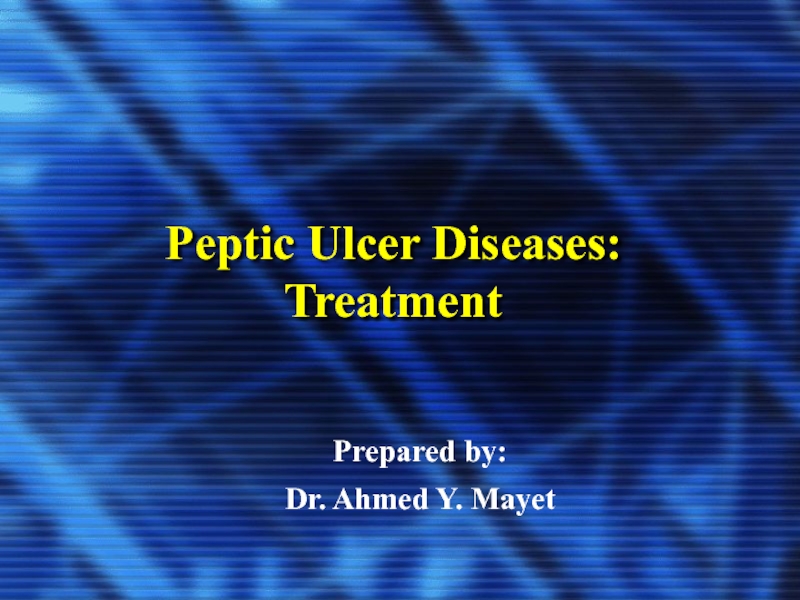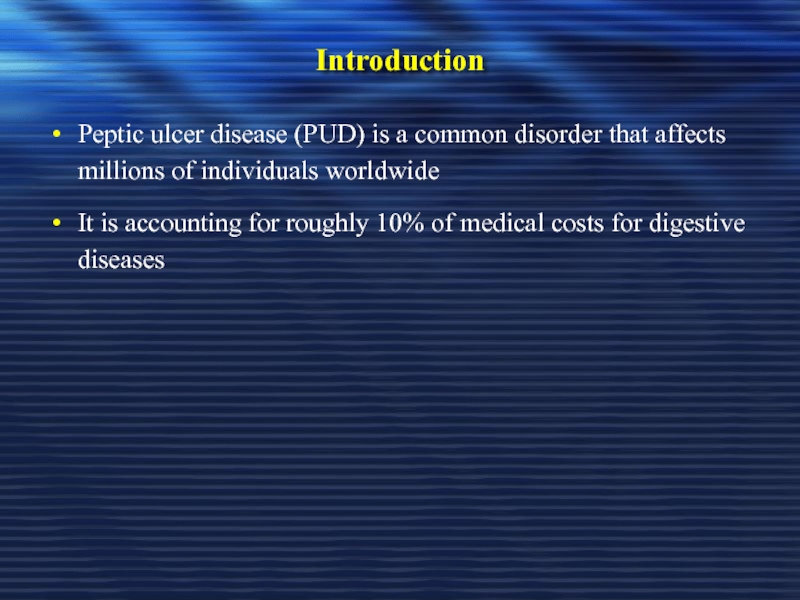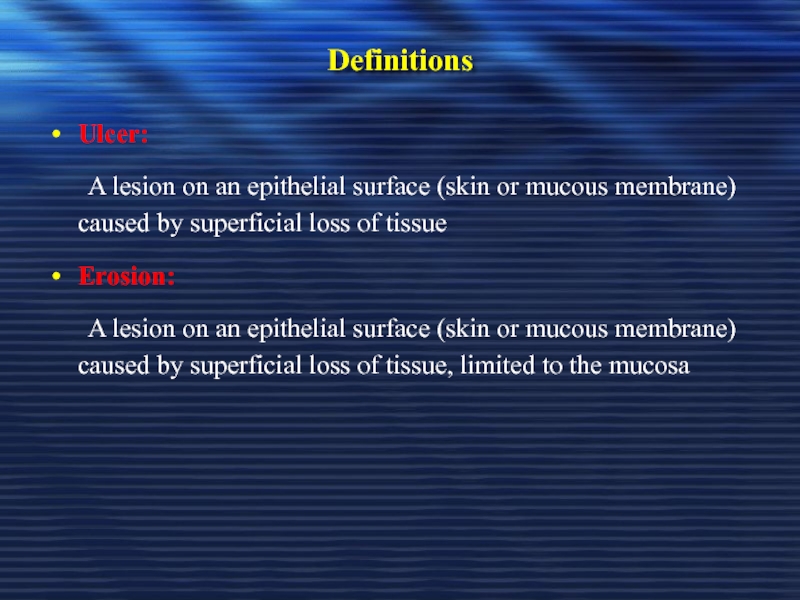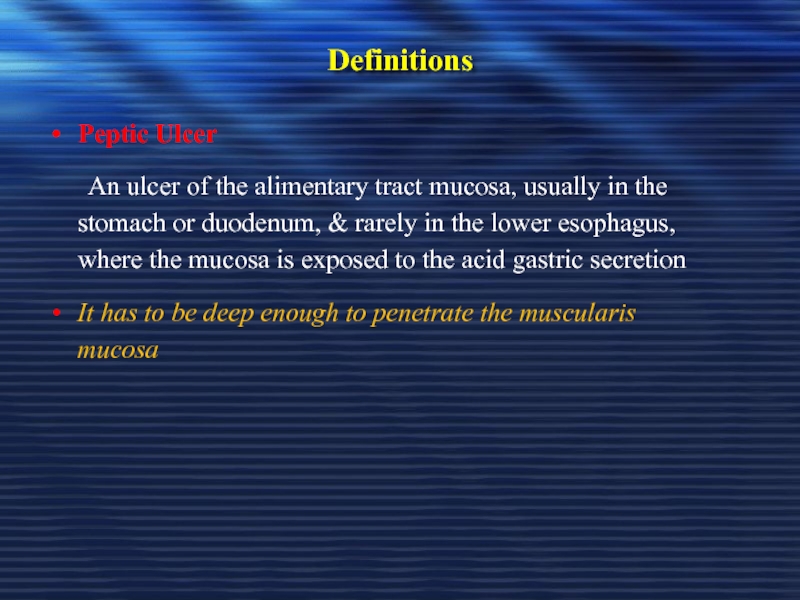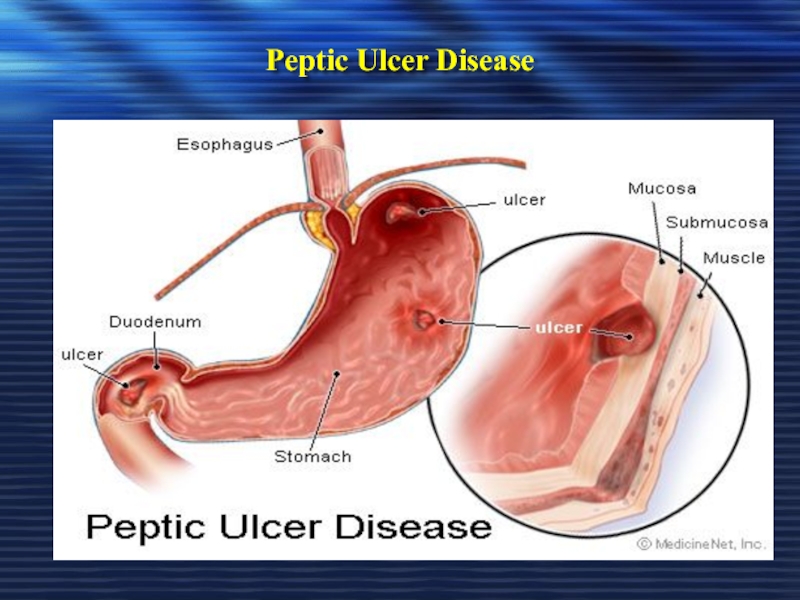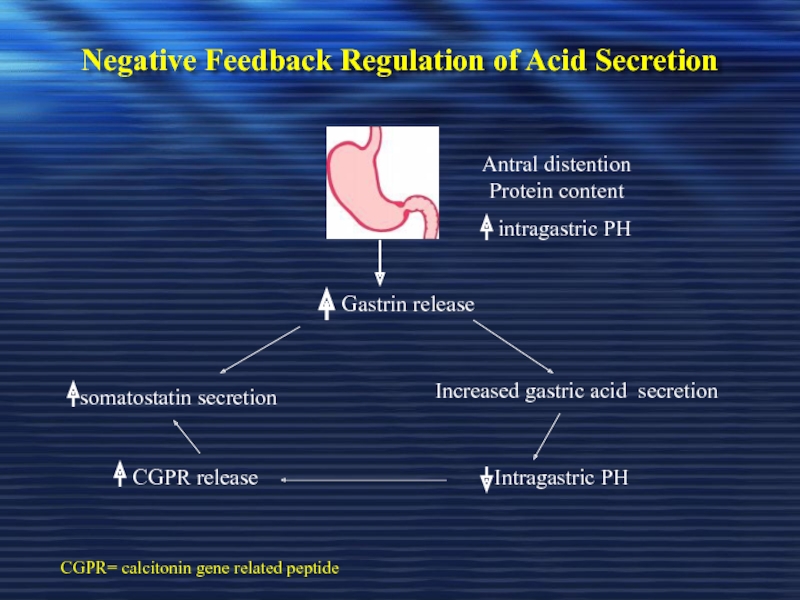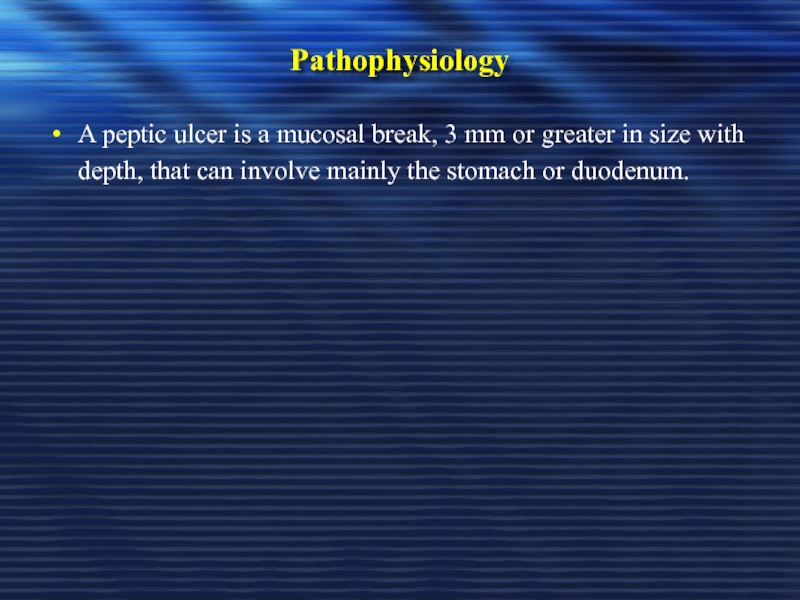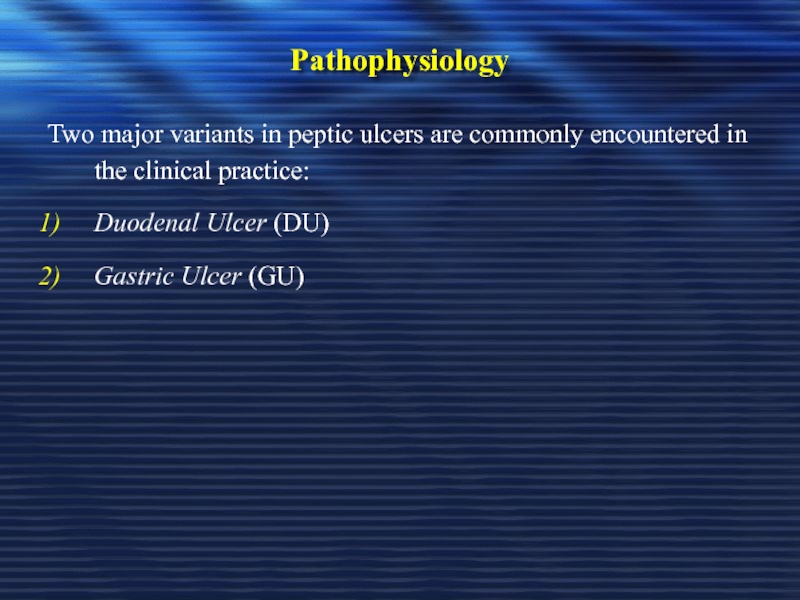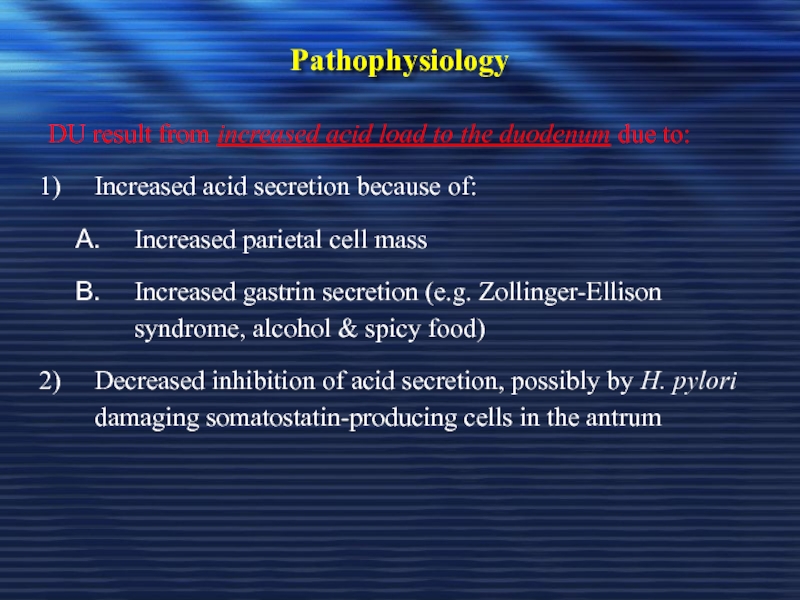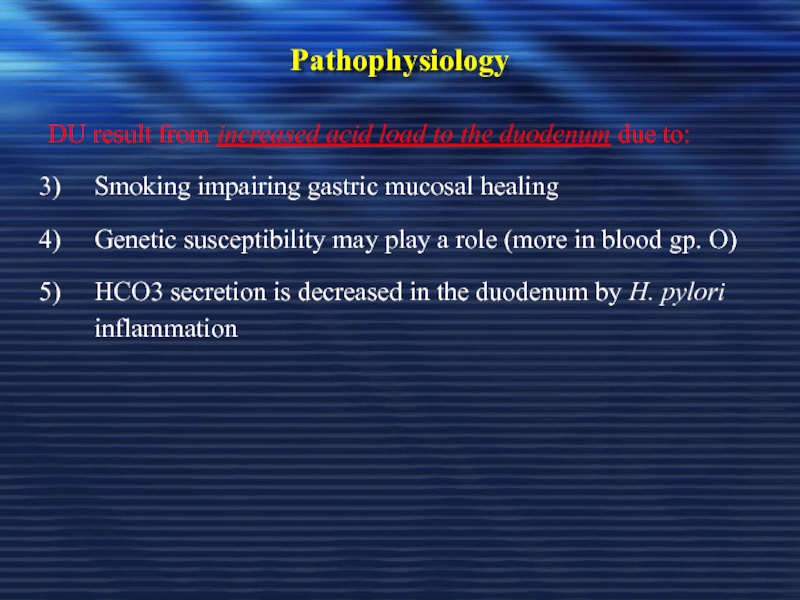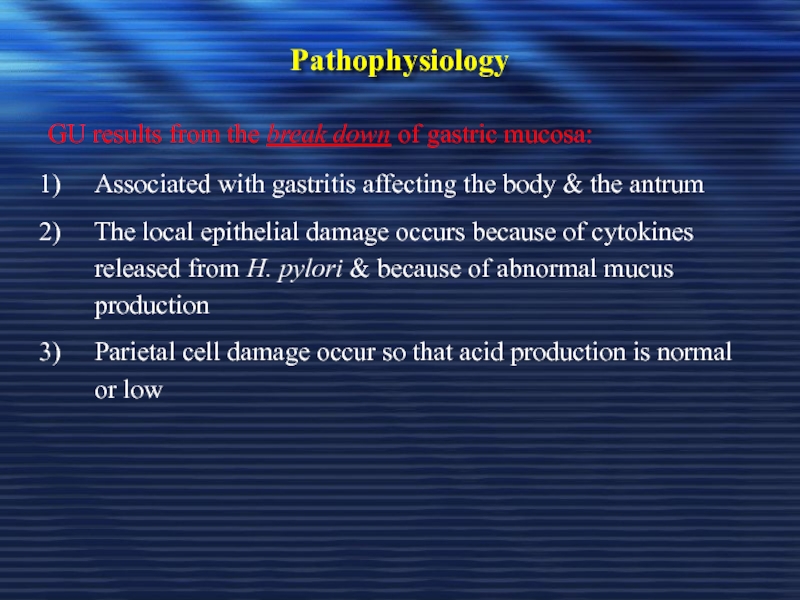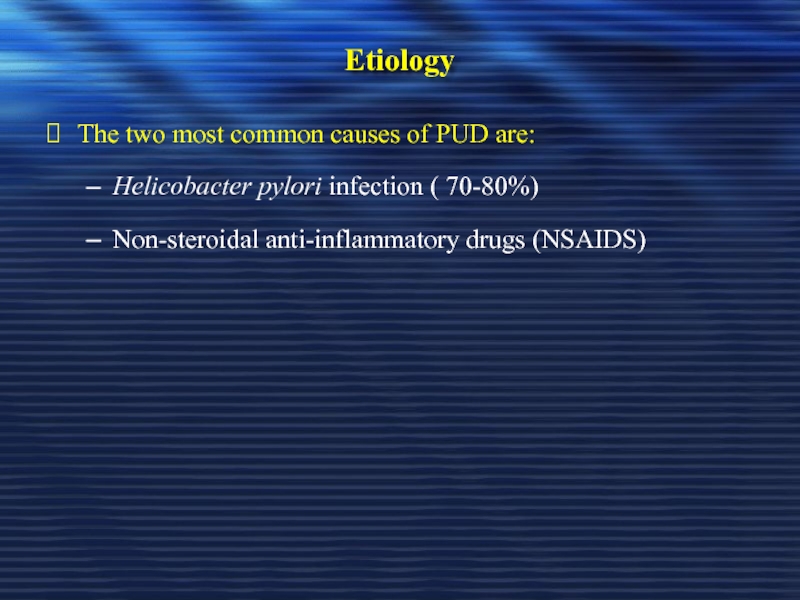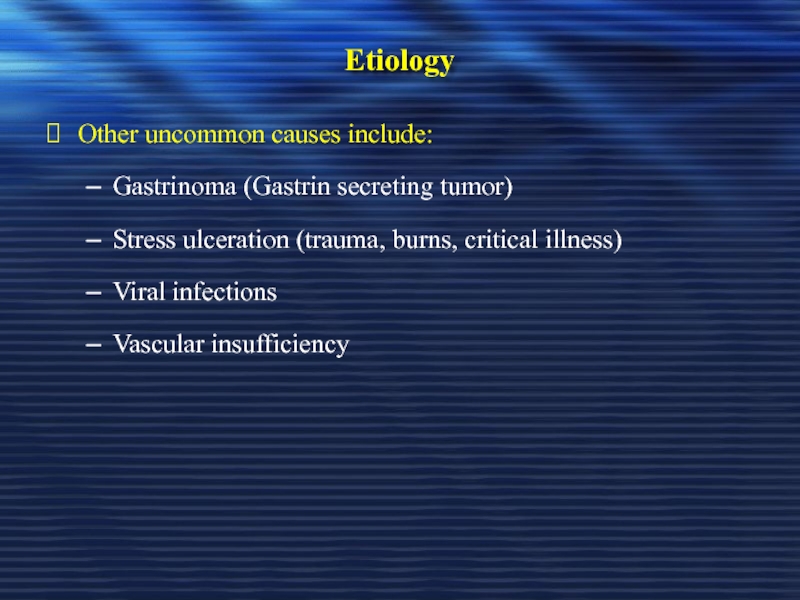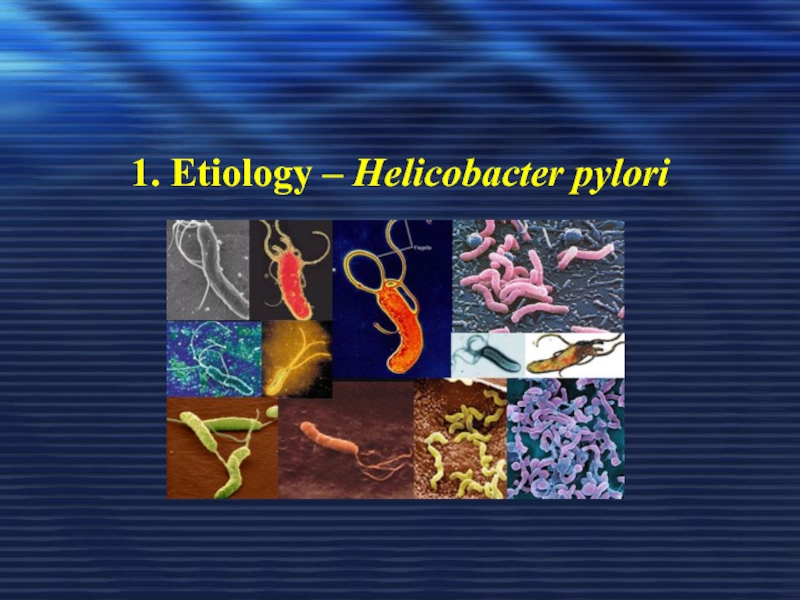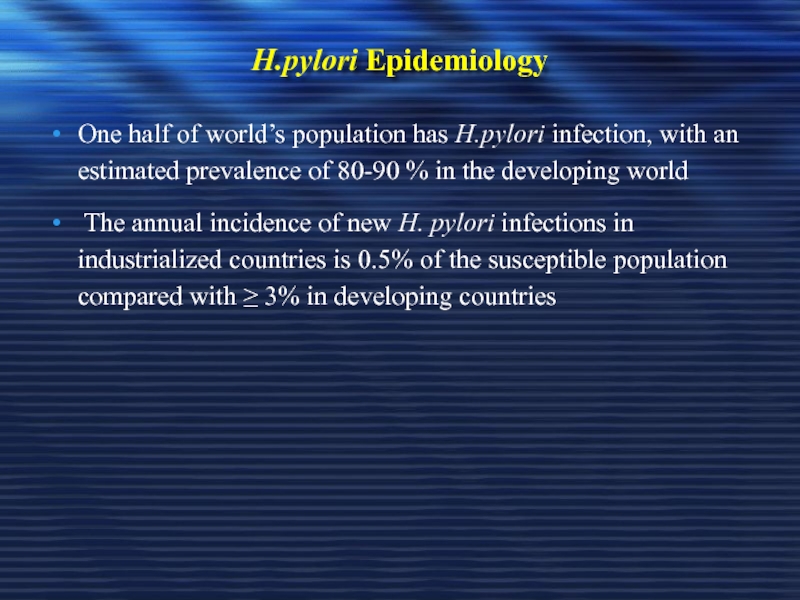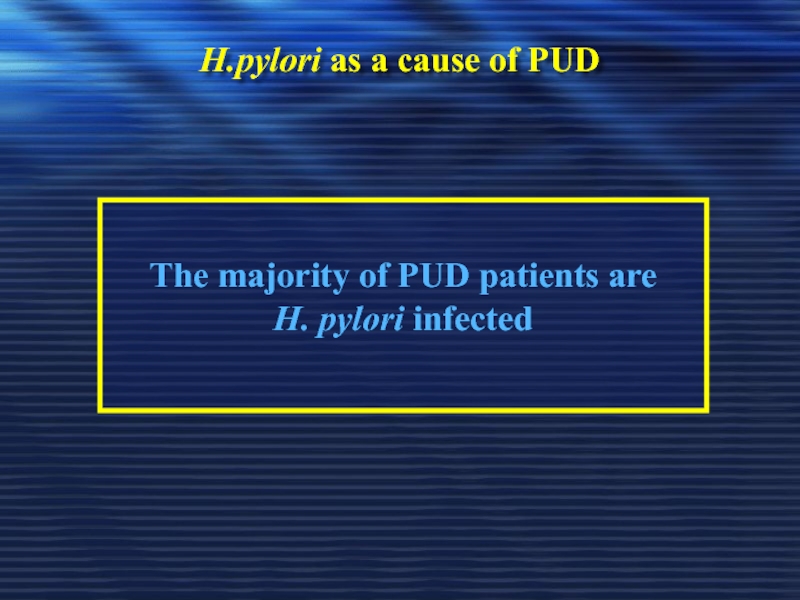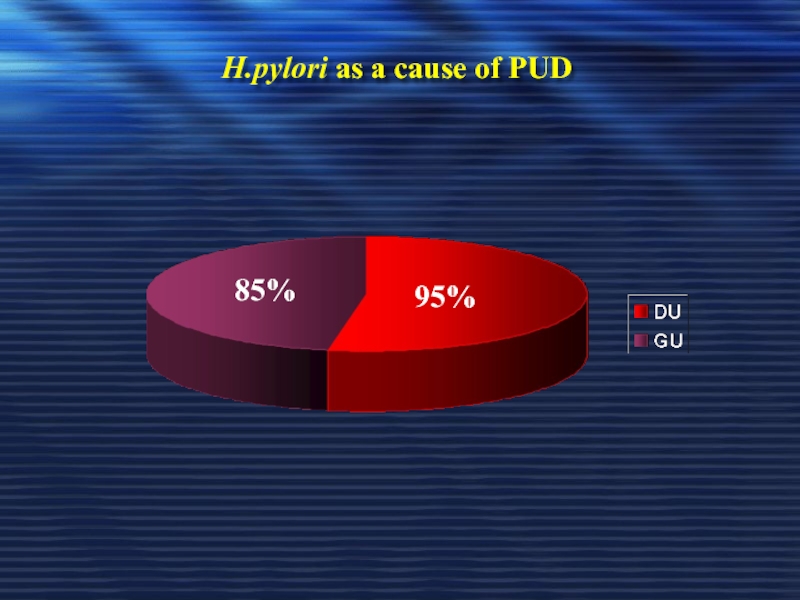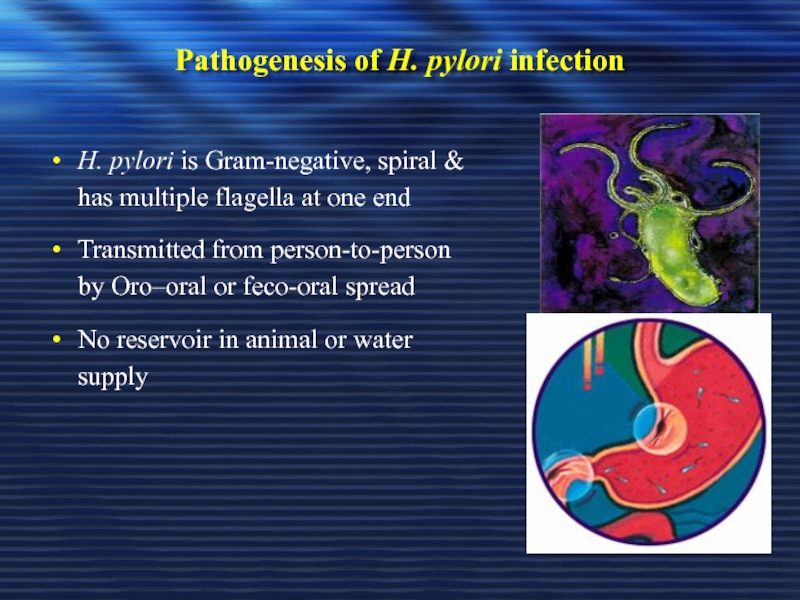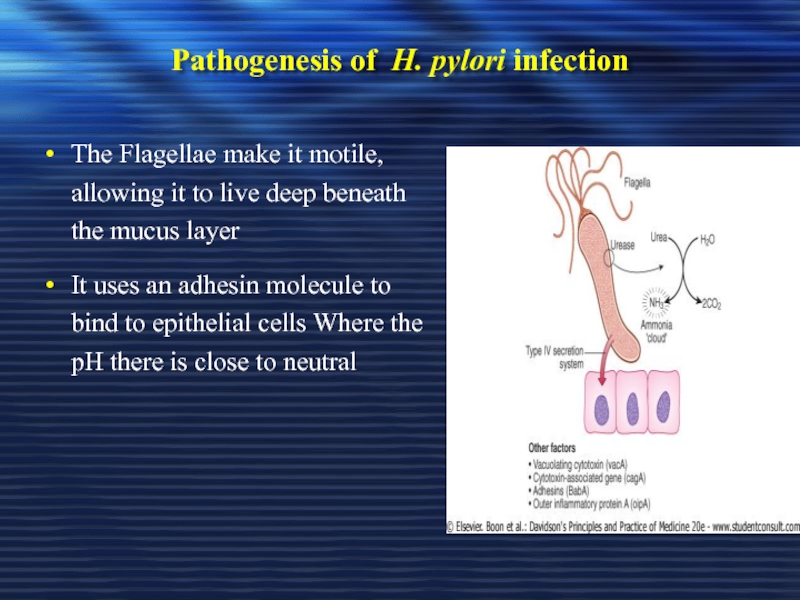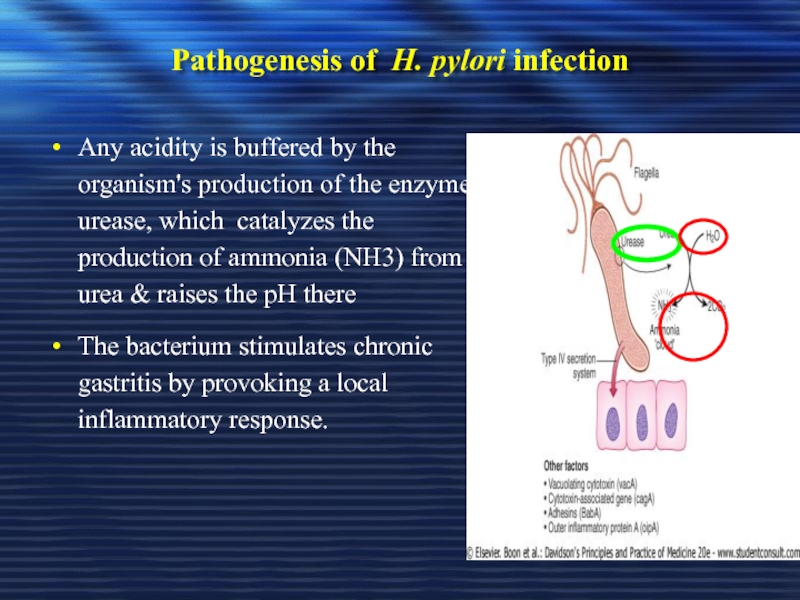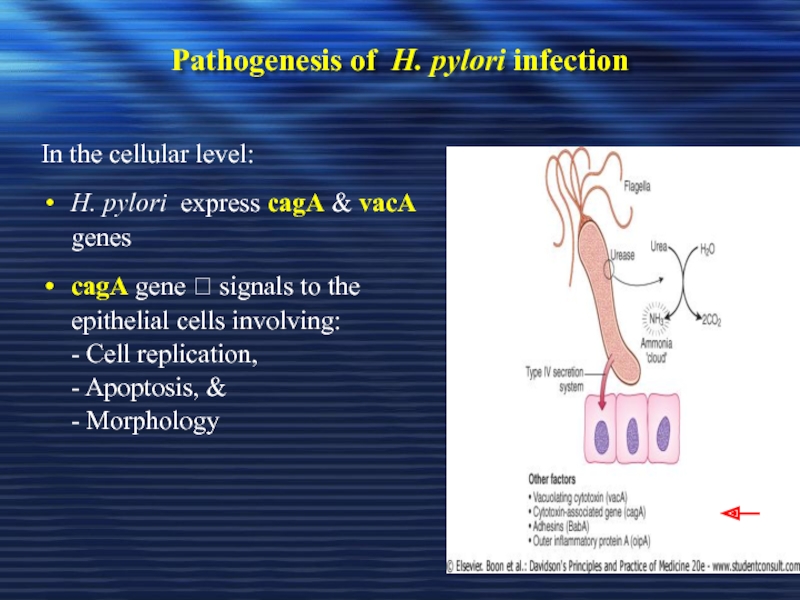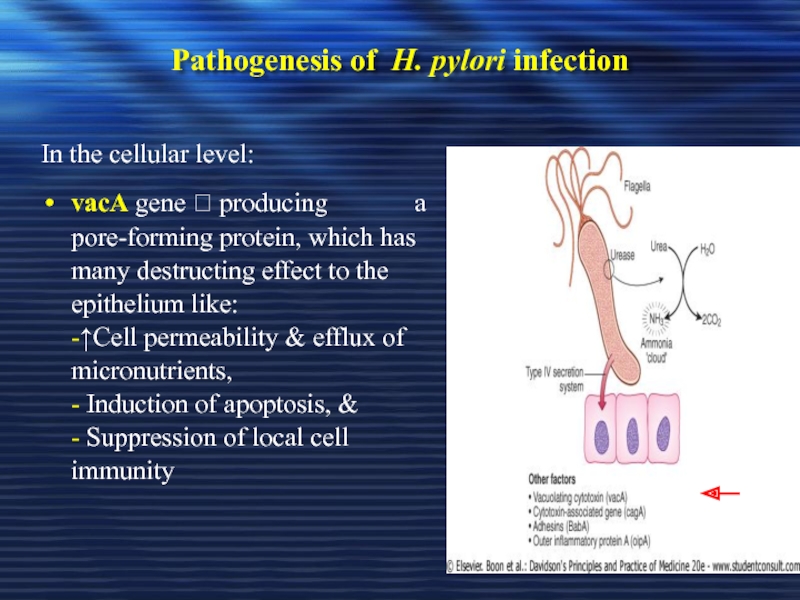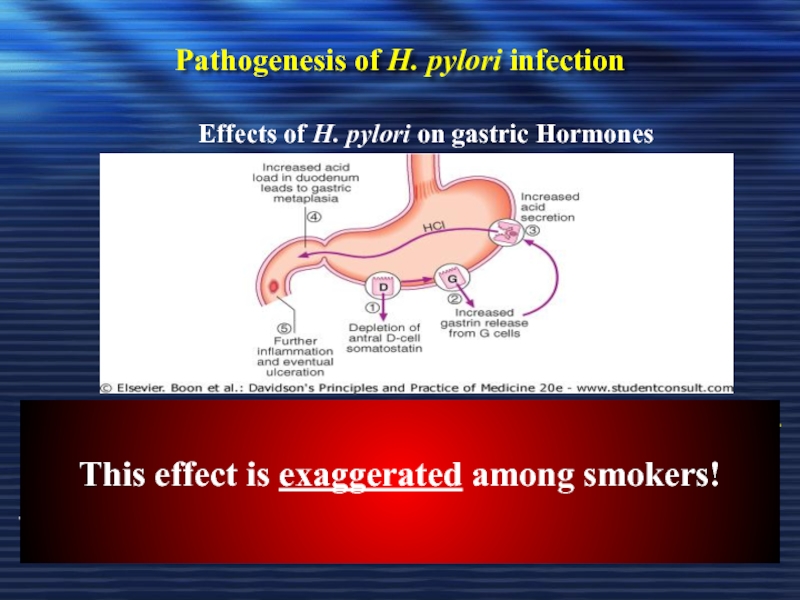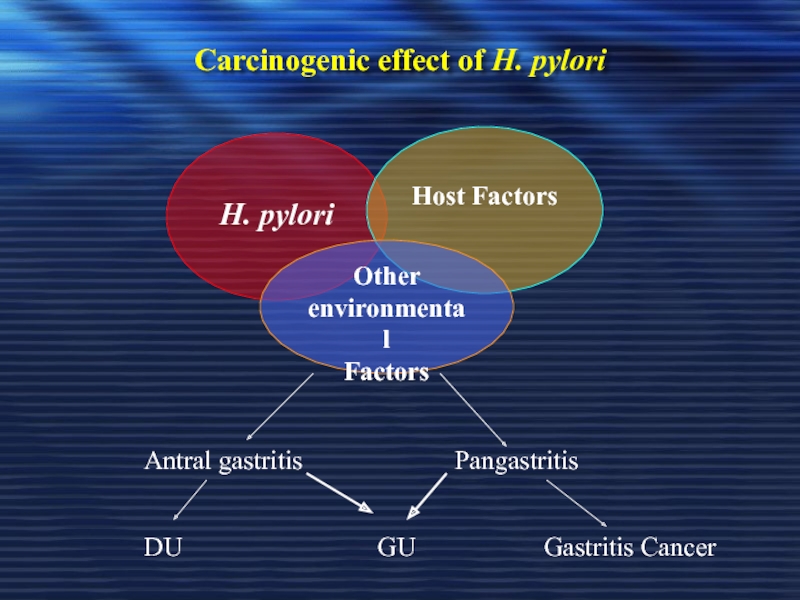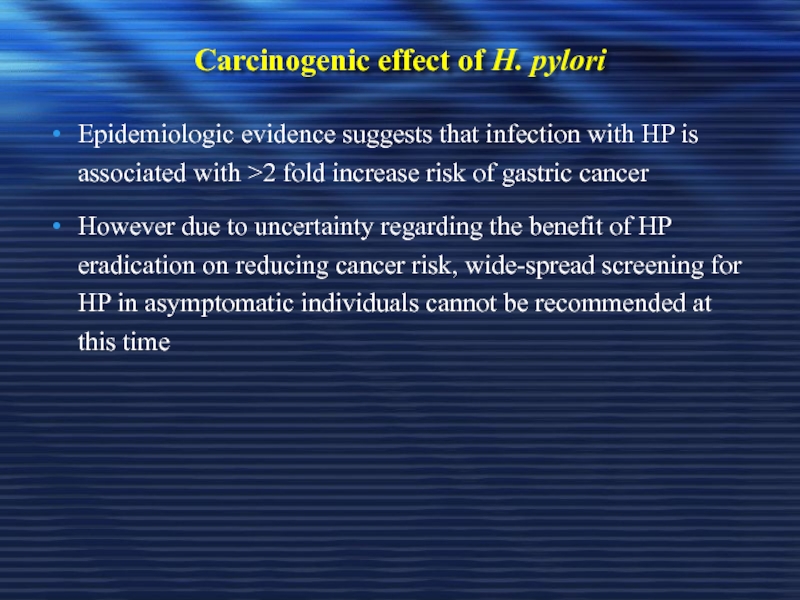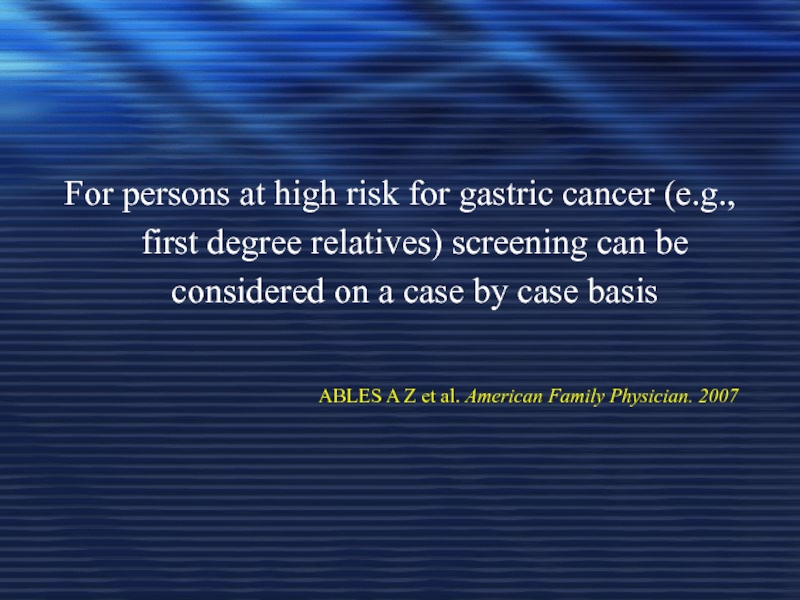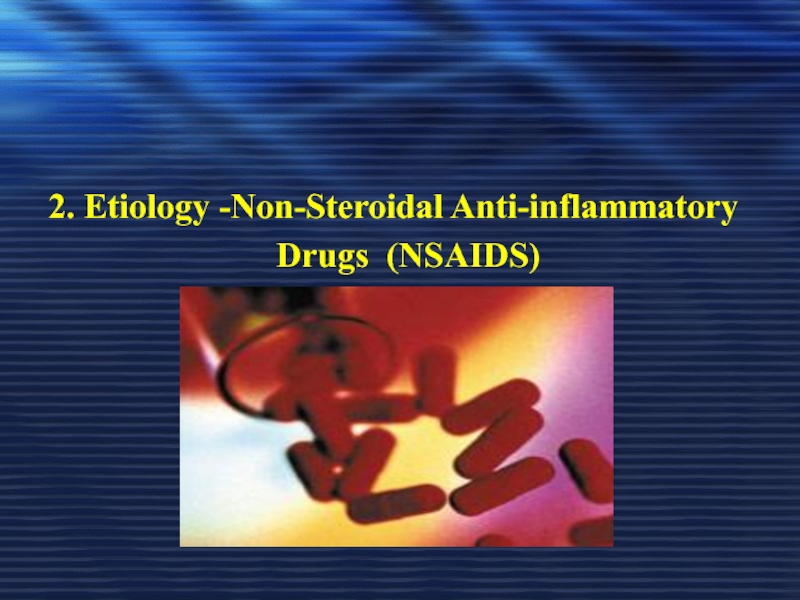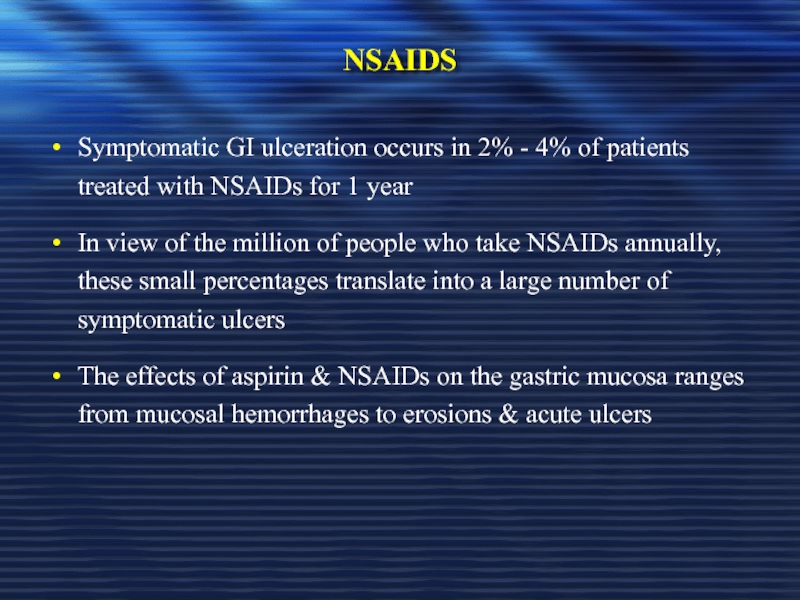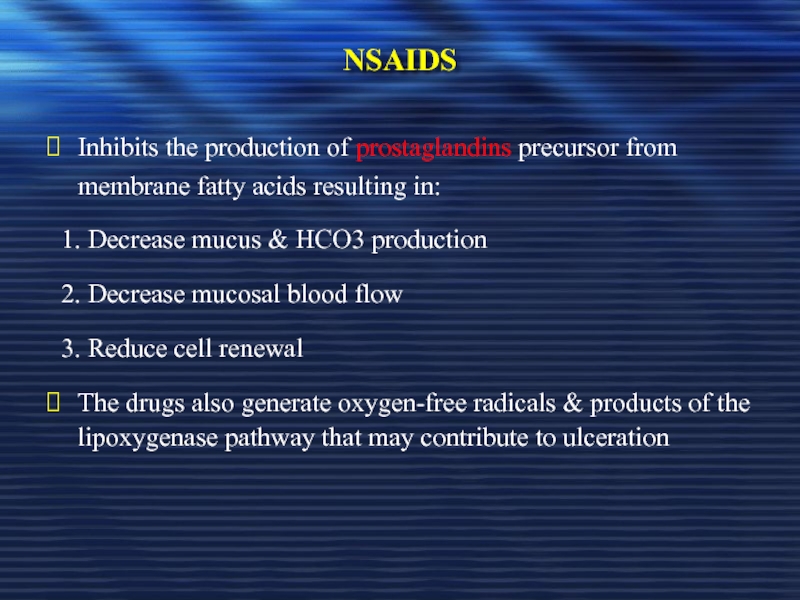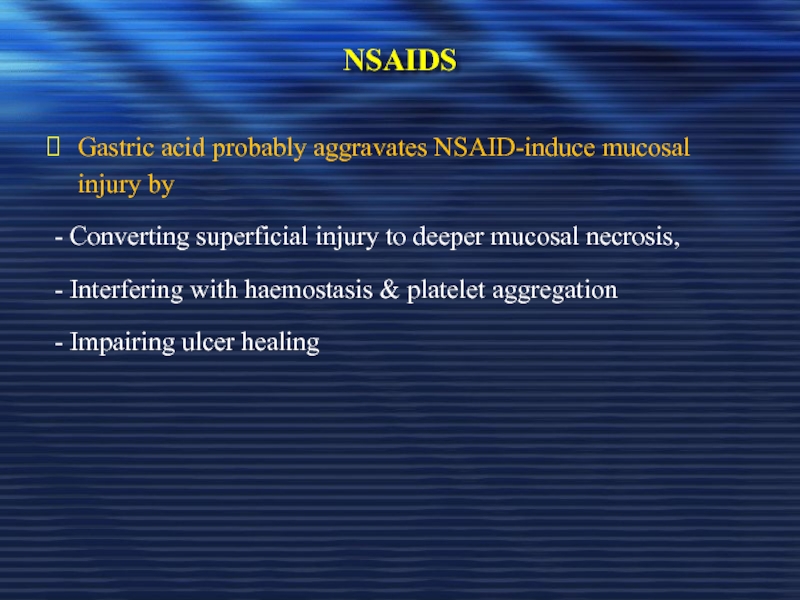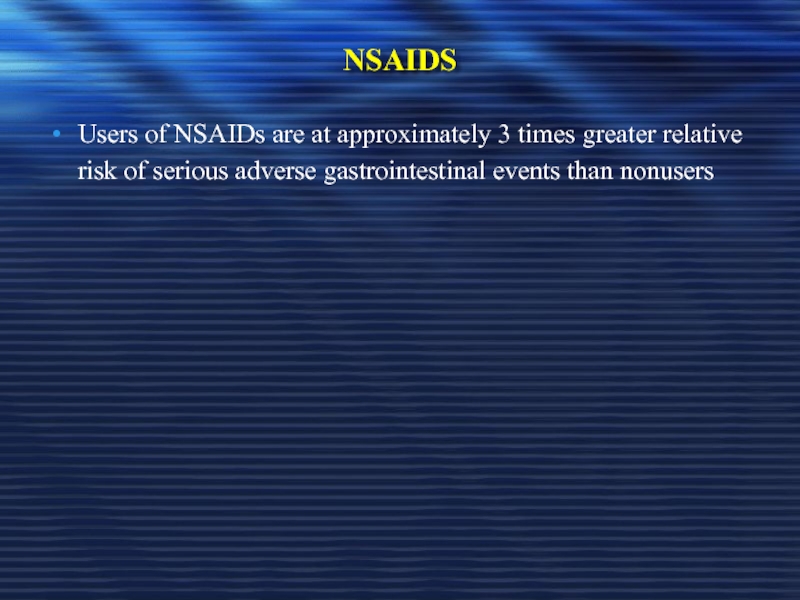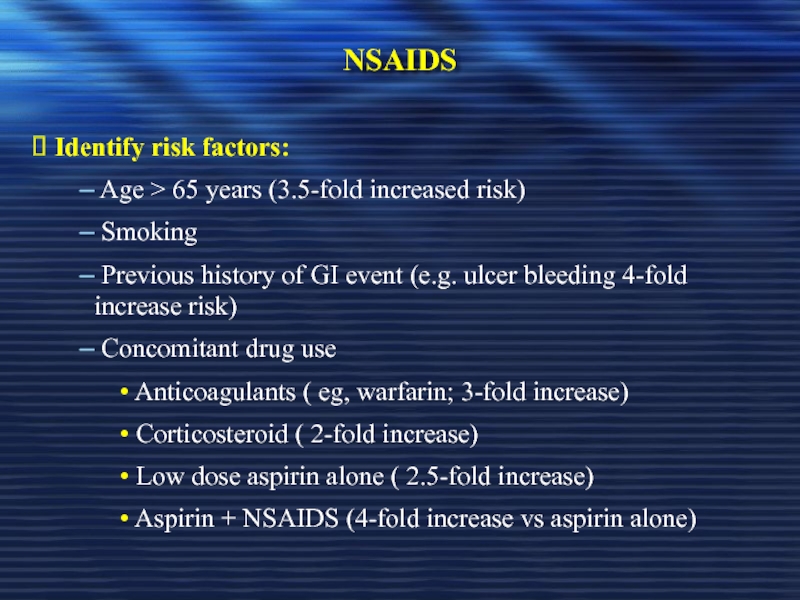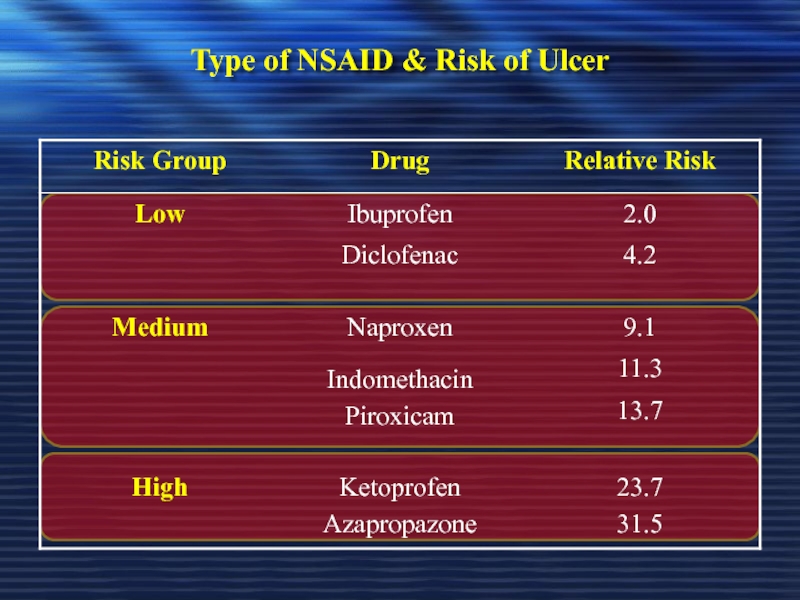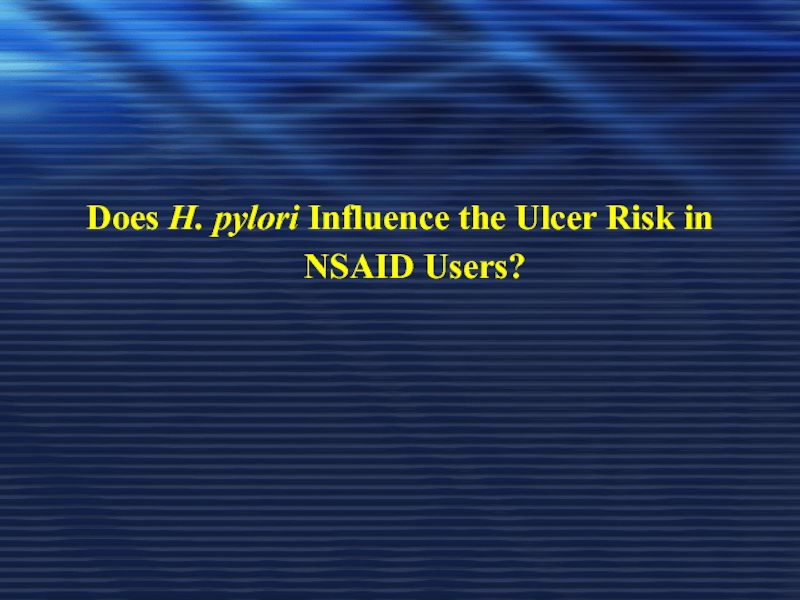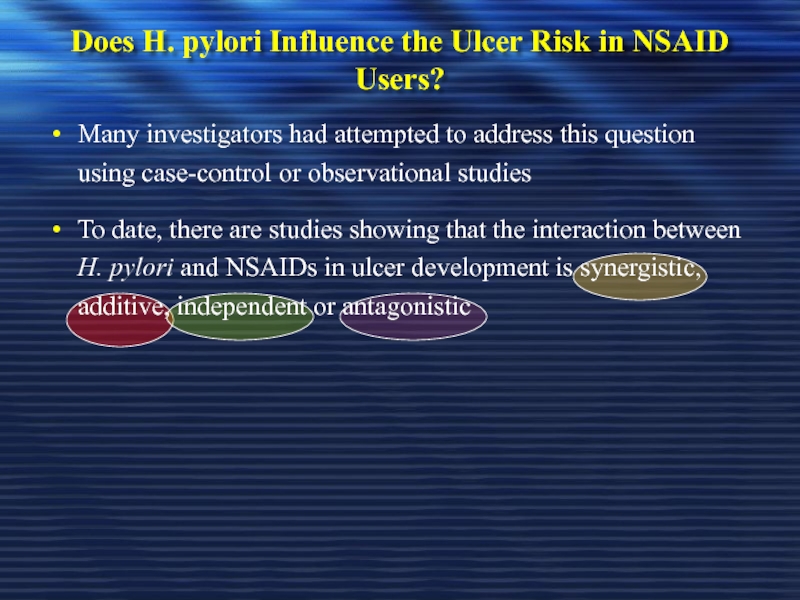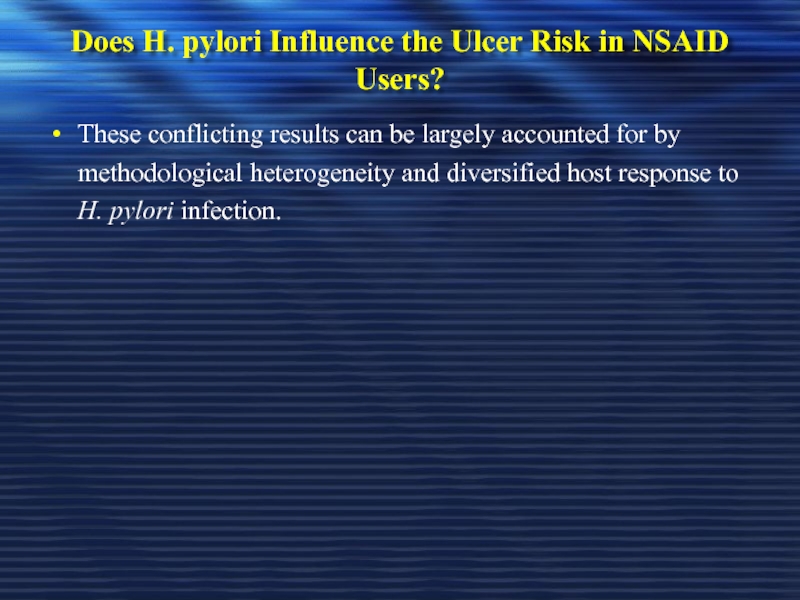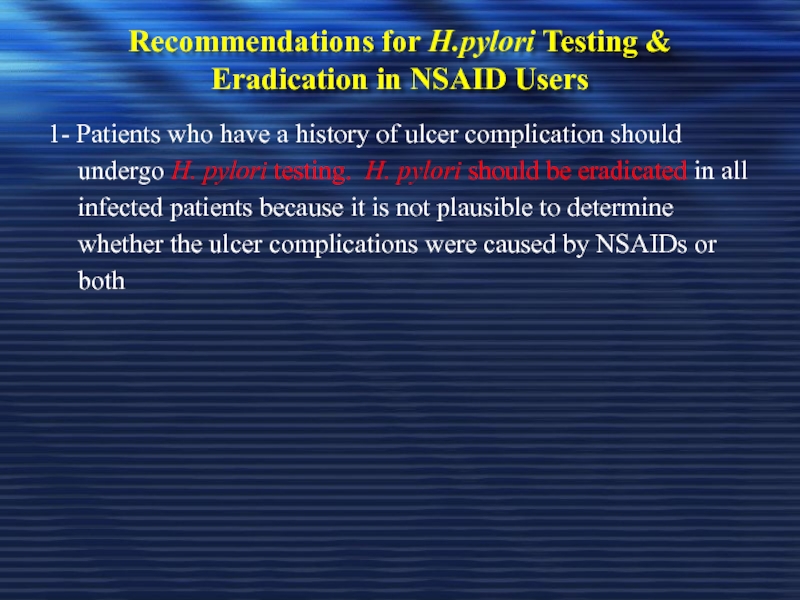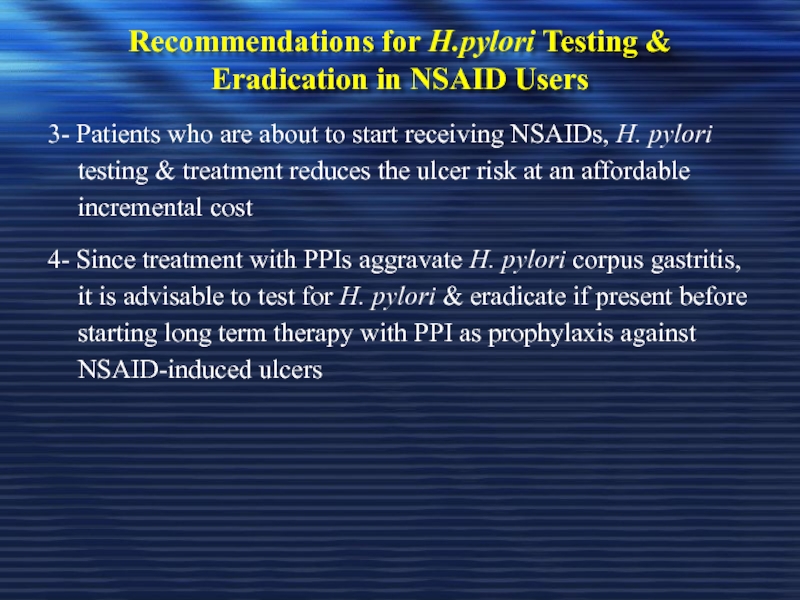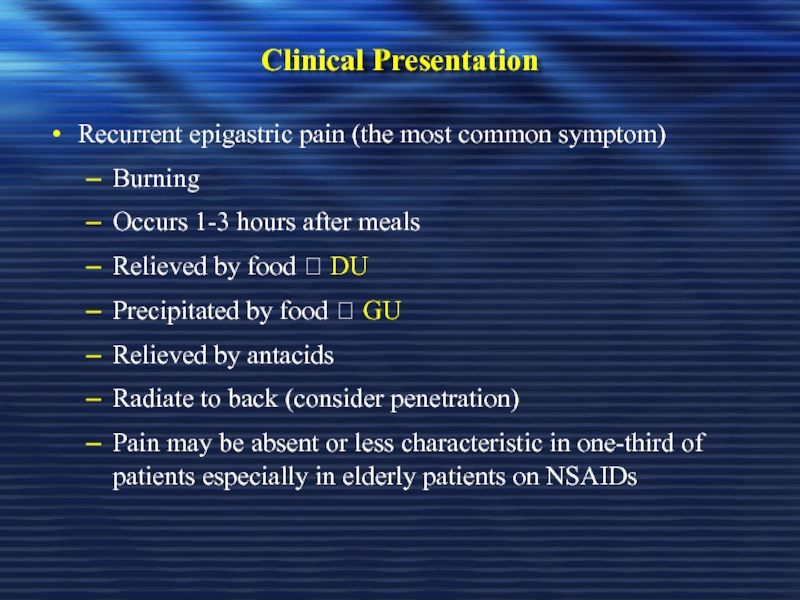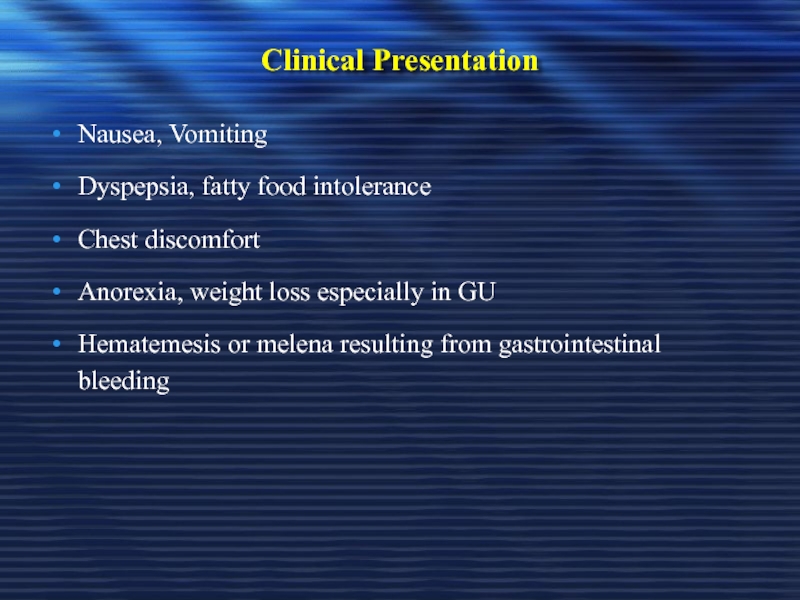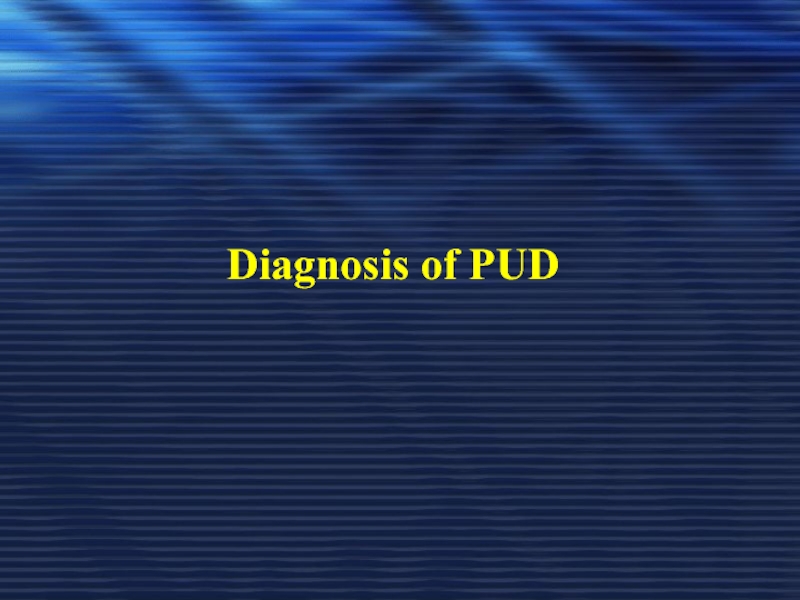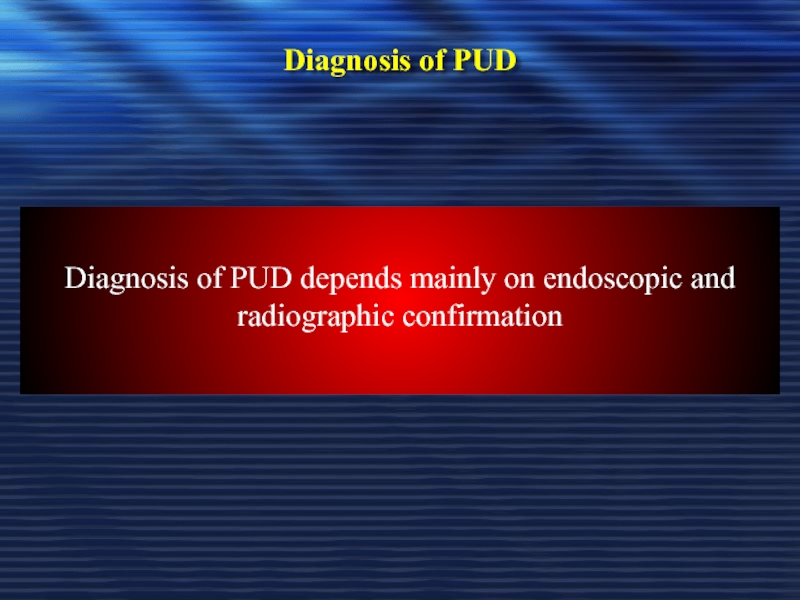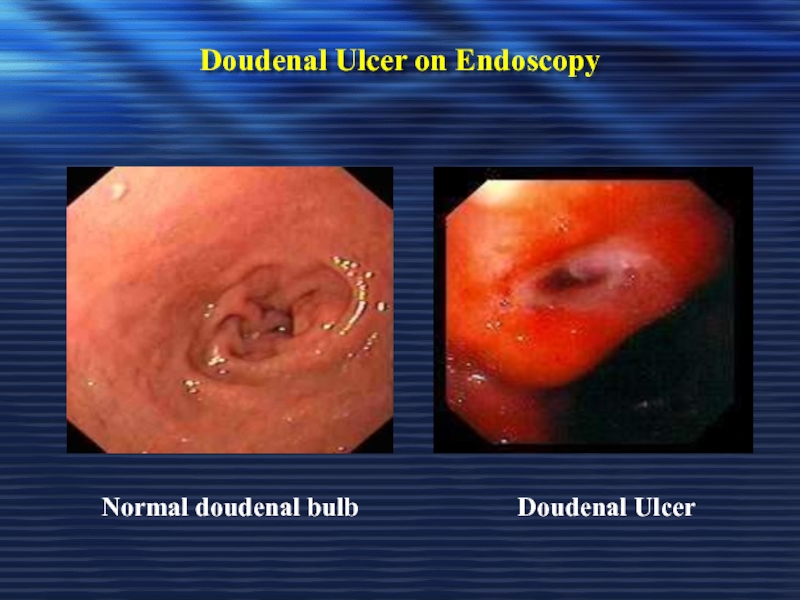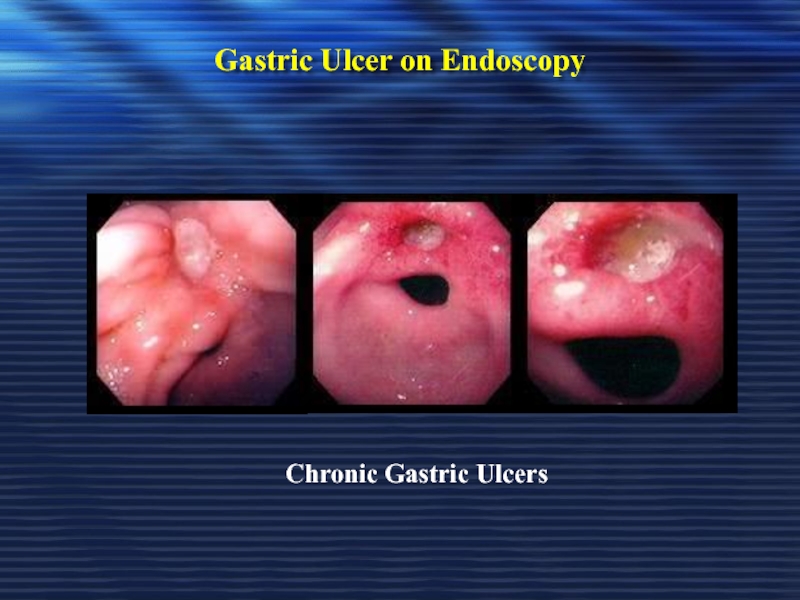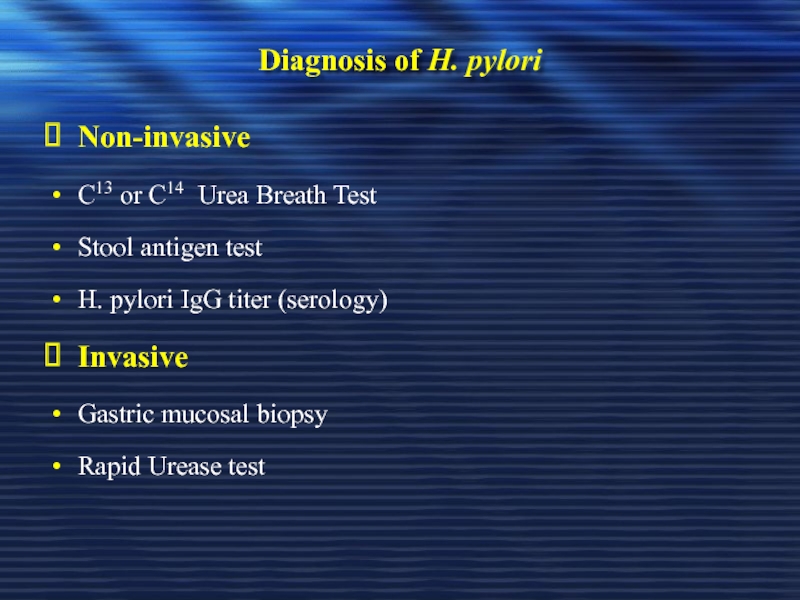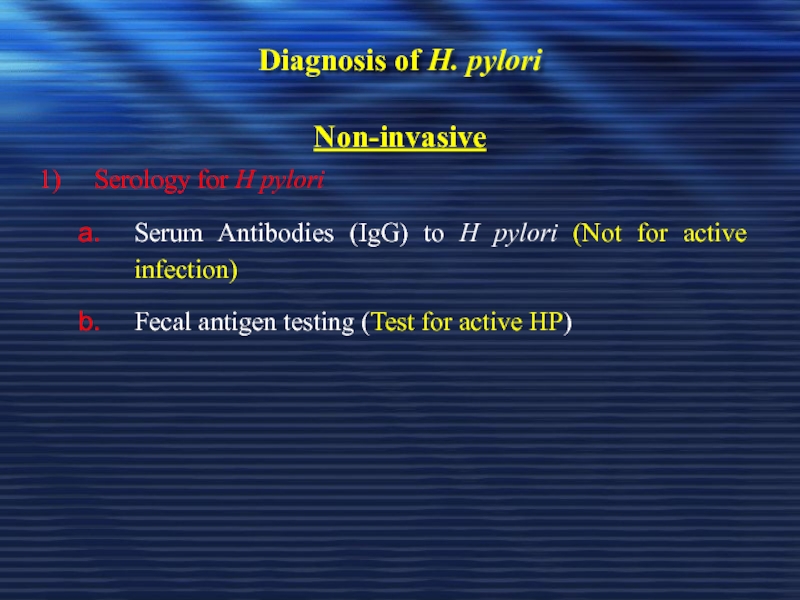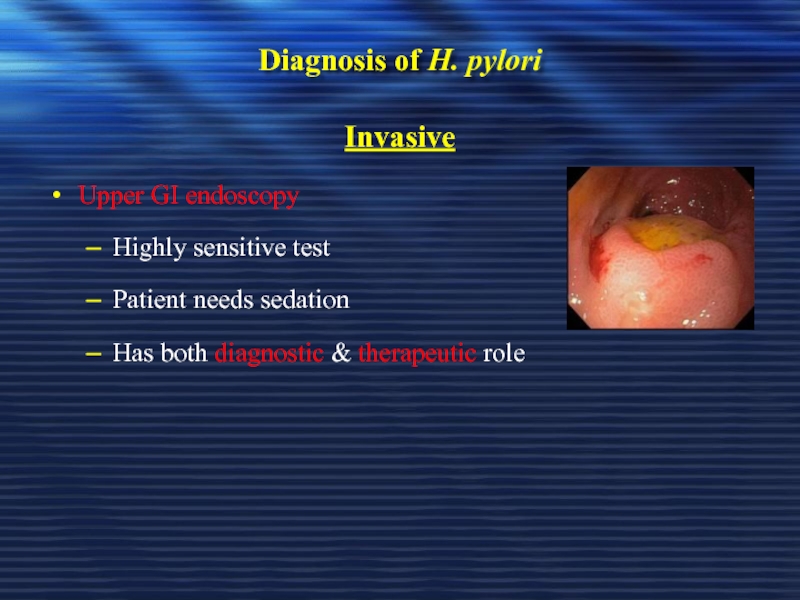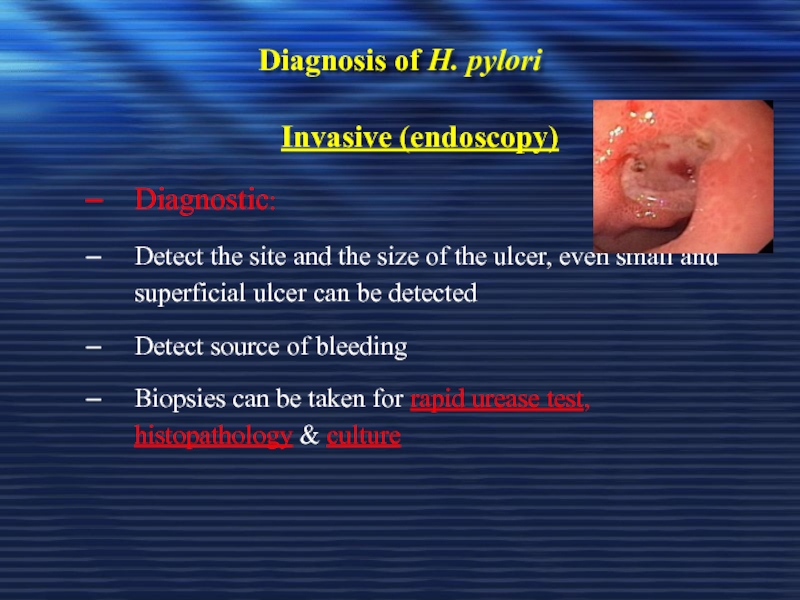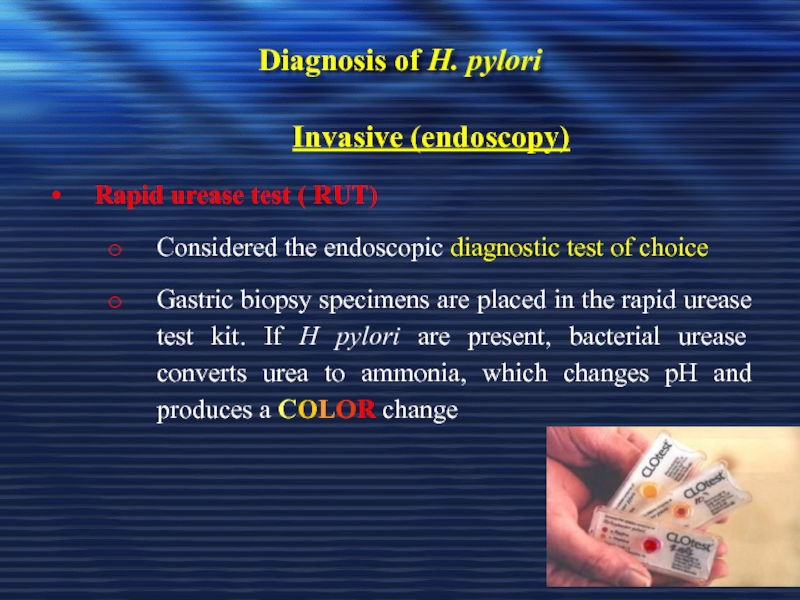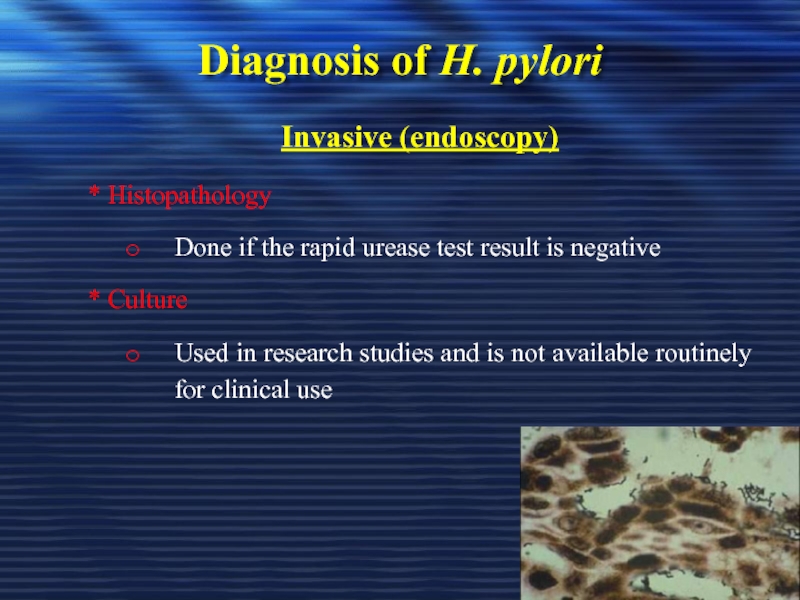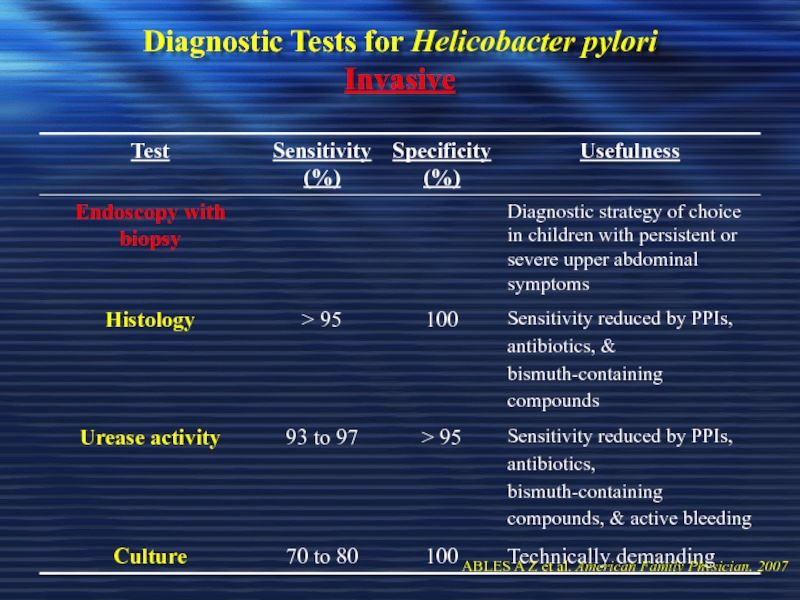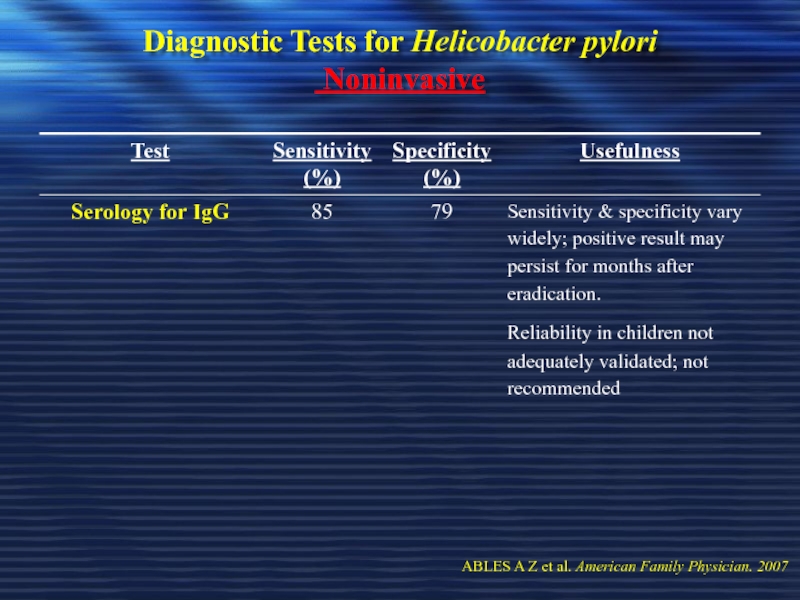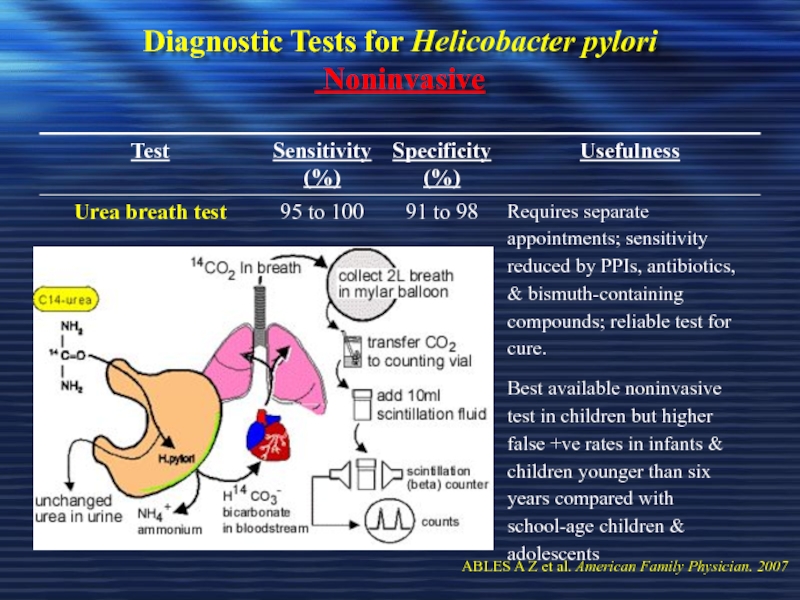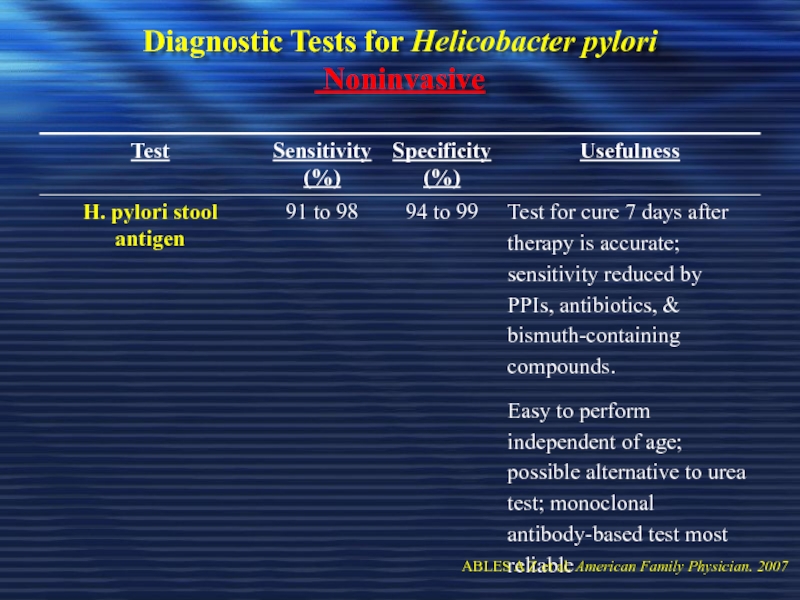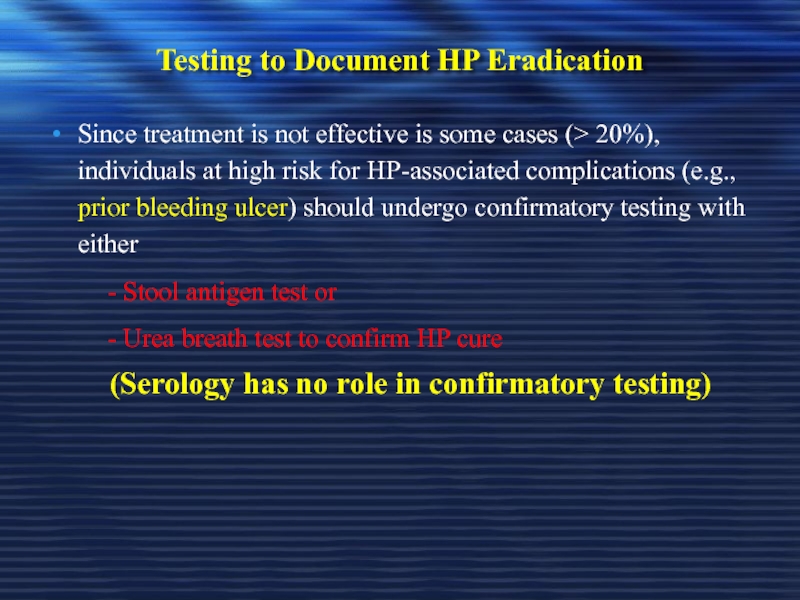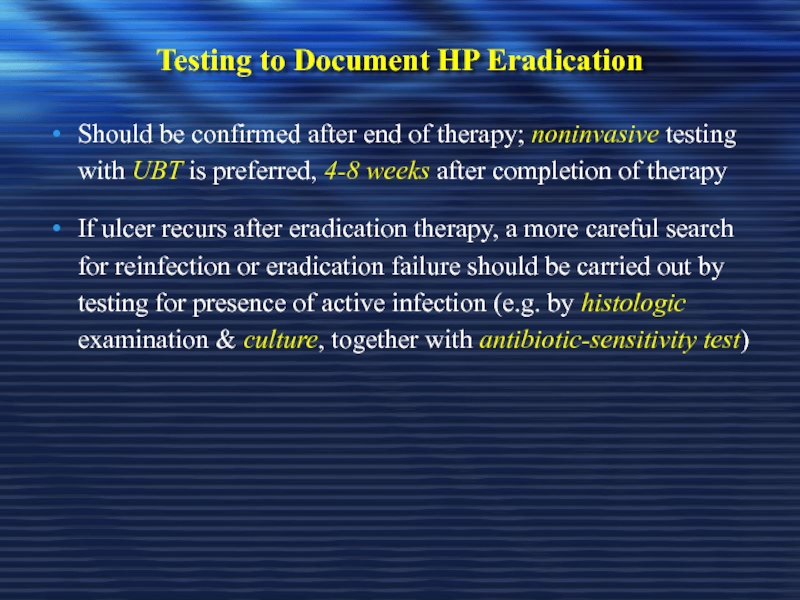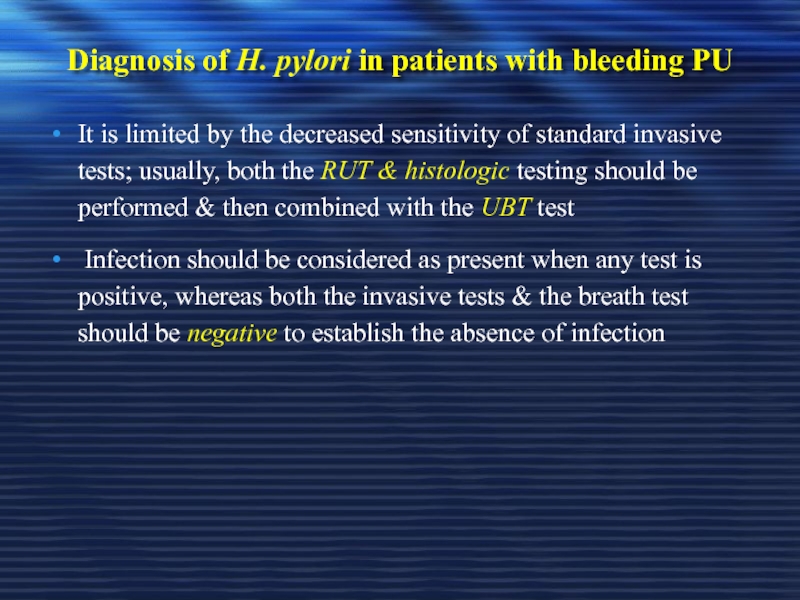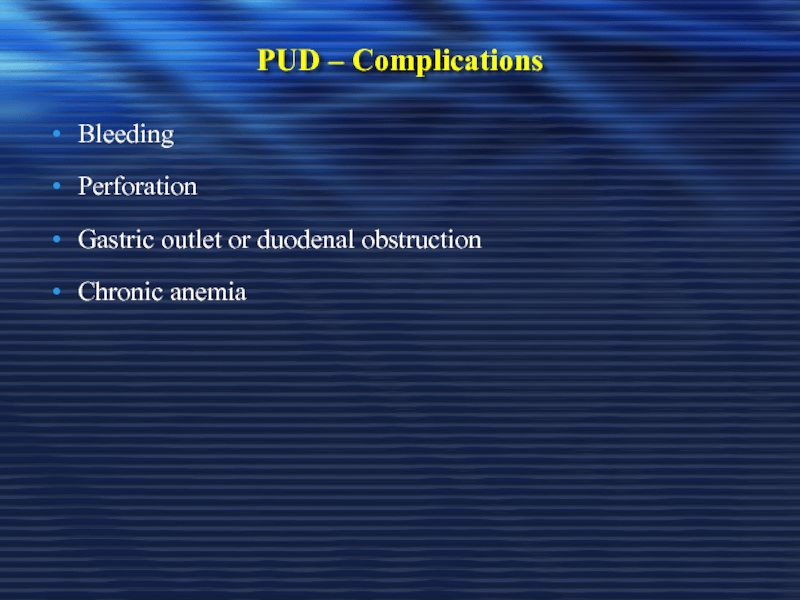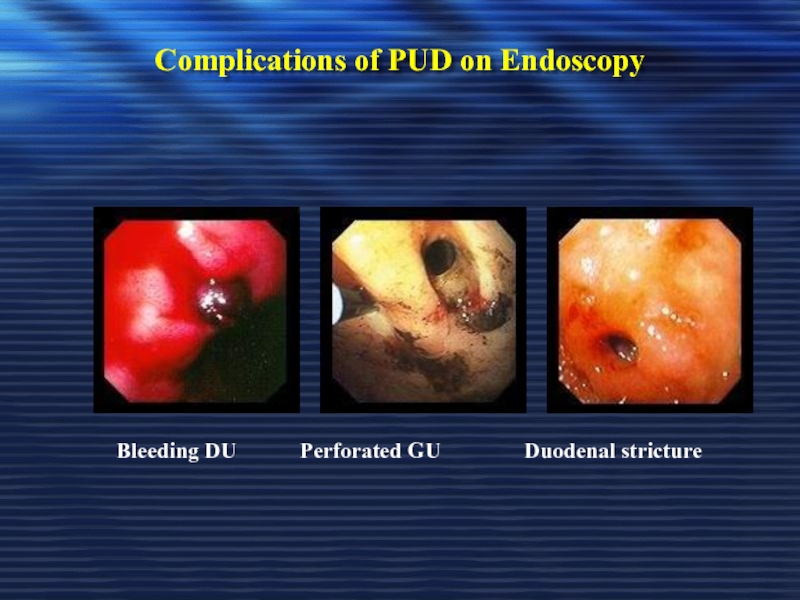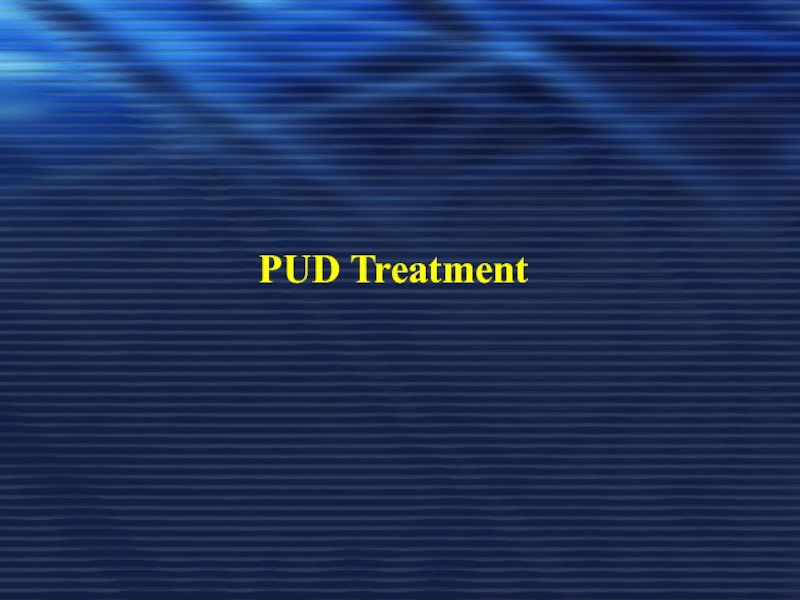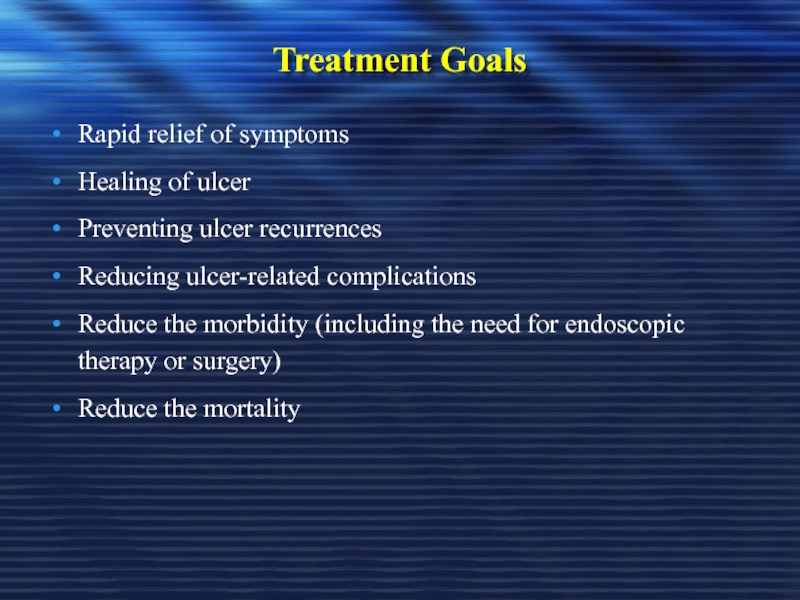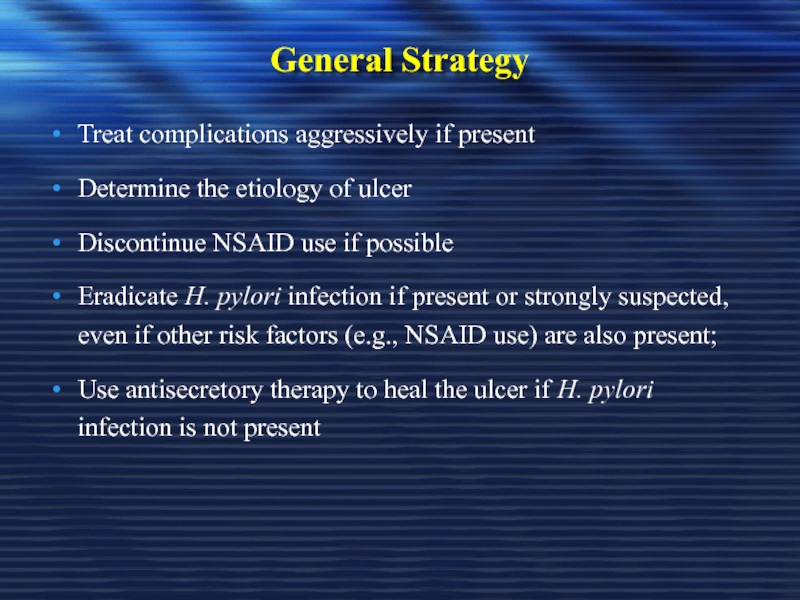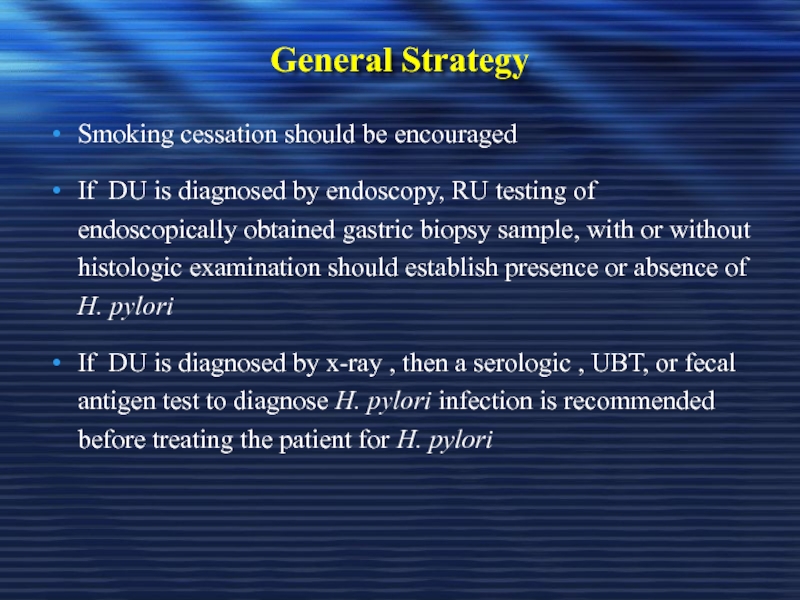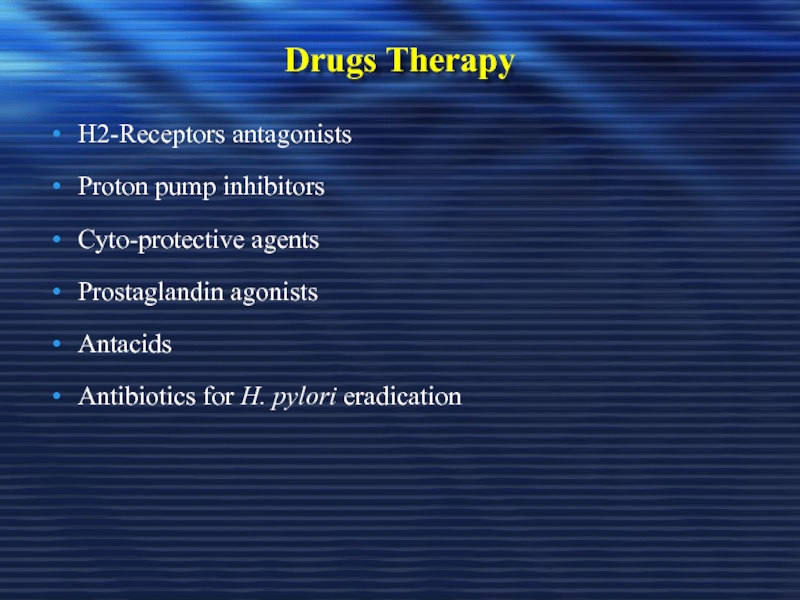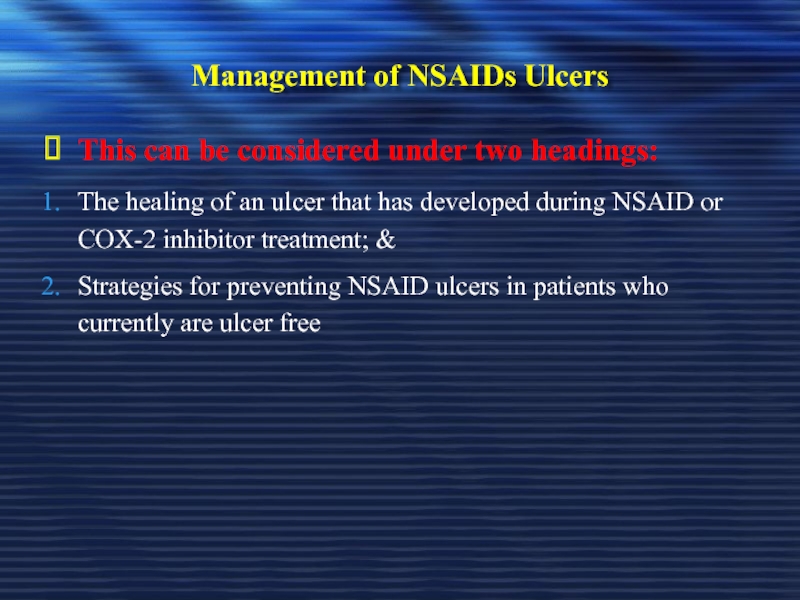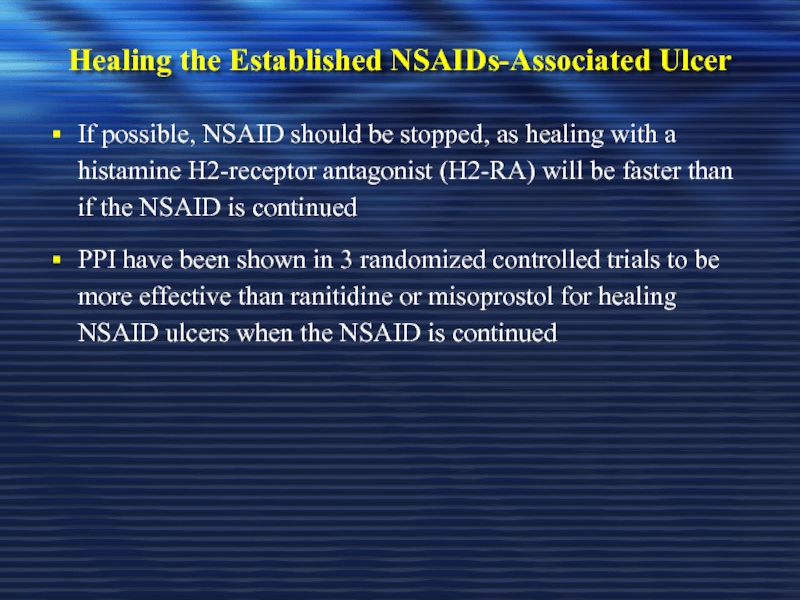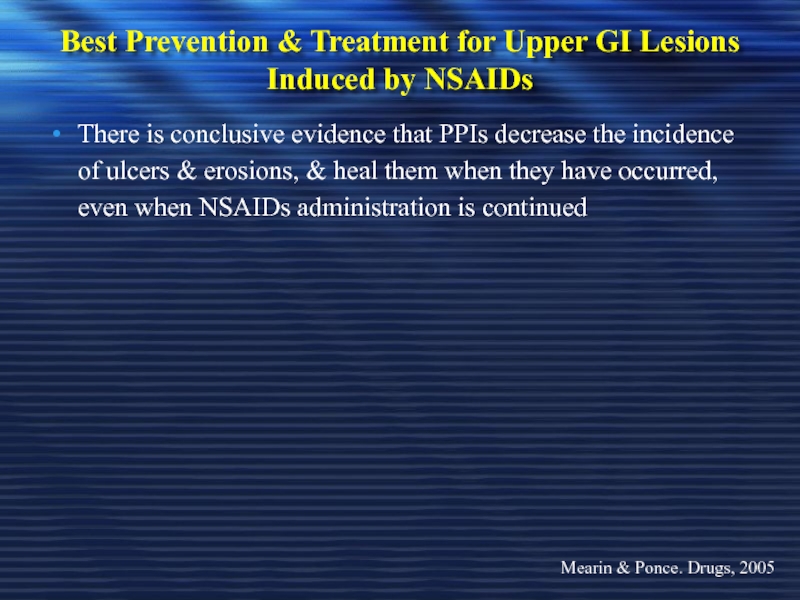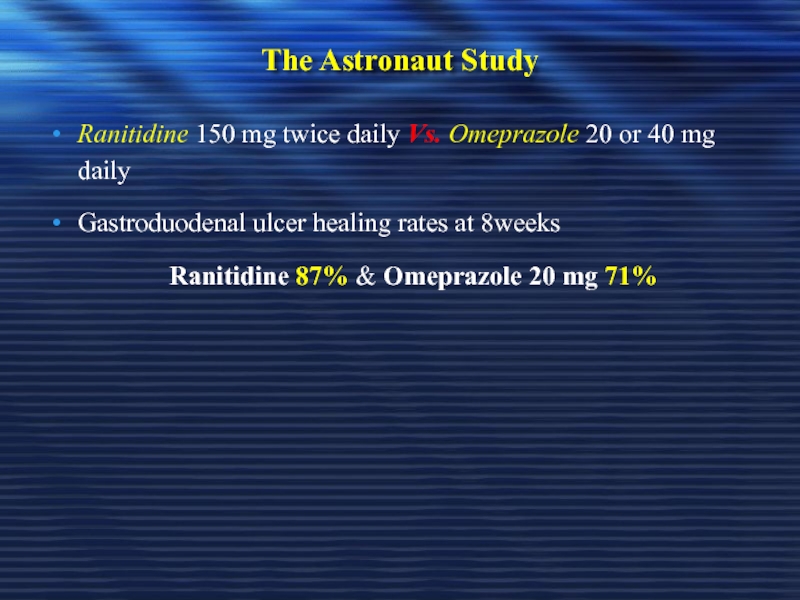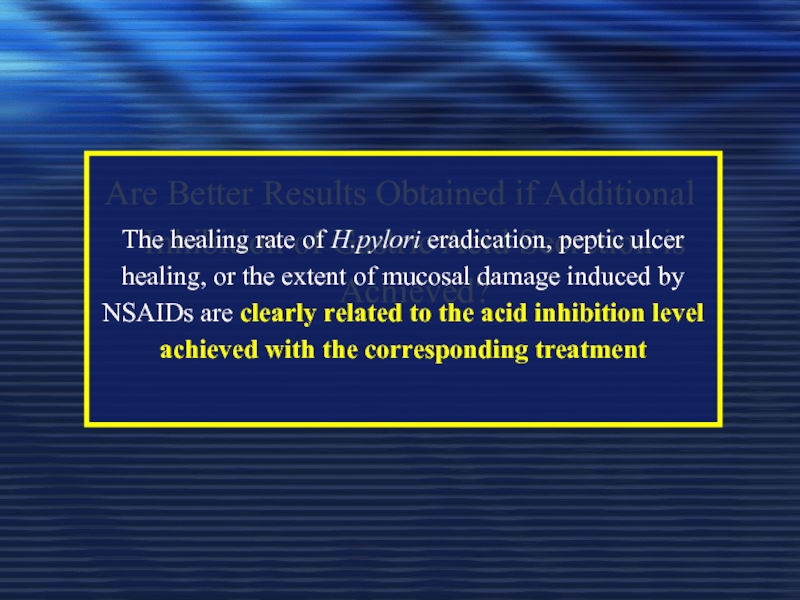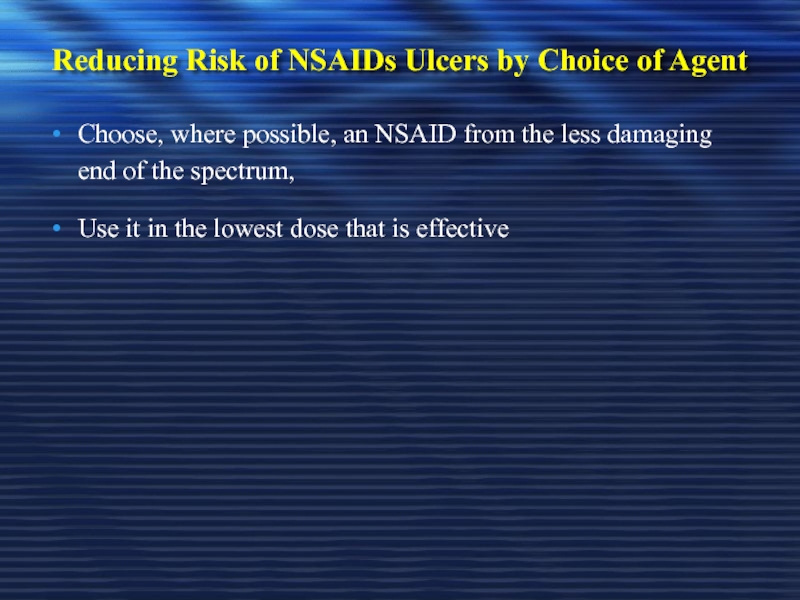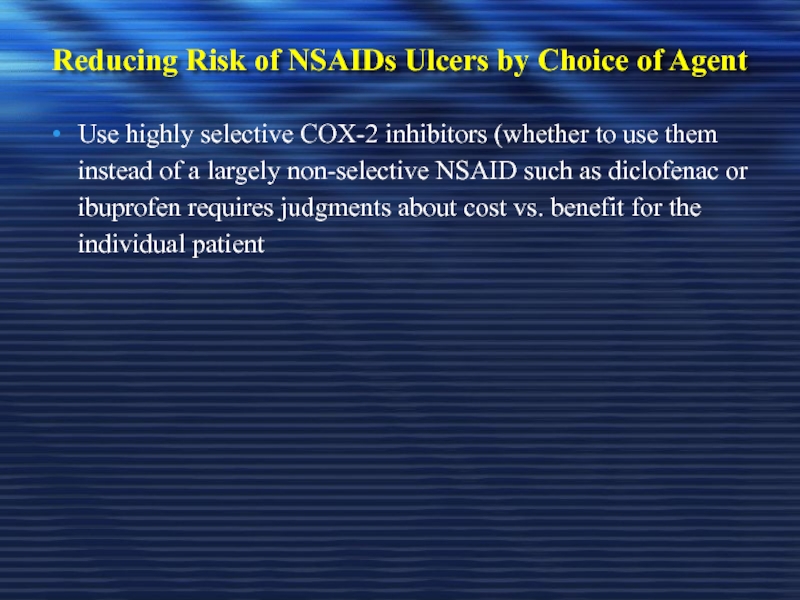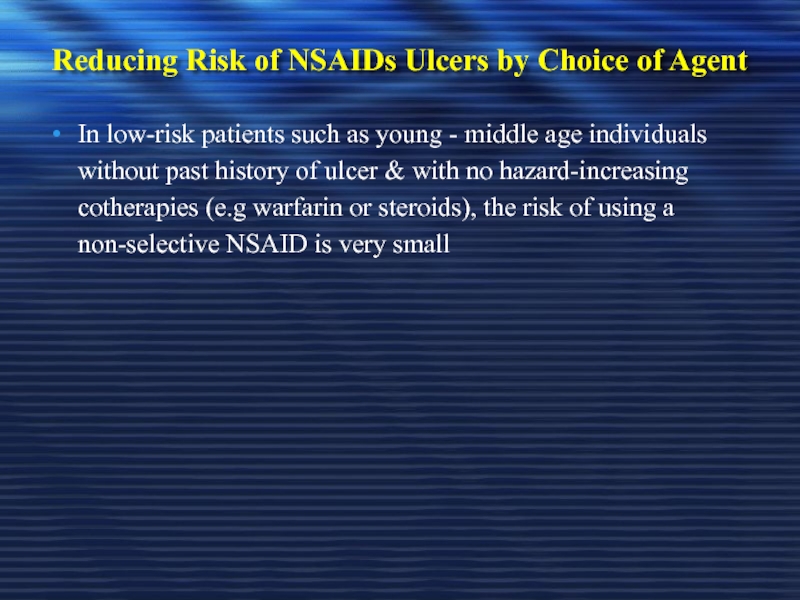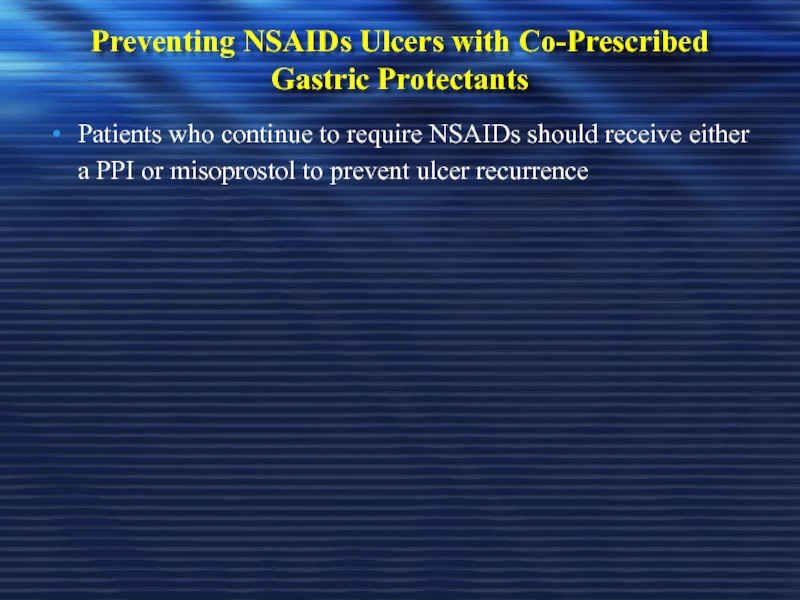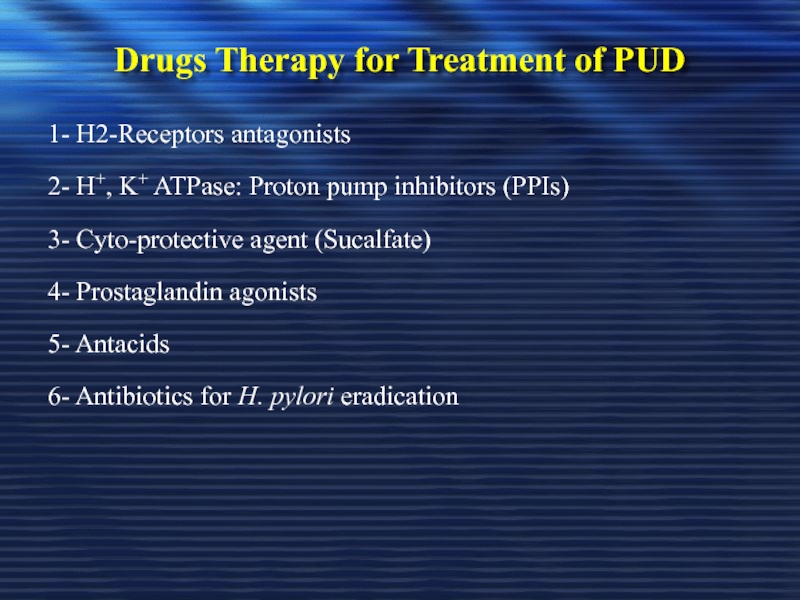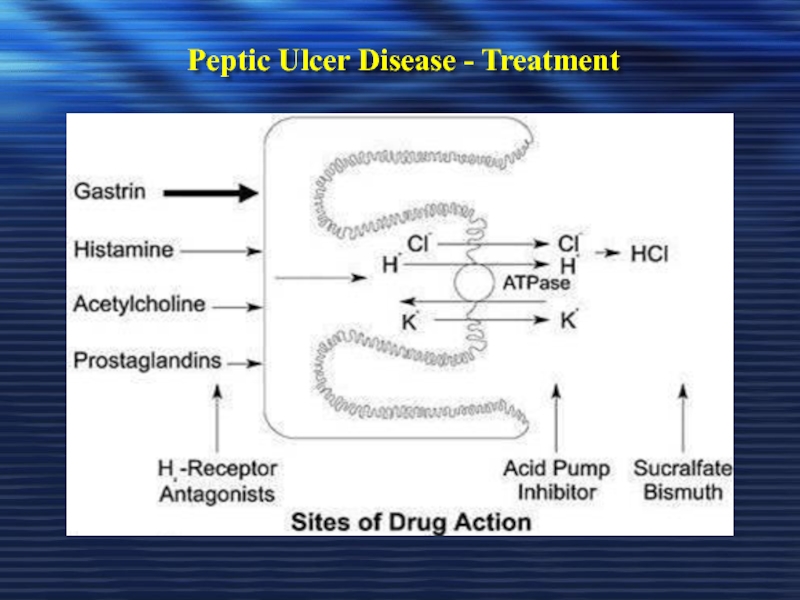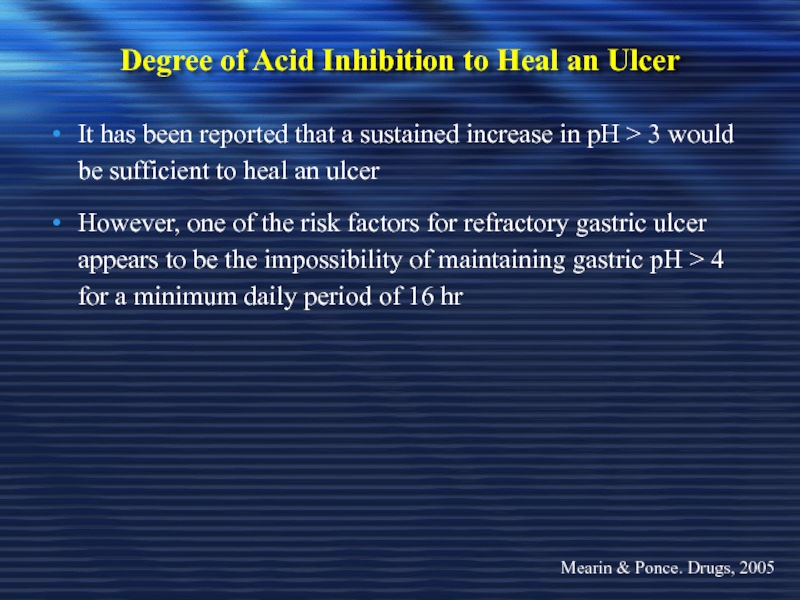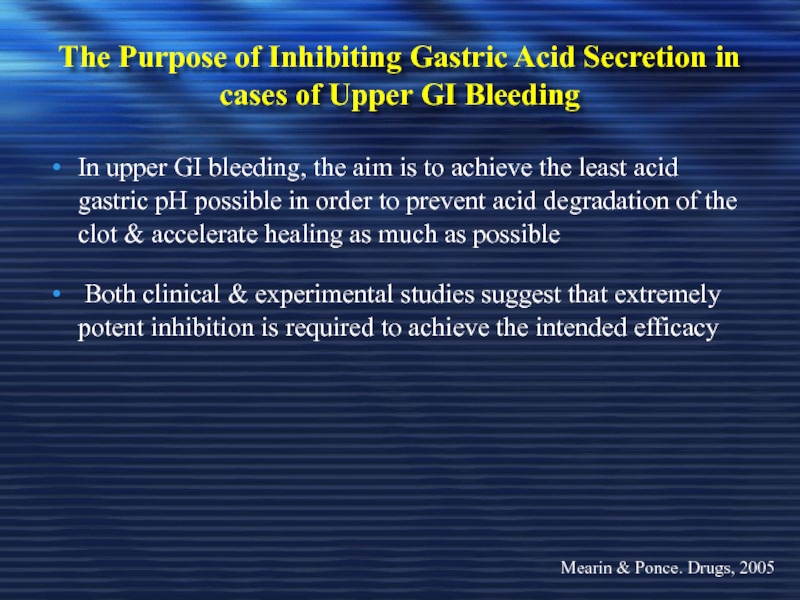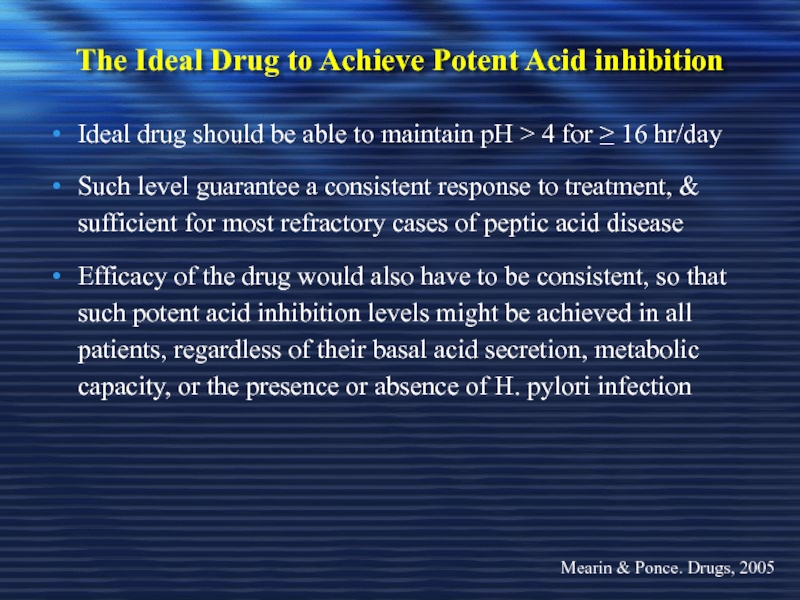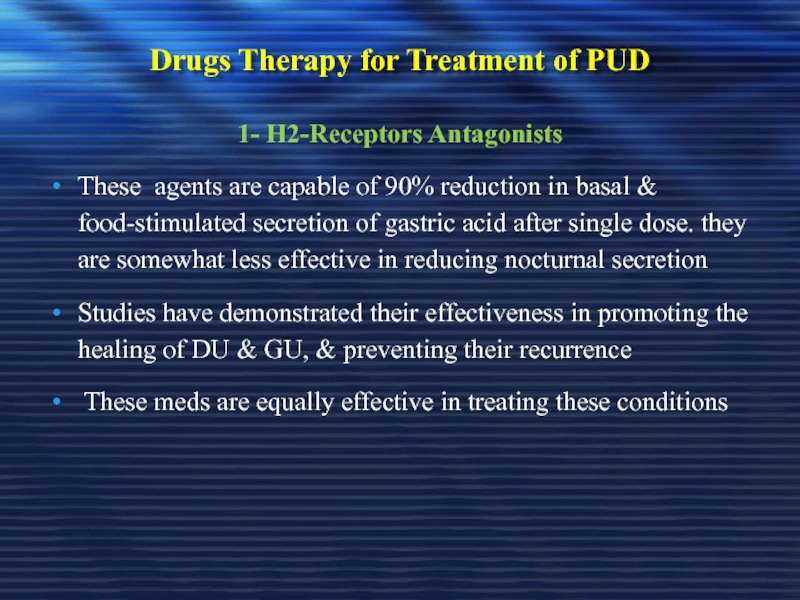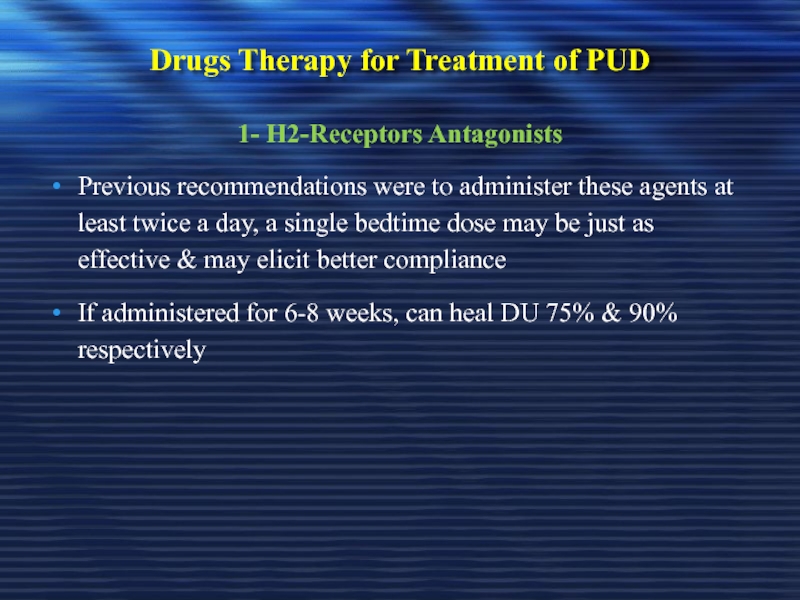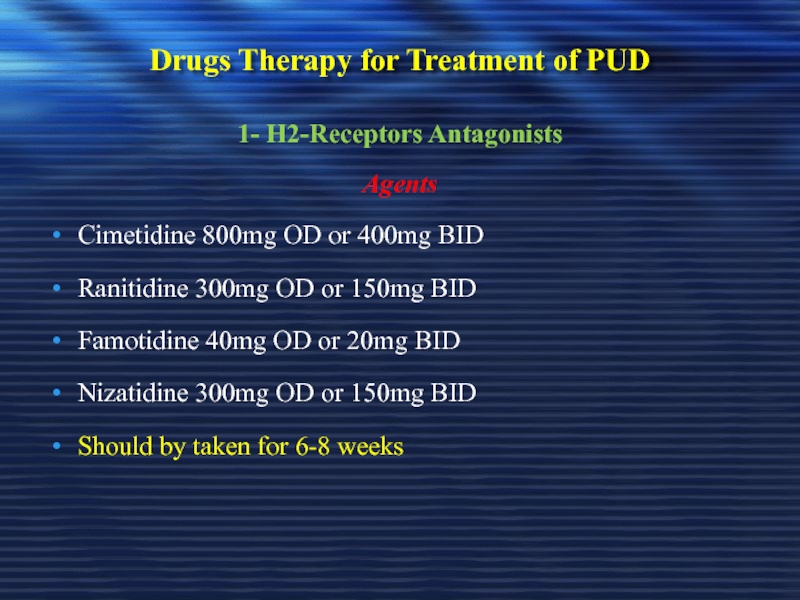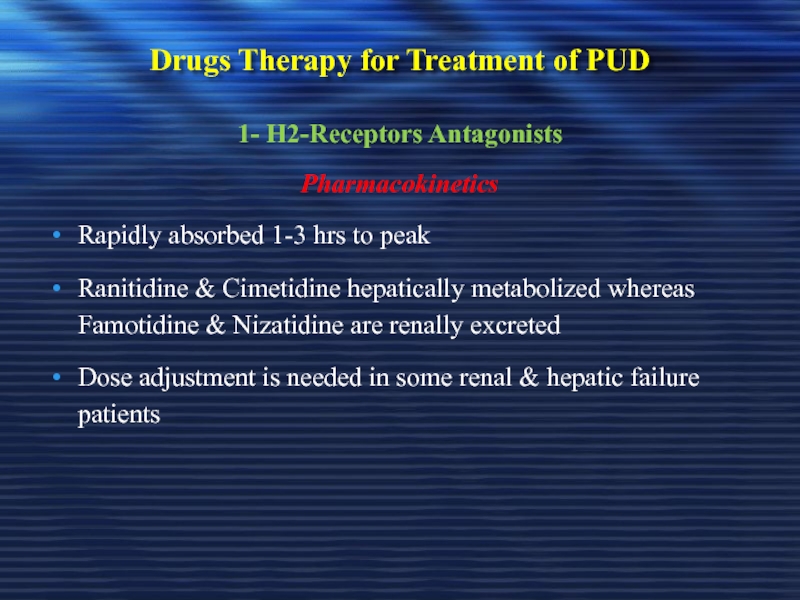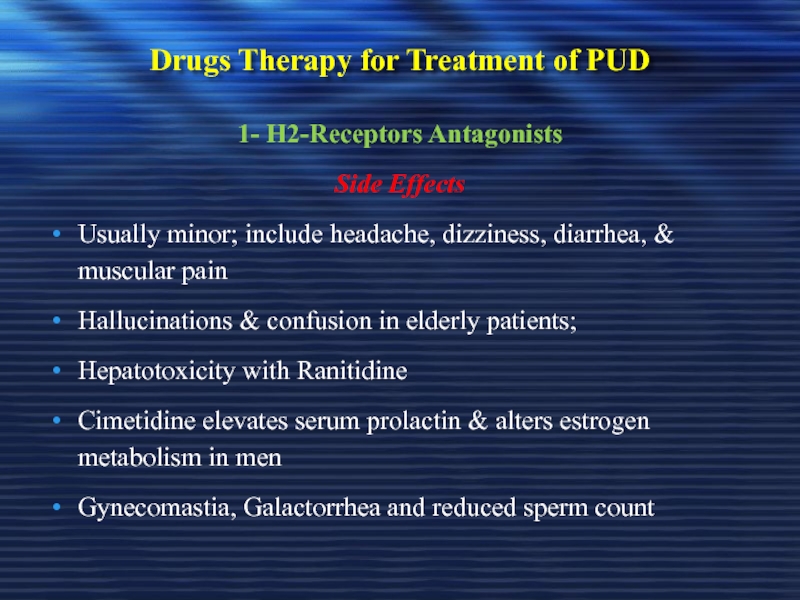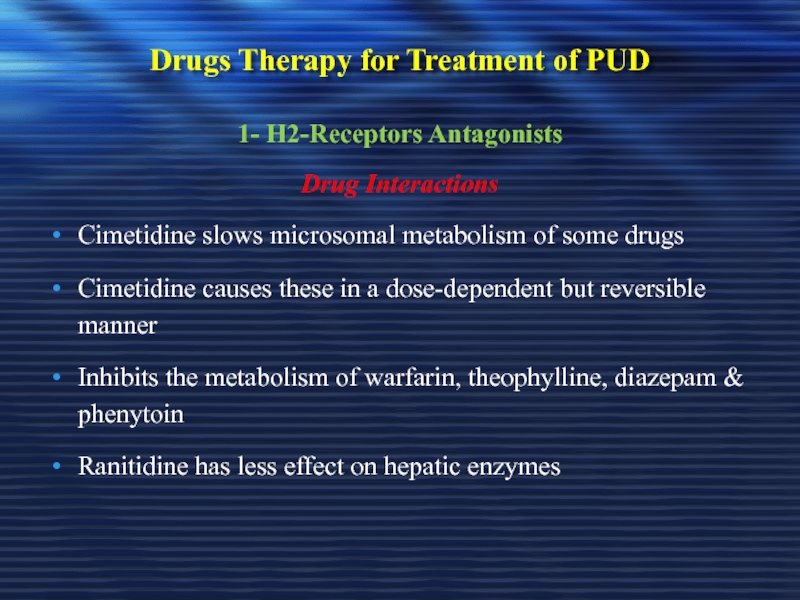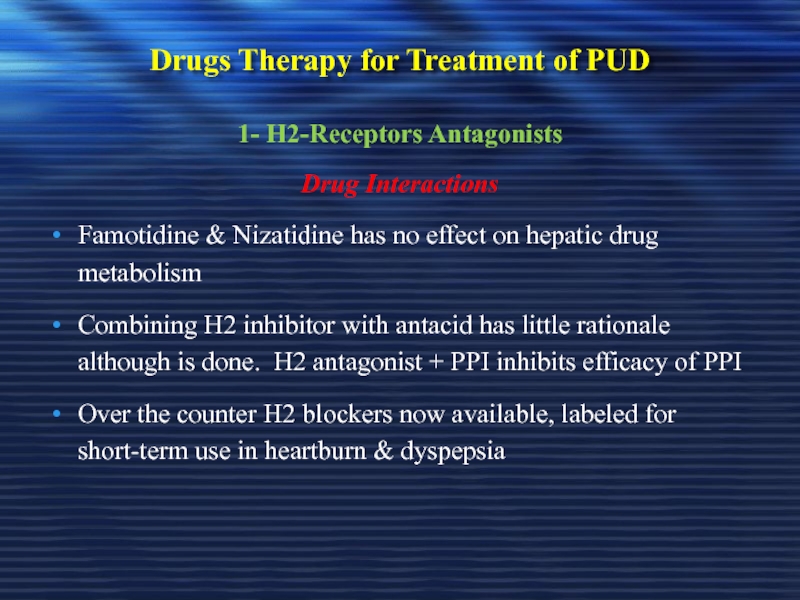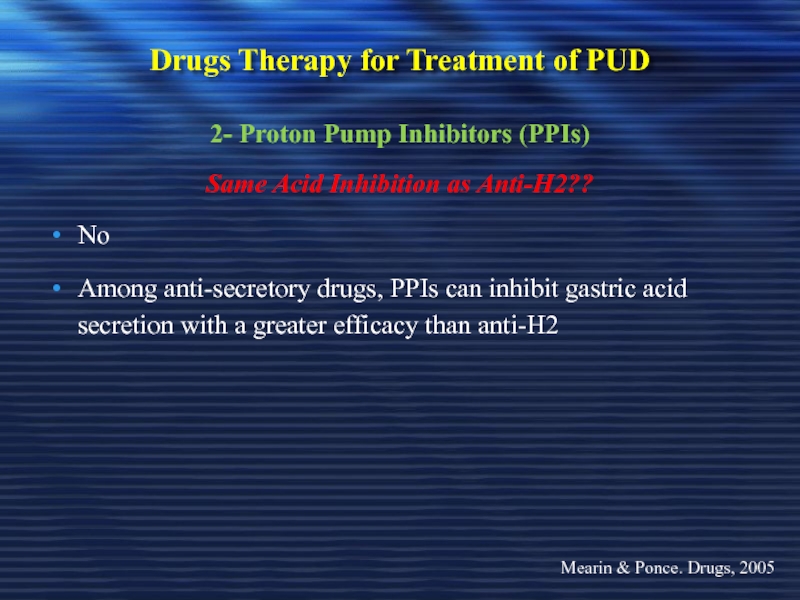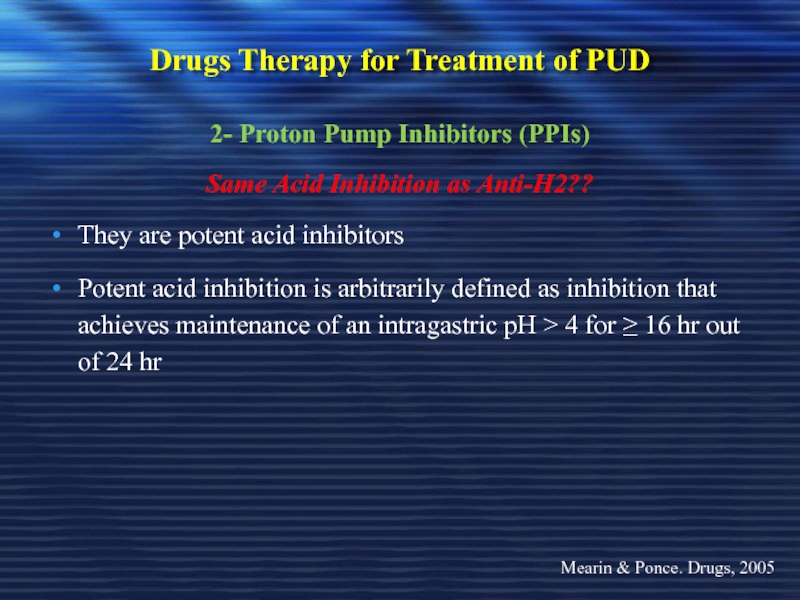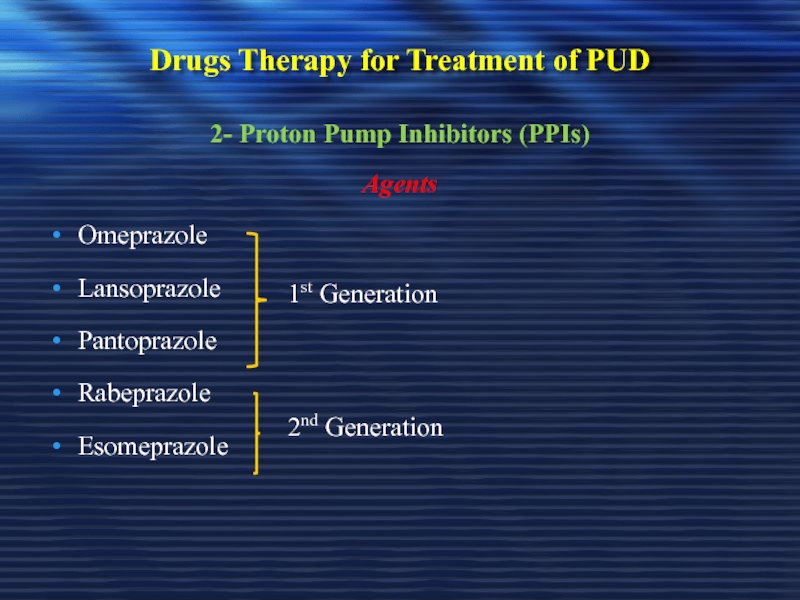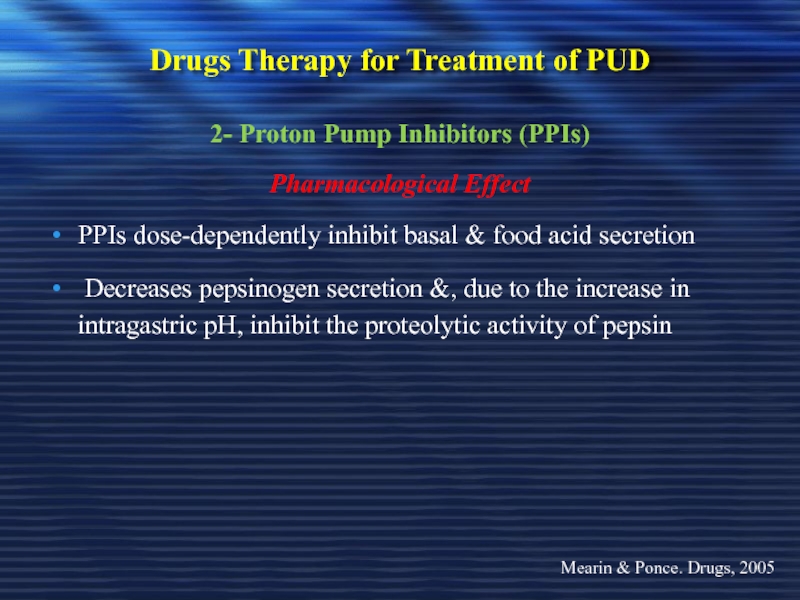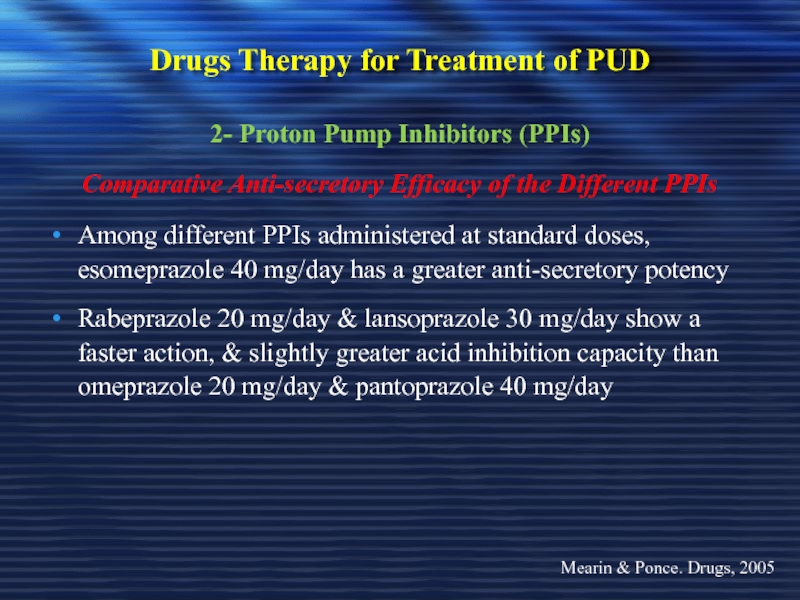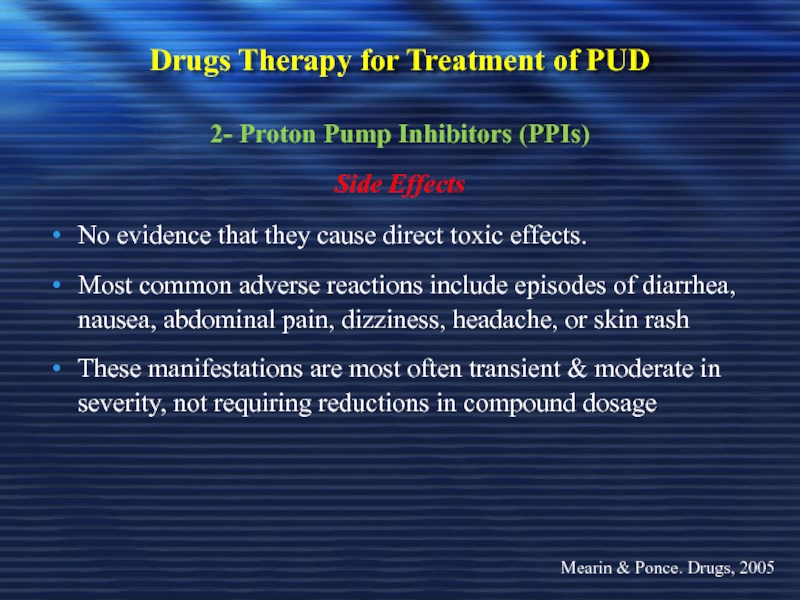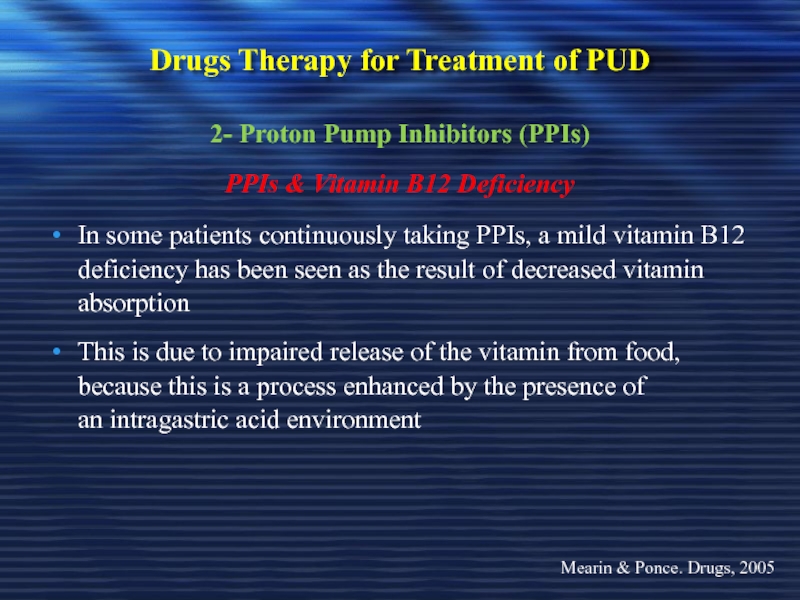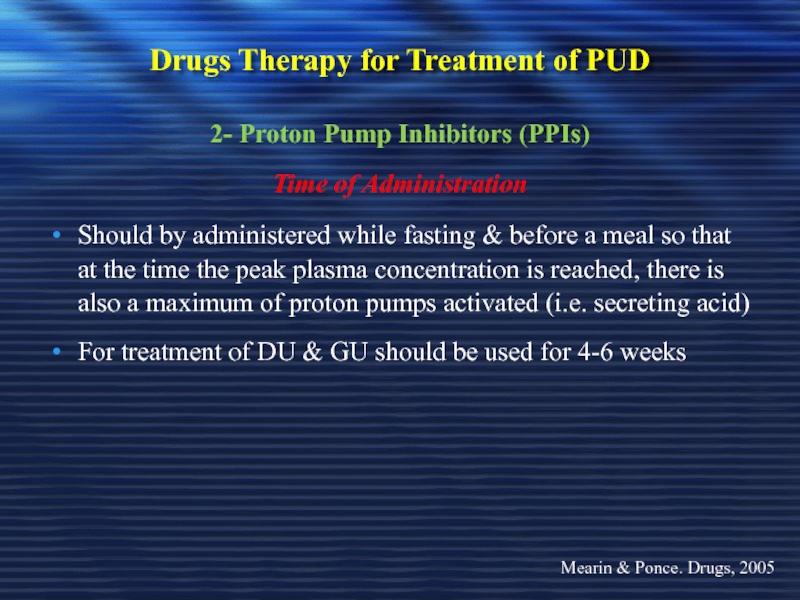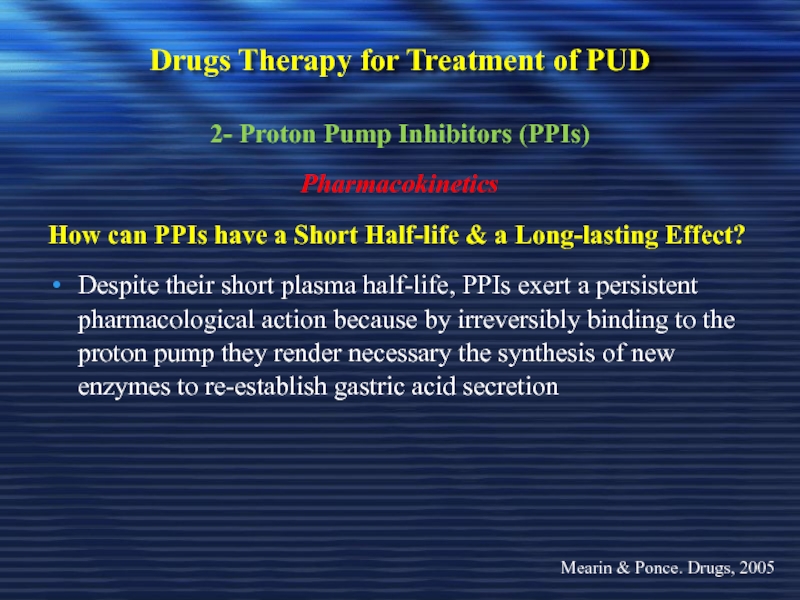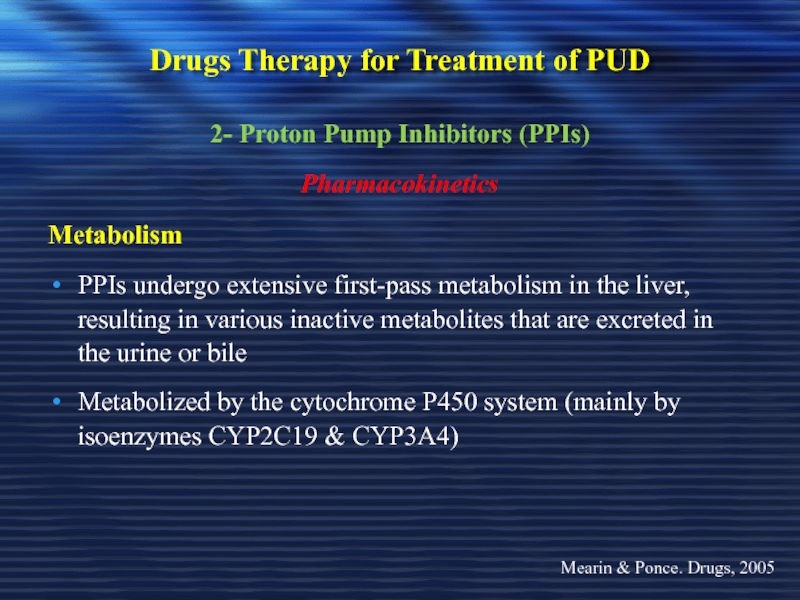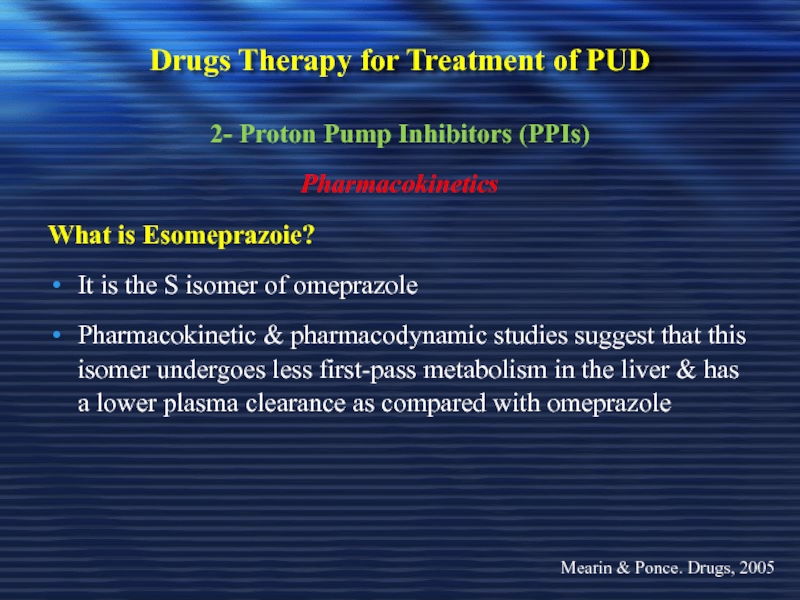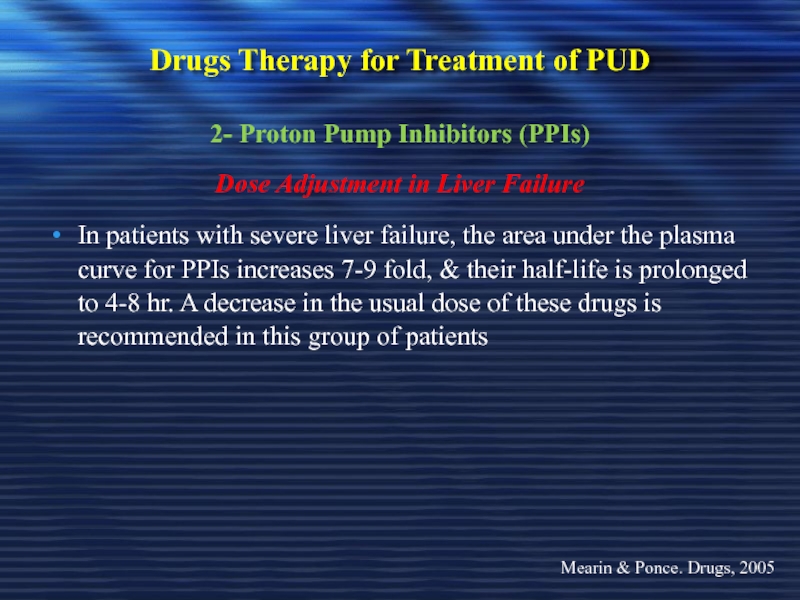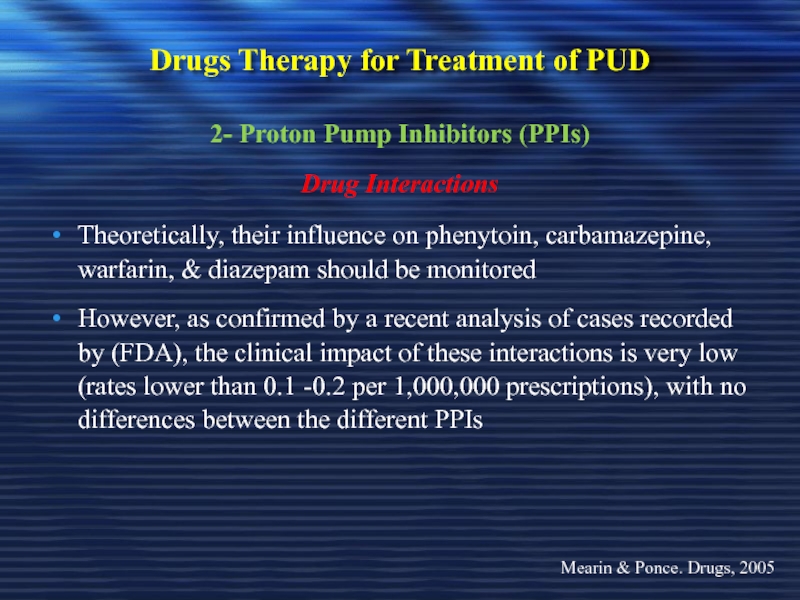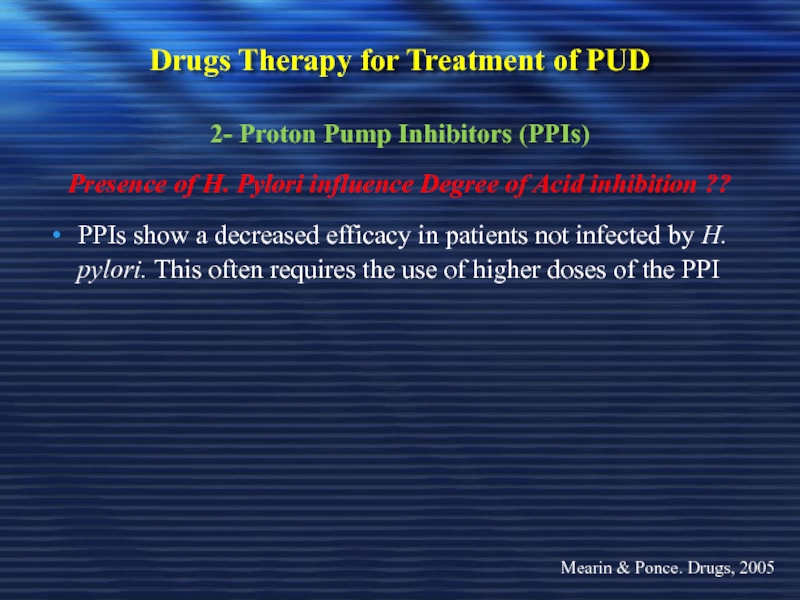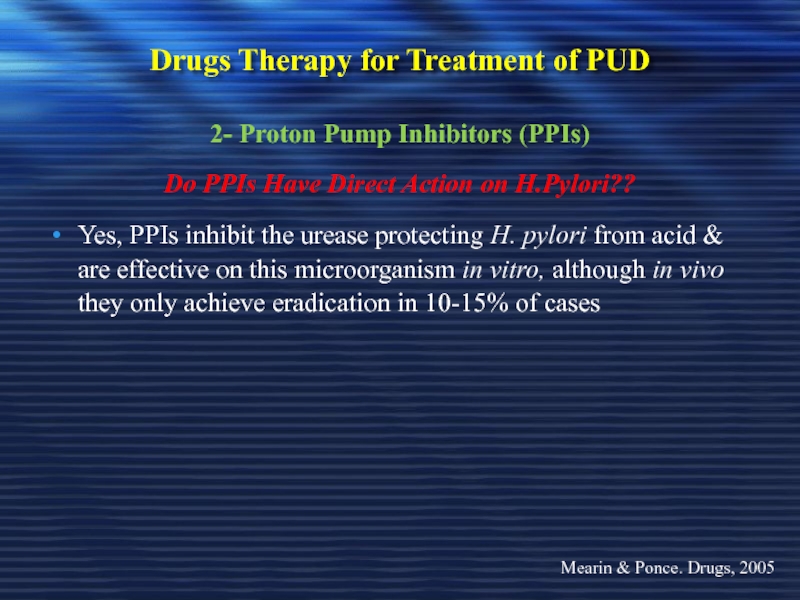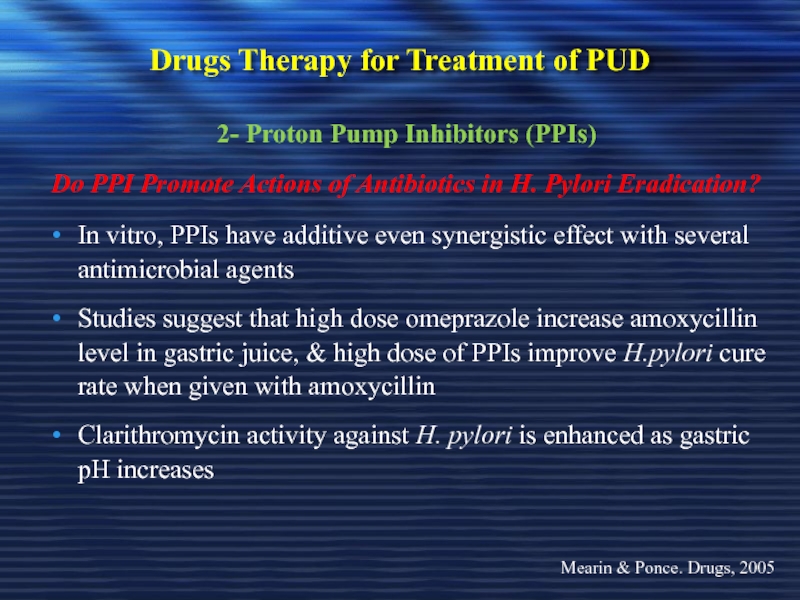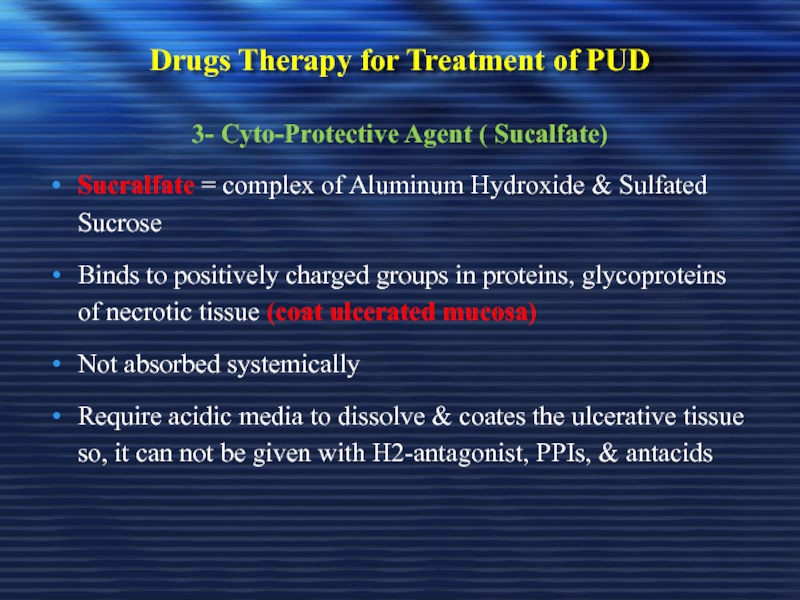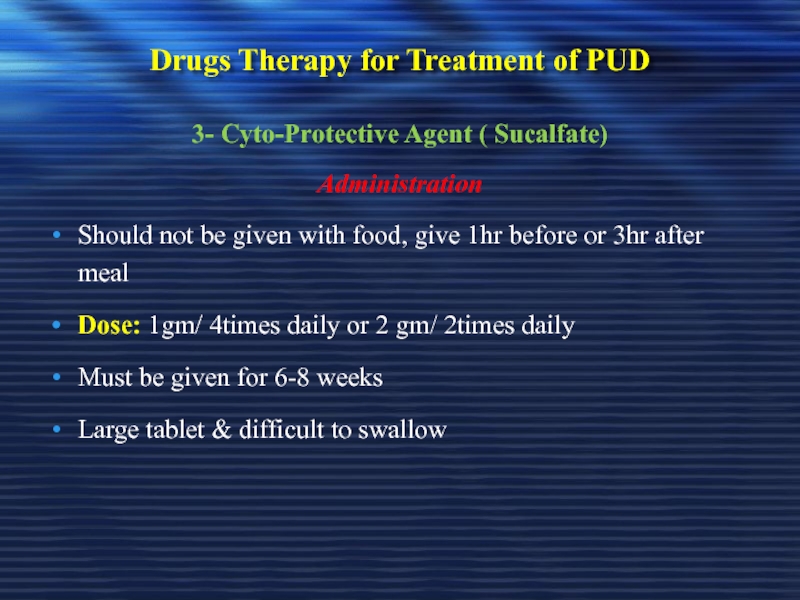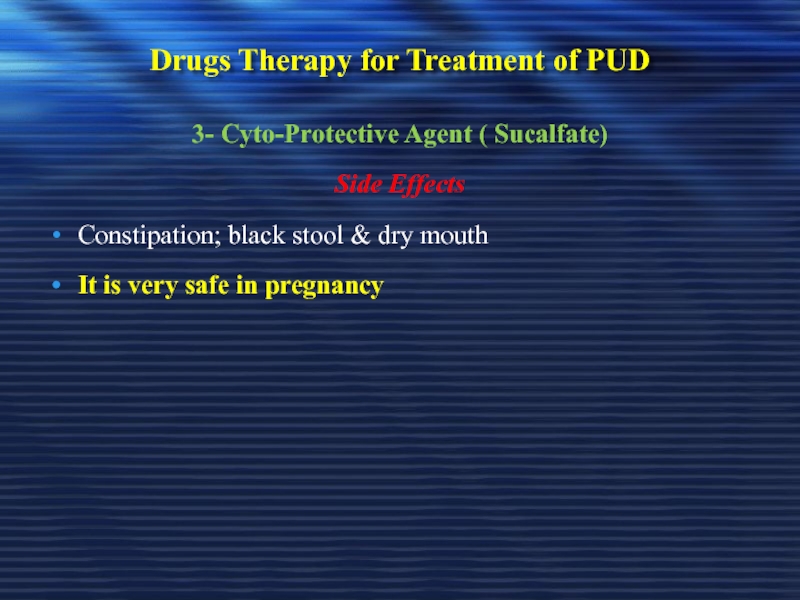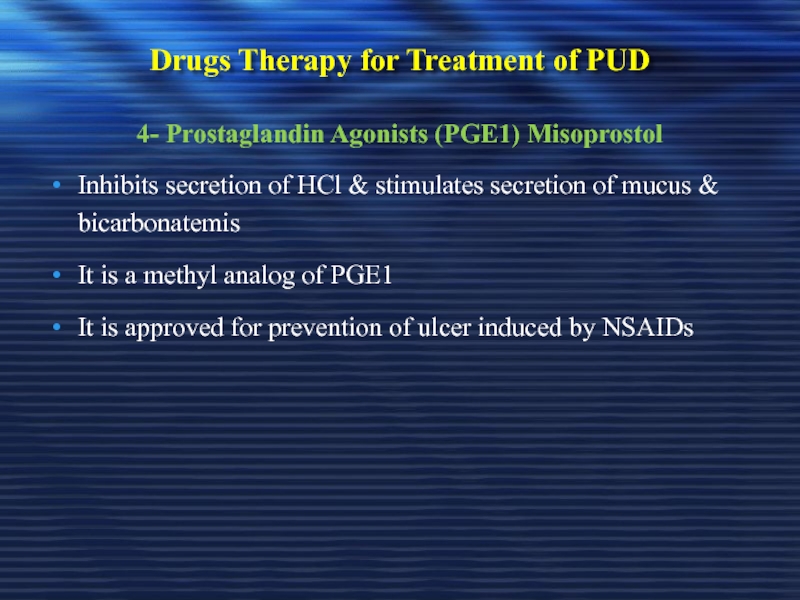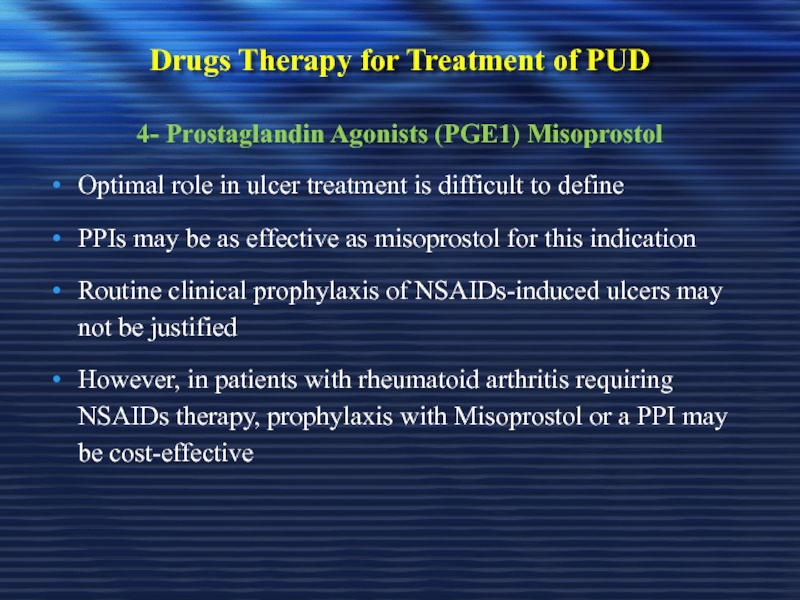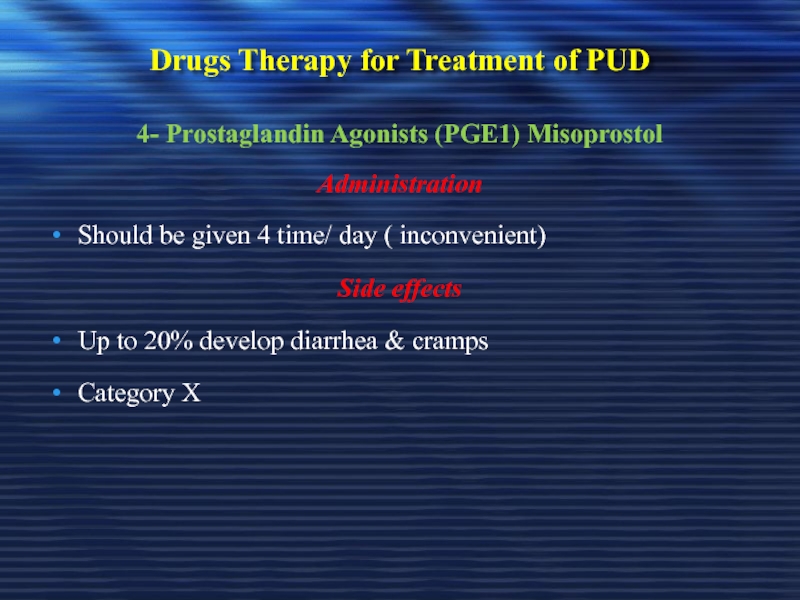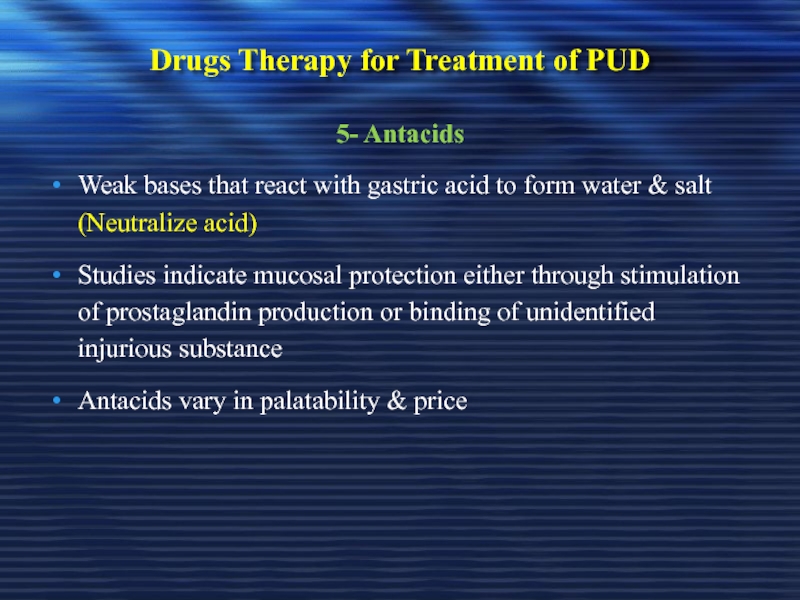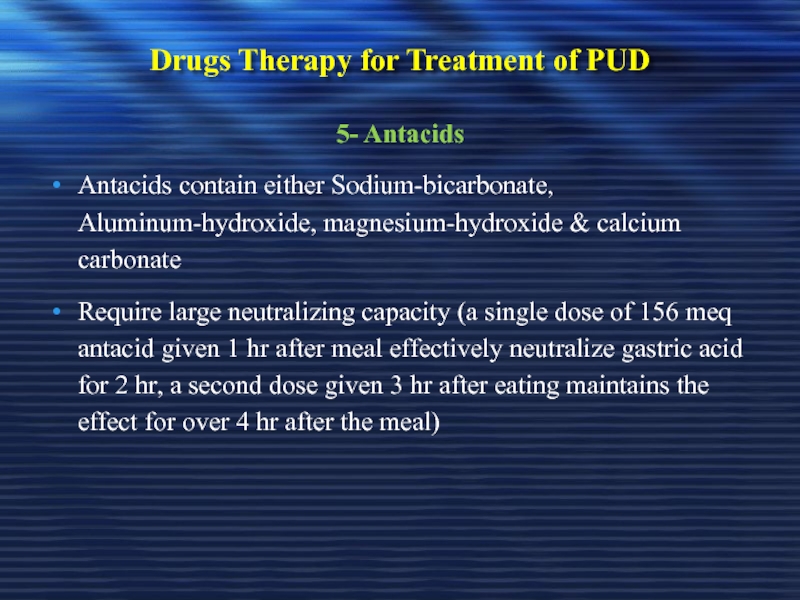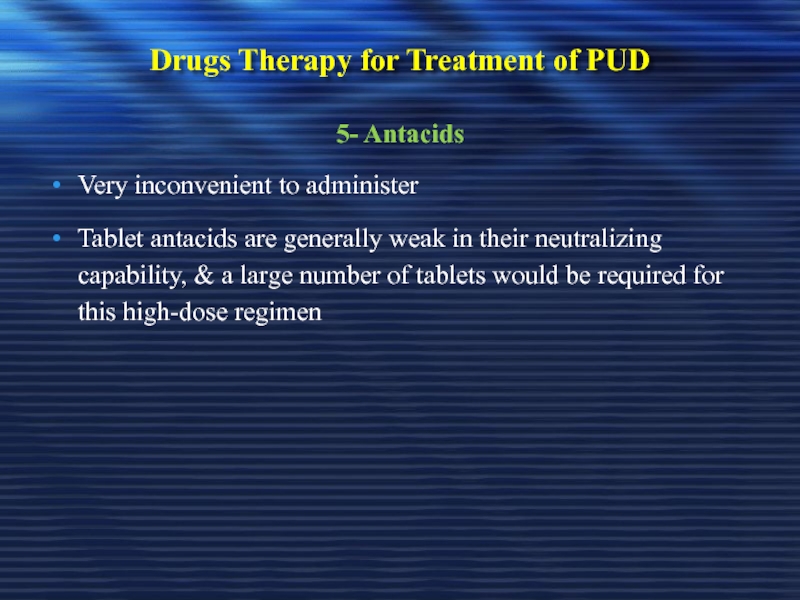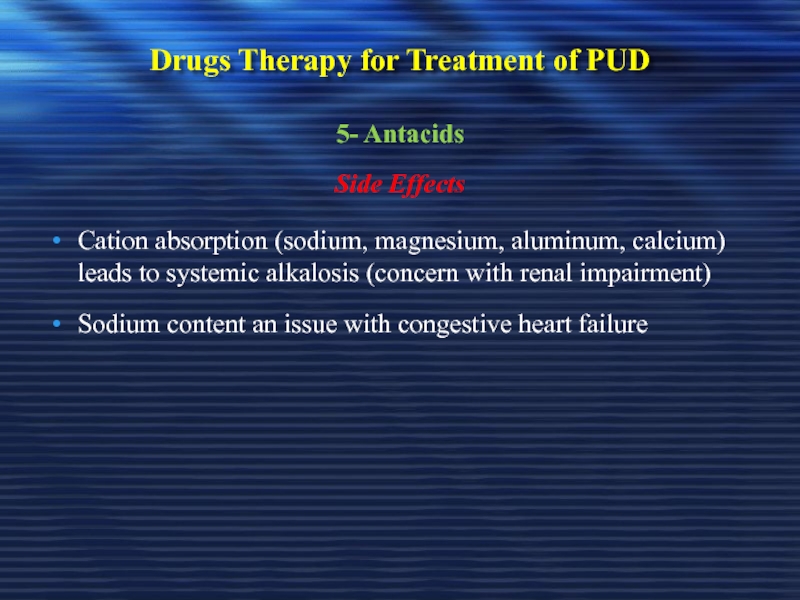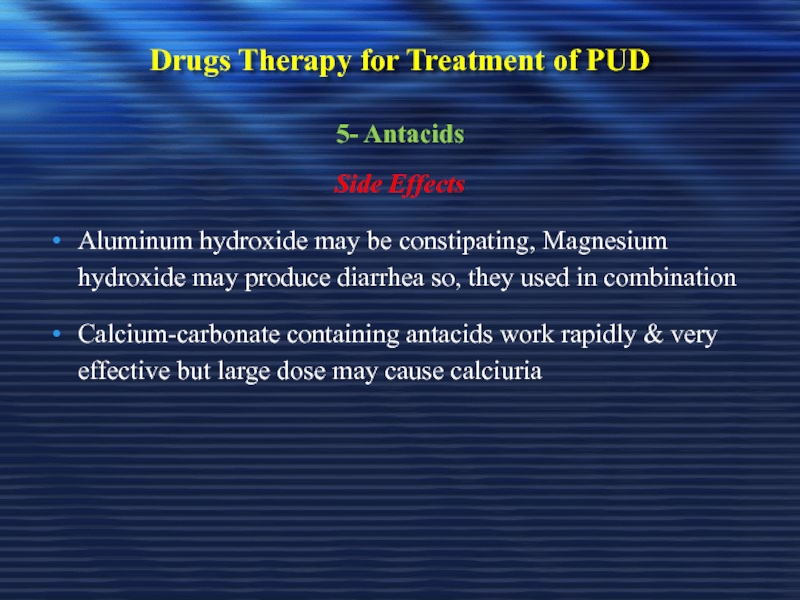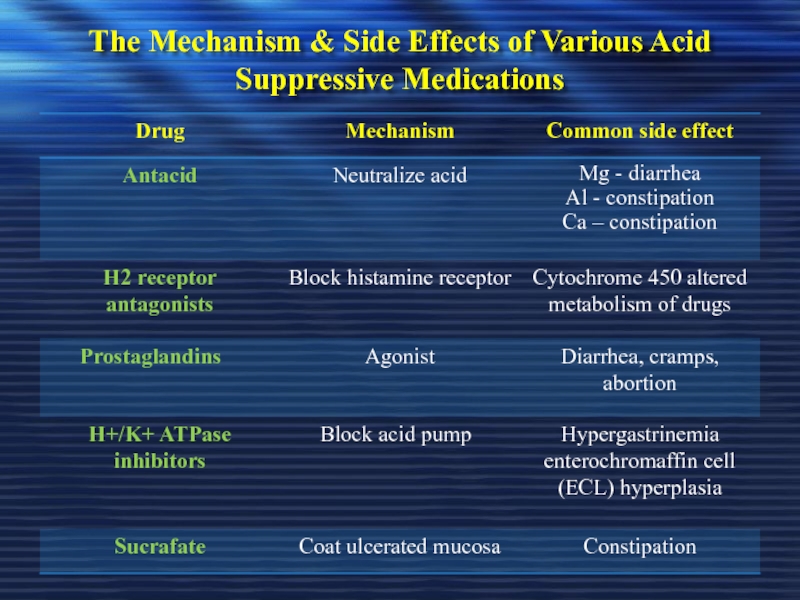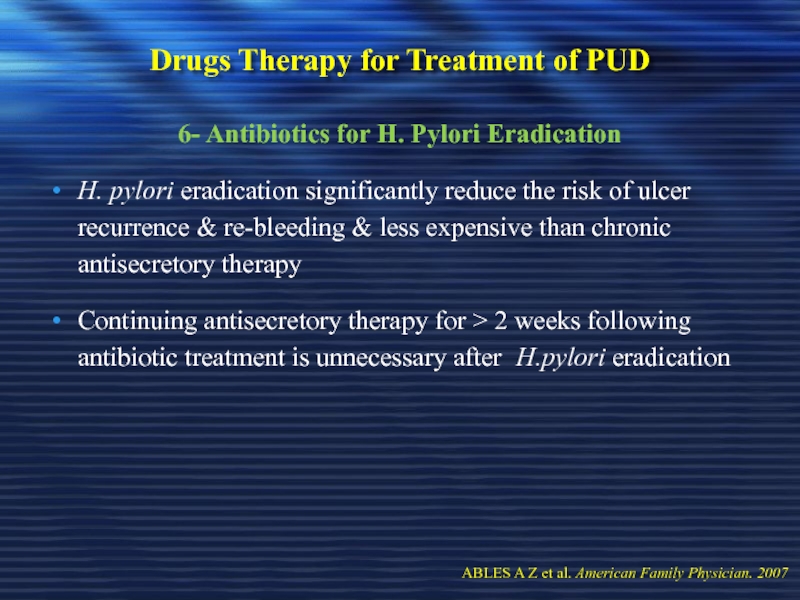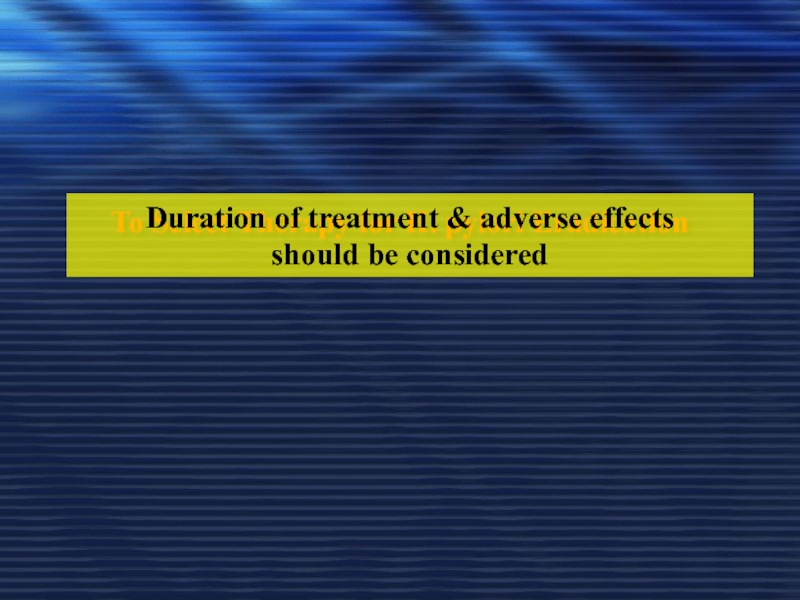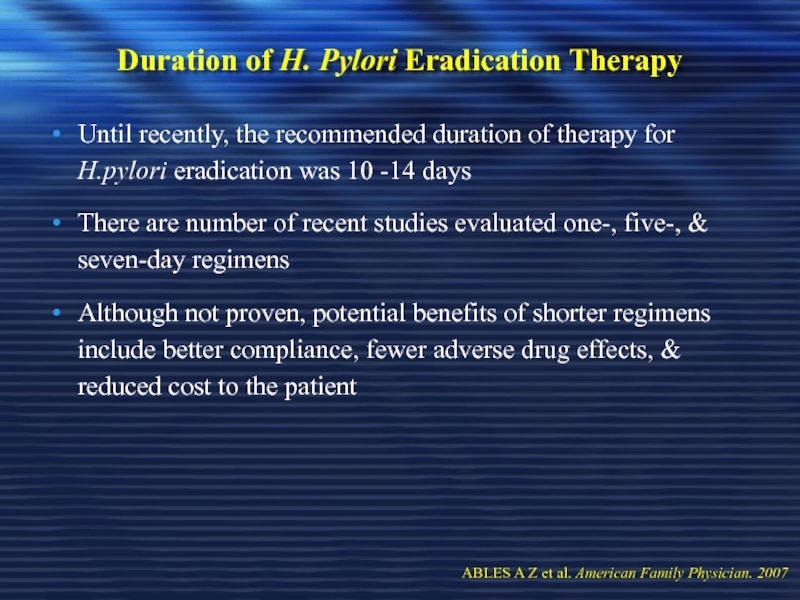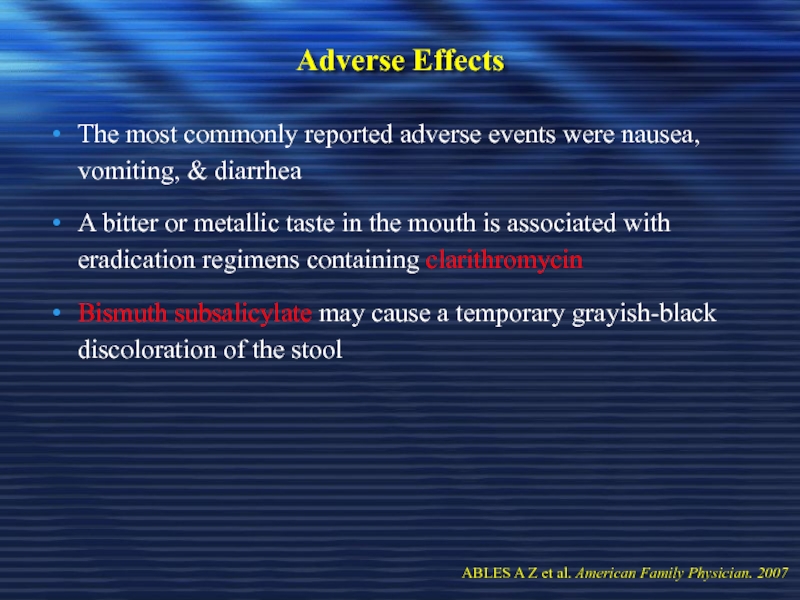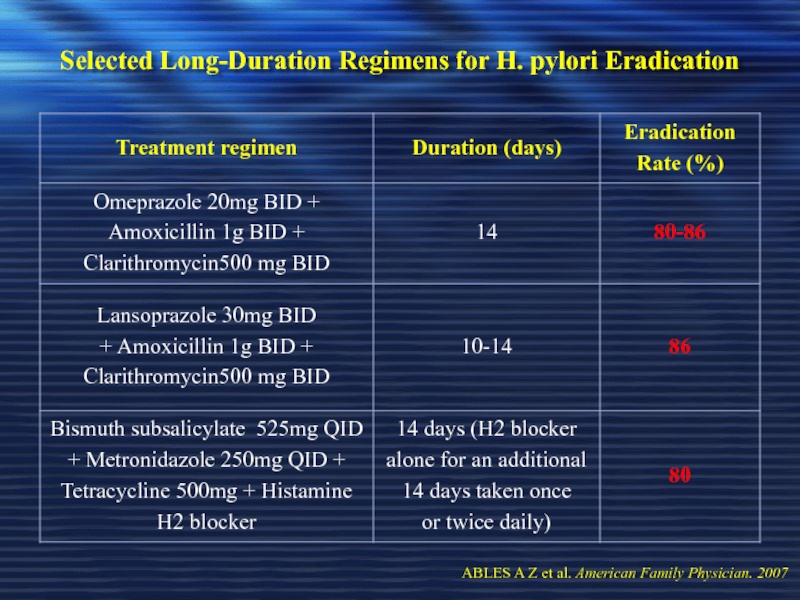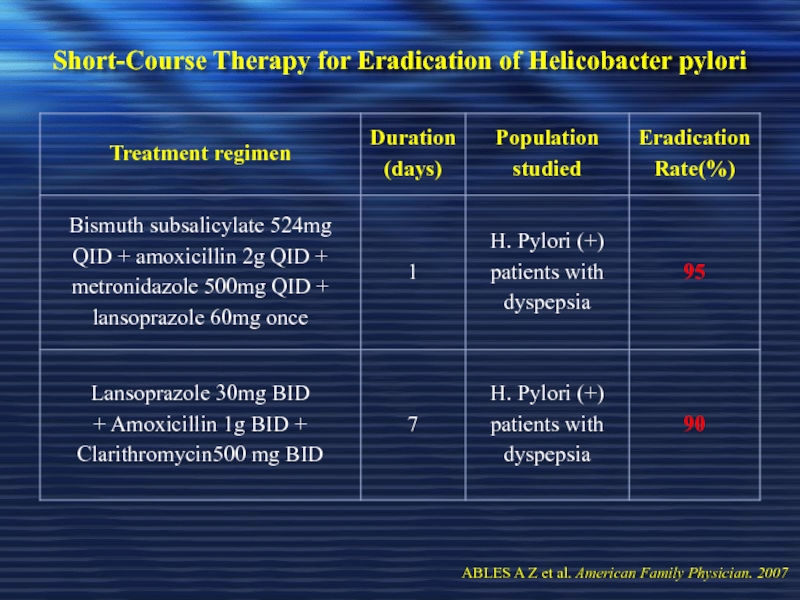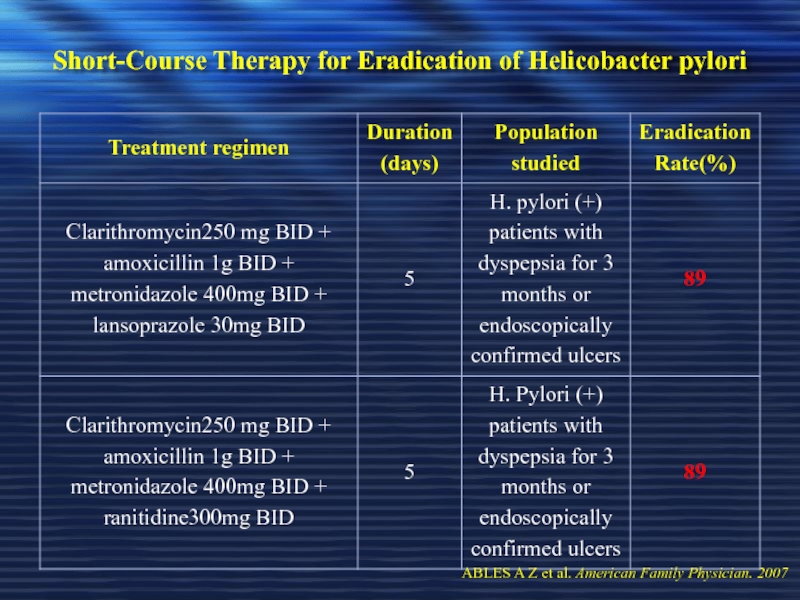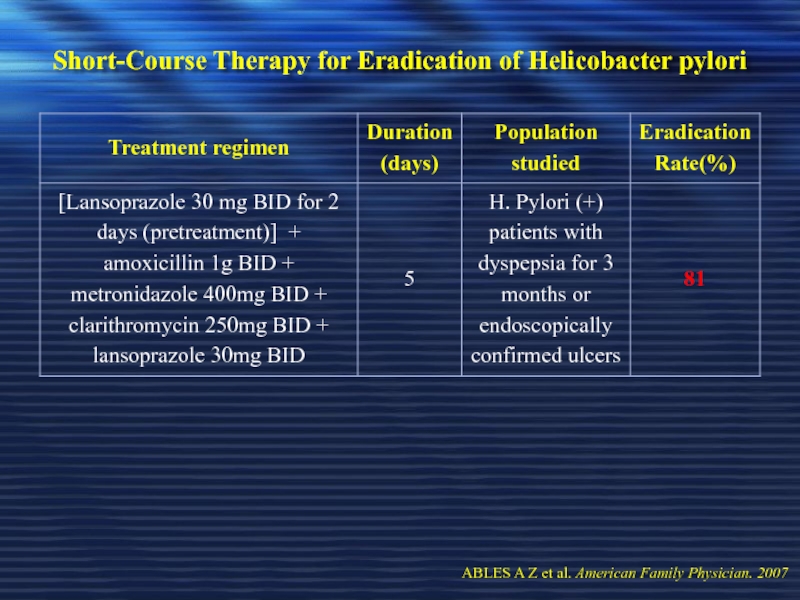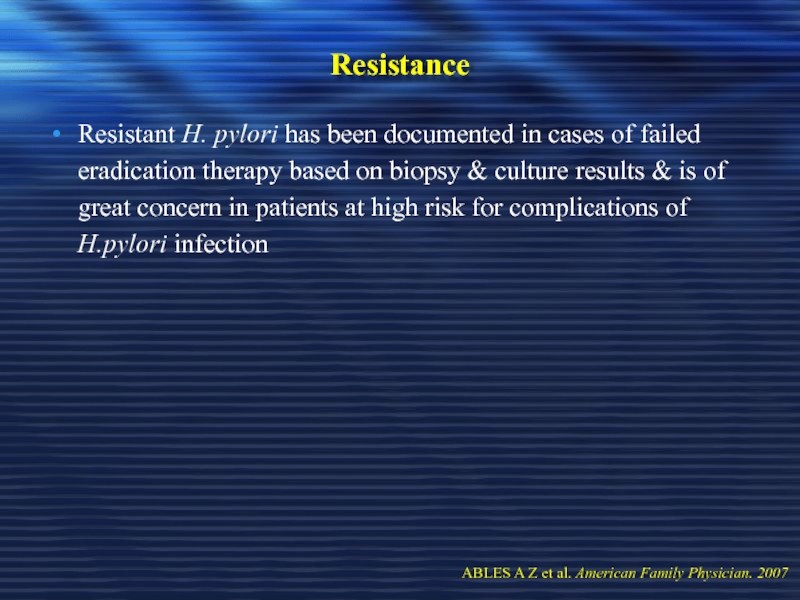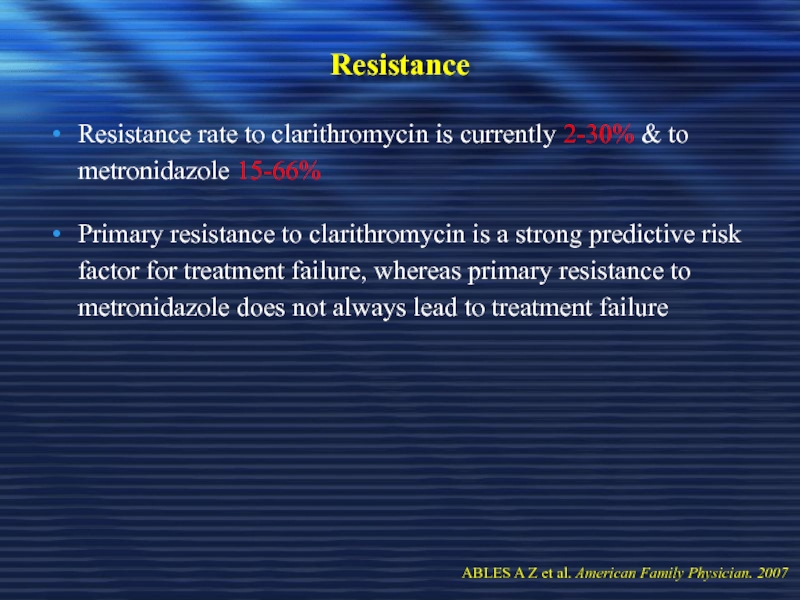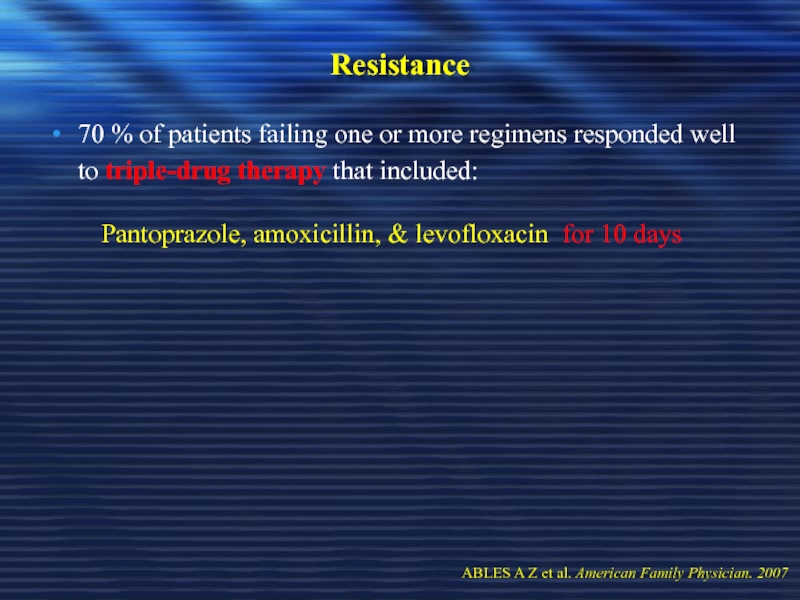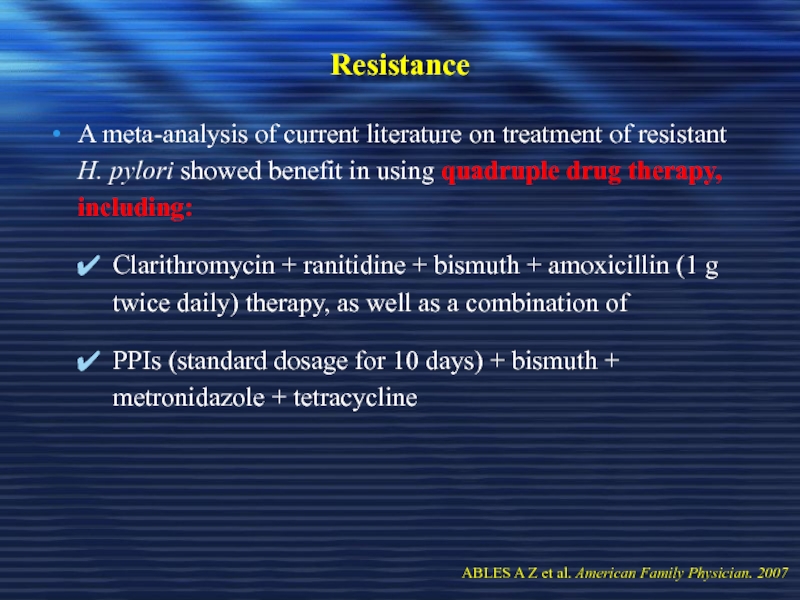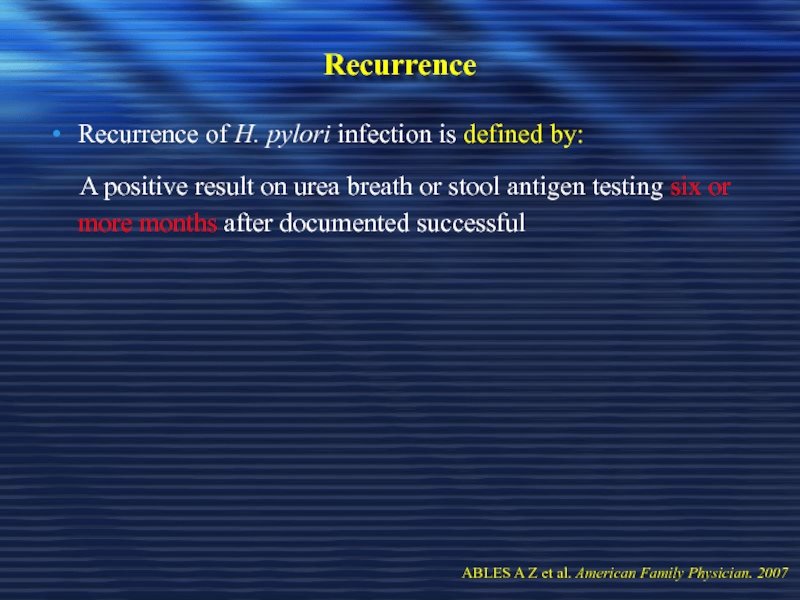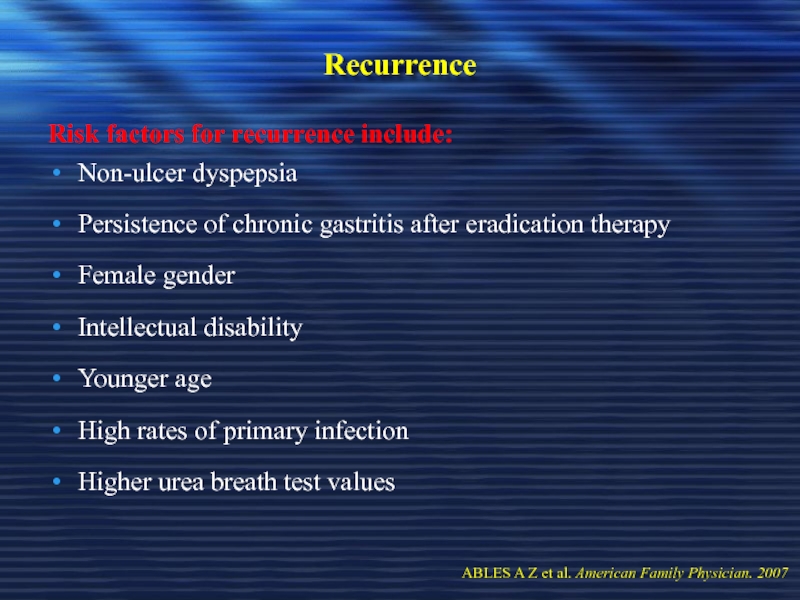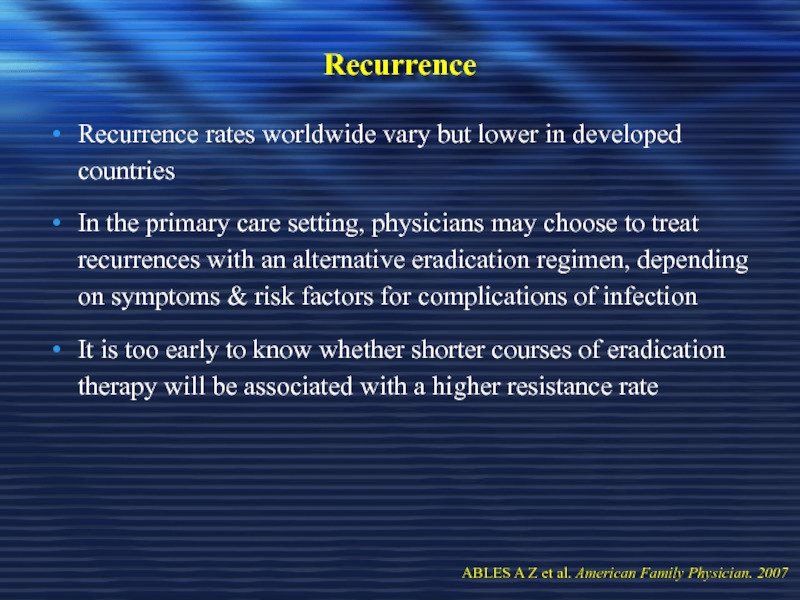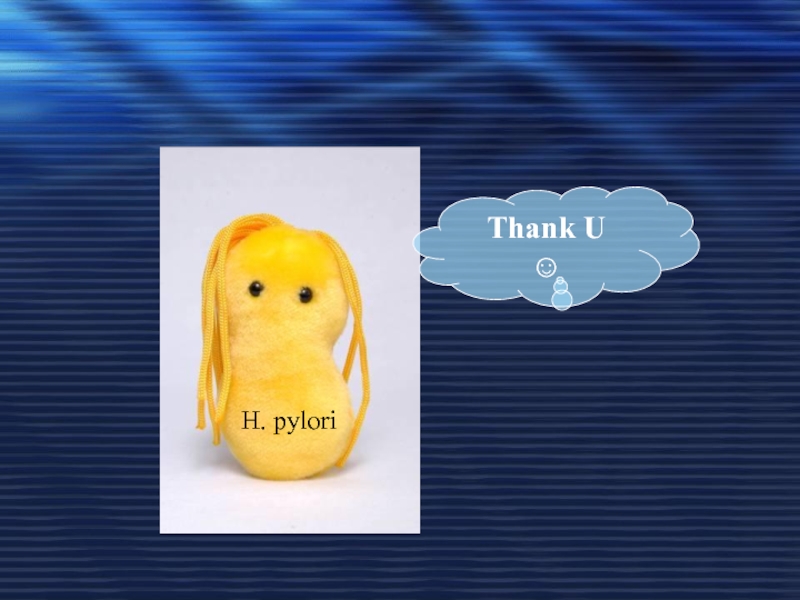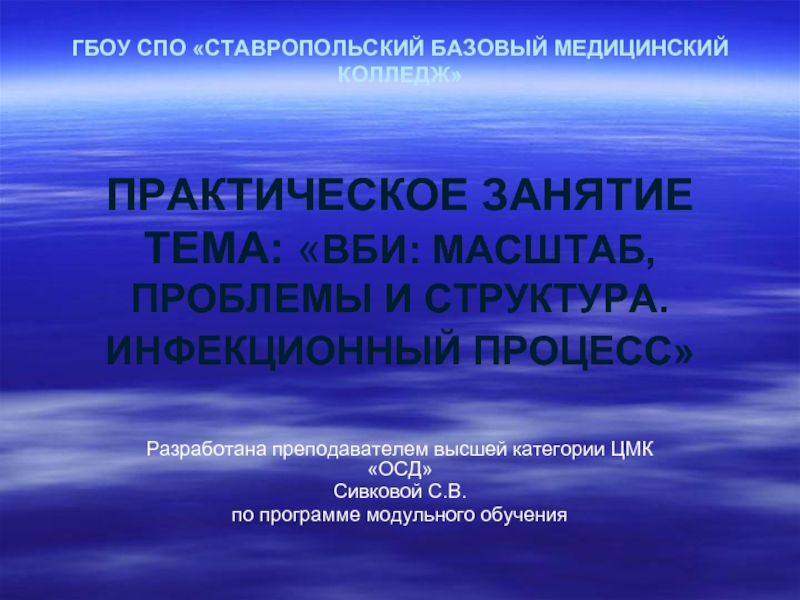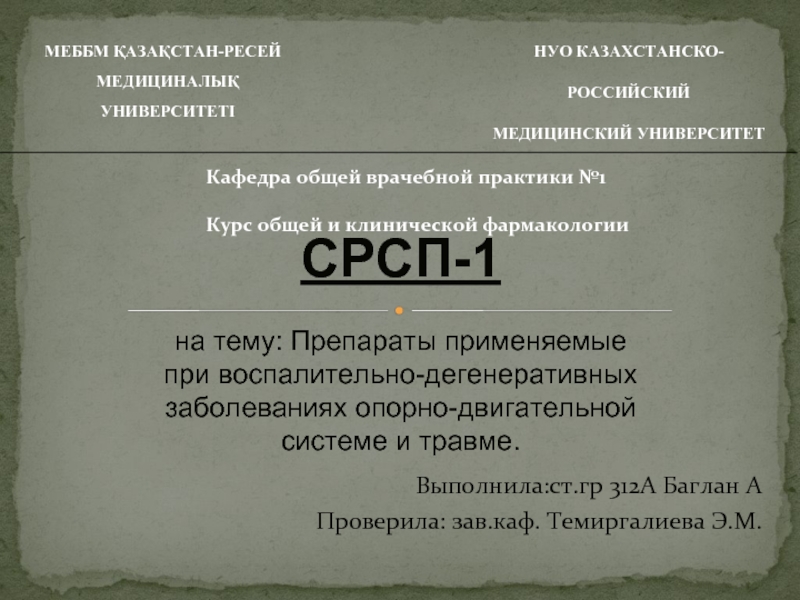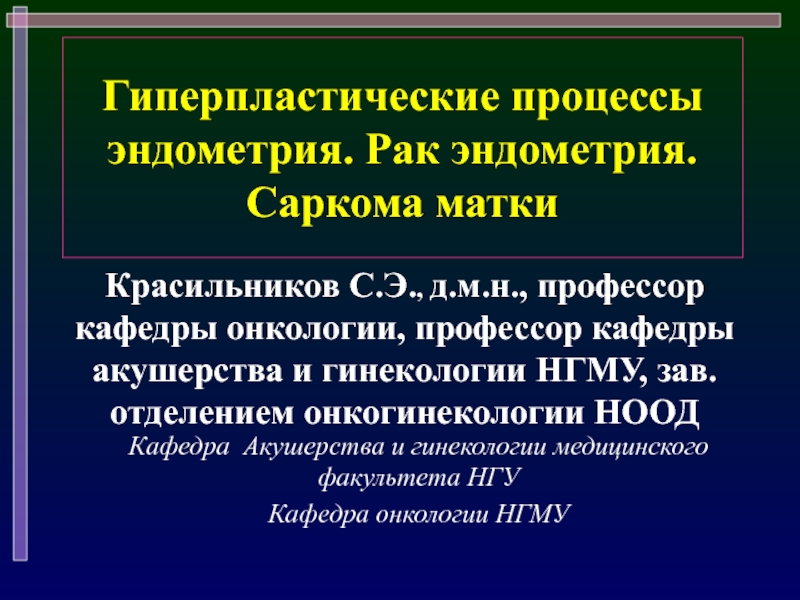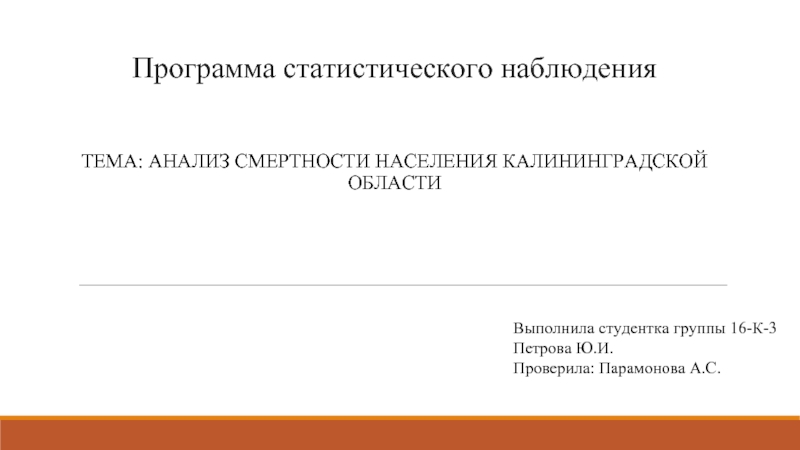- Главная
- Разное
- Дизайн
- Бизнес и предпринимательство
- Аналитика
- Образование
- Развлечения
- Красота и здоровье
- Финансы
- Государство
- Путешествия
- Спорт
- Недвижимость
- Армия
- Графика
- Культурология
- Еда и кулинария
- Лингвистика
- Английский язык
- Астрономия
- Алгебра
- Биология
- География
- Детские презентации
- Информатика
- История
- Литература
- Маркетинг
- Математика
- Медицина
- Менеджмент
- Музыка
- МХК
- Немецкий язык
- ОБЖ
- Обществознание
- Окружающий мир
- Педагогика
- Русский язык
- Технология
- Физика
- Философия
- Химия
- Шаблоны, картинки для презентаций
- Экология
- Экономика
- Юриспруденция
Peptic ulcer diseases: treatment презентация
Содержание
- 1. Peptic ulcer diseases: treatment
- 2. Introduction Peptic ulcer disease (PUD) is
- 3. Introduction Major advances have been made
- 4. Definitions Ulcer: A lesion on an epithelial
- 5. Definitions Peptic Ulcer An ulcer of the
- 6. Peptic Ulcer Disease
- 7. Gastric Mucosa & Secretions The inside of
- 8. Gastric Mucosa & Secretions The Defensive Forces
- 9. Negative Feedback Regulation of Acid Secretion
- 10. Pathophysiology A peptic ulcer is a mucosal
- 11. Pathophysiology Two major variants in peptic ulcers
- 12. Pathophysiology DU result from increased acid load
- 13. Pathophysiology DU result from increased acid load
- 14. Pathophysiology GU results from the break down
- 15. Etiology The two most common causes
- 16. Etiology Other uncommon causes include: Gastrinoma (Gastrin
- 17. 1. Etiology – Helicobacter pylori
- 18. H.pylori Epidemiology One half of world’s population
- 19. H.pylori as a cause of PUD
- 20. H.pylori as a cause of PUD 95% 85%
- 21. Pathogenesis of H. pylori infection H.
- 22. Pathogenesis of H. pylori infection The Flagellae
- 23. Pathogenesis of H. pylori infection Any acidity
- 24. Pathogenesis of H. pylori infection In the
- 25. Pathogenesis of H. pylori infection In the
- 26. Pathogenesis of H. pylori infection - ↓
- 27. Carcinogenic effect of H. pylori
- 28. Carcinogenic effect of H. pylori Epidemiologic evidence
- 29. For persons at high risk for gastric
- 30. 2. Etiology -Non-Steroidal Anti-inflammatory Drugs (NSAIDS)
- 31. NSAIDS Symptomatic GI ulceration occurs in 2%
- 32. NSAIDS Inhibits the production of prostaglandins precursor
- 33. NSAIDS Gastric acid probably aggravates NSAID-induce mucosal
- 34. NSAIDS Users of NSAIDs are at approximately
- 35. NSAIDS Identify risk factors:
- 36. Type of NSAID & Risk of Ulcer
- 37. Does H. pylori Influence the Ulcer Risk in NSAID Users?
- 38. Does H. pylori Influence the Ulcer Risk
- 39. Does H. pylori Influence the Ulcer Risk
- 40. Recommendations for H.pylori Testing & Eradication in
- 41. Recommendations for H.pylori Testing & Eradication in
- 42. Clinical Presentation Recurrent epigastric pain (the most
- 43. Clinical Presentation Nausea, Vomiting Dyspepsia, fatty food
- 44. Diagnosis of PUD
- 45. Peptic Ulcer Disease Diagnosis: Diagnosis of ulcer Diagnosis of H. pylori
- 46. Diagnosis of PUD In most patients
- 47. Doudenal Ulcer on Endoscopy Doudenal Ulcer Normal doudenal bulb
- 48. Gastric Ulcer on Endoscopy Chronic Gastric Ulcers
- 49. Diagnosis of H. pylori Non-invasive C13 or
- 50. Diagnosis of H. pylori Non-invasive
- 51. Diagnosis of H. pylori Non-invasive Serology
- 52. Diagnosis of H. pylori Invasive Upper GI
- 53. Diagnosis of H. pylori Invasive (endoscopy) Diagnostic:
- 54. Diagnosis of H. pylori Invasive (endoscopy) Rapid
- 55. Diagnosis of H. pylori Invasive (endoscopy) *
- 56. Diagnostic Tests for Helicobacter pylori Invasive
- 57. Diagnostic Tests for Helicobacter pylori Noninvasive
- 58. Diagnostic Tests for Helicobacter pylori Noninvasive
- 59. Diagnostic Tests for Helicobacter pylori Noninvasive
- 60. Testing to Document HP Eradication Since treatment
- 61. Testing to Document HP Eradication Should be
- 62. Diagnosis of H. pylori in patients with
- 63. PUD – Complications Bleeding Perforation Gastric outlet or duodenal obstruction Chronic anemia
- 64. Complications of PUD on Endoscopy
- 65. PUD Treatment
- 66. Treatment Goals Rapid relief of symptoms
- 67. General Strategy Treat complications aggressively if
- 68. General Strategy Smoking cessation should be
- 69. Drugs Therapy H2-Receptors antagonists Proton
- 70. Management of NSAIDs Ulcers
- 71. Management of NSAIDs Ulcers This can be
- 72. Healing the Established NSAIDs-Associated Ulcer If possible,
- 73. Best Prevention & Treatment for Upper GI
- 74. The Astronaut Study Ranitidine 150 mg twice
- 75. Are Better Results Obtained if Additional Inhibition
- 76. Reducing Risk of NSAIDs Ulcers by Choice
- 77. Reducing Risk of NSAIDs Ulcers by Choice
- 78. Reducing Risk of NSAIDs Ulcers by Choice
- 79. Preventing NSAIDs Ulcers with Co-Prescribed Gastric Protectants
- 80. Drugs Therapy for Treatment of PUD 1-
- 81. Peptic Ulcer Disease - Treatment
- 82. Degree of Acid Inhibition to Heal an
- 83. The Purpose of Inhibiting Gastric Acid Secretion
- 84. The Ideal Drug to Achieve Potent Acid
- 85. Drugs Therapy for Treatment of PUD 1-
- 86. Drugs Therapy for Treatment of PUD 1-
- 87. Drugs Therapy for Treatment of PUD 1-
- 88. Drugs Therapy for Treatment of PUD 1-
- 89. Drugs Therapy for Treatment of PUD 1-
- 90. Drugs Therapy for Treatment of PUD 1-
- 91. Drugs Therapy for Treatment of PUD 1-
- 92. Drugs Therapy for Treatment of PUD 2-
- 93. Drugs Therapy for Treatment of PUD 2-
- 94. Drugs Therapy for Treatment of PUD 2-
- 95. Drugs Therapy for Treatment of PUD 2-
- 96. Drugs Therapy for Treatment of PUD 2-
- 97. Drugs Therapy for Treatment of PUD 2-
- 98. Drugs Therapy for Treatment of PUD 2-
- 99. Drugs Therapy for Treatment of PUD 2-
- 100. Drugs Therapy for Treatment of PUD 2-
- 101. Drugs Therapy for Treatment of PUD 2-
- 102. Drugs Therapy for Treatment of PUD 2-
- 103. Drugs Therapy for Treatment of PUD 2-
- 104. Drugs Therapy for Treatment of PUD 2-
- 105. Drugs Therapy for Treatment of PUD 2-
- 106. Drugs Therapy for Treatment of PUD 2-
- 107. Drugs Therapy for Treatment of PUD 2-
- 108. Drugs Therapy for Treatment of PUD 3-
- 109. Drugs Therapy for Treatment of PUD 3-
- 110. Drugs Therapy for Treatment of PUD 3-
- 111. Drugs Therapy for Treatment of PUD 4-
- 112. Drugs Therapy for Treatment of PUD 4-
- 113. Drugs Therapy for Treatment of PUD 4-
- 114. Drugs Therapy for Treatment of PUD 5-
- 115. Drugs Therapy for Treatment of PUD 5-
- 116. Drugs Therapy for Treatment of PUD 5-
- 117. Drugs Therapy for Treatment of PUD 5-
- 118. Drugs Therapy for Treatment of PUD 5-
- 119. The Mechanism & Side Effects of Various Acid Suppressive Medications
- 120. Drugs Therapy for Treatment of PUD 6-
- 121. To Select Therapy for H. pylori Eradication
- 122. Duration of H. Pylori Eradication Therapy
- 123. Adverse Effects The most commonly reported
- 124. Selected Long-Duration Regimens for H. pylori Eradication
- 125. Short-Course Therapy for Eradication of Helicobacter pylori
- 126. Short-Course Therapy for Eradication of Helicobacter pylori
- 127. Short-Course Therapy for Eradication of Helicobacter pylori
- 128. Resistance Resistant H. pylori has been
- 129. Resistance Resistance rate to clarithromycin is
- 130. Resistance 70 % of patients failing
- 131. Resistance A meta-analysis of current literature
- 132. Recurrence Recurrence of H. pylori infection
- 133. Recurrence Risk factors for recurrence include:
- 134. Recurrence Recurrence rates worldwide vary but
- 135. H. pylori Thank U ☺
Слайд 2Introduction
Peptic ulcer disease (PUD) is a common disorder that affects
It is accounting for roughly 10% of medical costs for digestive diseases
Слайд 3Introduction
Major advances have been made in the understanding PUD pathophysiology,
This has led to important changes in diagnostic & treatment strategies, with potential for improving clinical outcome & decreasing health care costs
NSAIDs= nonsteroidal anti-inflammatory drugs
Слайд 4Definitions
Ulcer:
A lesion on an epithelial surface (skin or mucous membrane) caused
Erosion:
A lesion on an epithelial surface (skin or mucous membrane) caused by superficial loss of tissue, limited to the mucosa
Слайд 5Definitions
Peptic Ulcer
An ulcer of the alimentary tract mucosa, usually in the
It has to be deep enough to penetrate the muscularis mucosa
Слайд 7Gastric Mucosa & Secretions
The inside of the stomach is bathed in
Gastric juice is composed of digestive enzymes & concentrated hydrochloric acid, which can readily tear apart the toughest food or microorganism
The gastroduodenal mucosal integrity is determined by protective (defensive) & damaging (aggressive) factors
Слайд 8Gastric Mucosa & Secretions
The Defensive Forces
Bicarbonate
Mucus layer
Mucosal blood flow
Prostaglandins
Growth factors
The
Helicobacter pylori
HCl acid
Pepsins
NSAIDs
Bile acids
Ischemia and hypoxia.
Smoking and alcohol
When the aggressive factors increase or the defensive factors decrease, mucosal damage will result, leading to erosions & ulcerations
Слайд 9Negative Feedback Regulation of Acid Secretion
Antral distention Protein content
intragastric PH
Gastrin release
somatostatin secretion
Increased gastric acid secretion
Intragastric PH
CGPR release
CGPR= calcitonin gene related peptide
Слайд 10Pathophysiology
A peptic ulcer is a mucosal break, 3 mm or greater
Слайд 11Pathophysiology
Two major variants in peptic ulcers are commonly encountered in the
Duodenal Ulcer (DU)
Gastric Ulcer (GU)
Слайд 12Pathophysiology
DU result from increased acid load to the duodenum due to:
Increased
Increased parietal cell mass
Increased gastrin secretion (e.g. Zollinger-Ellison syndrome, alcohol & spicy food)
Decreased inhibition of acid secretion, possibly by H. pylori damaging somatostatin-producing cells in the antrum
Слайд 13Pathophysiology
DU result from increased acid load to the duodenum due to:
Smoking
Genetic susceptibility may play a role (more in blood gp. O)
HCO3 secretion is decreased in the duodenum by H. pylori inflammation
Слайд 14Pathophysiology
GU results from the break down of gastric mucosa:
Associated with gastritis
The local epithelial damage occurs because of cytokines released from H. pylori & because of abnormal mucus production
Parietal cell damage occur so that acid production is normal or low
Слайд 15Etiology
The two most common causes of PUD are:
Helicobacter pylori infection
Non-steroidal anti-inflammatory drugs (NSAIDS)
Слайд 16Etiology
Other uncommon causes include:
Gastrinoma (Gastrin secreting tumor)
Stress ulceration (trauma, burns, critical
Viral infections
Vascular insufficiency
Слайд 18H.pylori Epidemiology
One half of world’s population has H.pylori infection, with an
The annual incidence of new H. pylori infections in industrialized countries is 0.5% of the susceptible population compared with ≥ 3% in developing countries
Слайд 21Pathogenesis of H. pylori infection
H. pylori is Gram-negative, spiral &
Transmitted from person-to-person by Oro–oral or feco-oral spread
No reservoir in animal or water supply
Слайд 22Pathogenesis of H. pylori infection
The Flagellae make it motile, allowing it
It uses an adhesin molecule to bind to epithelial cells Where the pH there is close to neutral
Слайд 23Pathogenesis of H. pylori infection
Any acidity is buffered by the organism's
The bacterium stimulates chronic gastritis by provoking a local inflammatory response.
Слайд 24Pathogenesis of H. pylori infection
In the cellular level:
H. pylori express cagA
cagA gene ? signals to the epithelial cells involving: - Cell replication, - Apoptosis, & - Morphology
Слайд 25Pathogenesis of H. pylori infection
In the cellular level:
vacA gene ? producing
Слайд 26Pathogenesis of H. pylori infection
- ↓ Somatostatin production from antral D-cells
Low somatostatin will ↑Gastrin release from G-cell ? hypergastrinemia
This will stimulate acid production by the parietal cells ? leading to further duodenal ulceration.
Effects of H. pylori on gastric Hormones
This effect is exaggerated among smokers!
Слайд 27Carcinogenic effect of H. pylori
H. pylori
Host Factors
Other environmental
Factors
Antral
Pangastritis
DU
GU
Gastritis Cancer
Слайд 28Carcinogenic effect of H. pylori
Epidemiologic evidence suggests that infection with HP
However due to uncertainty regarding the benefit of HP eradication on reducing cancer risk, wide-spread screening for HP in asymptomatic individuals cannot be recommended at this time
Слайд 29For persons at high risk for gastric cancer (e.g., first degree
ABLES A Z et al. American Family Physician. 2007
Слайд 31NSAIDS
Symptomatic GI ulceration occurs in 2% - 4% of patients treated
In view of the million of people who take NSAIDs annually, these small percentages translate into a large number of symptomatic ulcers
The effects of aspirin & NSAIDs on the gastric mucosa ranges from mucosal hemorrhages to erosions & acute ulcers
Слайд 32NSAIDS
Inhibits the production of prostaglandins precursor from membrane fatty acids resulting
1. Decrease mucus & HCO3 production
2. Decrease mucosal blood flow
3. Reduce cell renewal
The drugs also generate oxygen-free radicals & products of the lipoxygenase pathway that may contribute to ulceration
Слайд 33NSAIDS
Gastric acid probably aggravates NSAID-induce mucosal injury by
- Converting
- Interfering with haemostasis & platelet aggregation
- Impairing ulcer healing
Слайд 34NSAIDS
Users of NSAIDs are at approximately 3 times greater relative risk
Слайд 35NSAIDS
Identify risk factors:
Age > 65 years (3.5-fold increased
Smoking
Previous history of GI event (e.g. ulcer bleeding 4-fold increase risk)
Concomitant drug use
Anticoagulants ( eg, warfarin; 3-fold increase)
Corticosteroid ( 2-fold increase)
Low dose aspirin alone ( 2.5-fold increase)
Aspirin + NSAIDS (4-fold increase vs aspirin alone)
Слайд 38Does H. pylori Influence the Ulcer Risk in NSAID Users?
Many investigators
To date, there are studies showing that the interaction between H. pylori and NSAIDs in ulcer development is synergistic, additive, independent or antagonistic
Слайд 39Does H. pylori Influence the Ulcer Risk in NSAID Users?
These conflicting
Слайд 40Recommendations for H.pylori Testing & Eradication in NSAID Users
1- Patients who
Слайд 41Recommendations for H.pylori Testing & Eradication in NSAID Users
3- Patients who
4- Since treatment with PPIs aggravate H. pylori corpus gastritis, it is advisable to test for H. pylori & eradicate if present before starting long term therapy with PPI as prophylaxis against NSAID-induced ulcers
Слайд 42Clinical Presentation
Recurrent epigastric pain (the most common symptom)
Burning
Occurs 1-3 hours after
Relieved by food ? DU
Precipitated by food ? GU
Relieved by antacids
Radiate to back (consider penetration)
Pain may be absent or less characteristic in one-third of patients especially in elderly patients on NSAIDs
Слайд 43Clinical Presentation
Nausea, Vomiting
Dyspepsia, fatty food intolerance
Chest discomfort
Anorexia, weight loss especially in
Hematemesis or melena resulting from gastrointestinal bleeding
Слайд 46Diagnosis of PUD
In most patients routine laboratory tests are usually
Diagnosis of PUD depends mainly on endoscopic and radiographic confirmation
Слайд 49Diagnosis of H. pylori
Non-invasive
C13 or C14 Urea Breath Test
Stool antigen test
H.
Invasive
Gastric mucosal biopsy
Rapid Urease test
Слайд 50Diagnosis of H. pylori
Non-invasive
1. C13 or C14 Urea
The best test for the detection
of an active infection
Слайд 51Diagnosis of H. pylori
Non-invasive
Serology for H pylori
Serum Antibodies (IgG) to
Fecal antigen testing (Test for active HP)
Слайд 52Diagnosis of H. pylori
Invasive
Upper GI endoscopy
Highly sensitive test
Patient needs sedation
Has both
Слайд 53Diagnosis of H. pylori
Invasive (endoscopy)
Diagnostic:
Detect the site and the size of
Detect source of bleeding
Biopsies can be taken for rapid urease test, histopathology & culture
Слайд 54Diagnosis of H. pylori
Invasive (endoscopy)
Rapid urease test ( RUT)
Considered the endoscopic
Gastric biopsy specimens are placed in the rapid urease test kit. If H pylori are present, bacterial urease converts urea to ammonia, which changes pH and produces a COLOR change
Слайд 55Diagnosis of H. pylori
Invasive (endoscopy)
* Histopathology
Done if the rapid urease test
* Culture
Used in research studies and is not available routinely for clinical use
Слайд 56Diagnostic Tests for Helicobacter pylori
Invasive
ABLES A Z et al.
Слайд 57Diagnostic Tests for Helicobacter pylori
Noninvasive
ABLES A Z et
Слайд 58Diagnostic Tests for Helicobacter pylori
Noninvasive
ABLES A Z et
Слайд 59Diagnostic Tests for Helicobacter pylori
Noninvasive
ABLES A Z et
Слайд 60Testing to Document HP Eradication
Since treatment is not effective is some
- Stool antigen test or
- Urea breath test to confirm HP cure
(Serology has no role in confirmatory testing)
Слайд 61Testing to Document HP Eradication
Should be confirmed after end of therapy;
If ulcer recurs after eradication therapy, a more careful search for reinfection or eradication failure should be carried out by testing for presence of active infection (e.g. by histologic examination & culture, together with antibiotic-sensitivity test)
Слайд 62Diagnosis of H. pylori in patients with bleeding PU
It is limited
Infection should be considered as present when any test is positive, whereas both the invasive tests & the breath test should be negative to establish the absence of infection
Слайд 66Treatment Goals
Rapid relief of symptoms
Healing of ulcer
Preventing ulcer recurrences
Reducing ulcer-related
Reduce the morbidity (including the need for endoscopic therapy or surgery)
Reduce the mortality
Слайд 67General Strategy
Treat complications aggressively if present
Determine the etiology of ulcer
Discontinue
Eradicate H. pylori infection if present or strongly suspected, even if other risk factors (e.g., NSAID use) are also present;
Use antisecretory therapy to heal the ulcer if H. pylori infection is not present
Слайд 68General Strategy
Smoking cessation should be encouraged
If DU is diagnosed by
If DU is diagnosed by x-ray , then a serologic , UBT, or fecal antigen test to diagnose H. pylori infection is recommended before treating the patient for H. pylori
Слайд 69Drugs Therapy
H2-Receptors antagonists
Proton pump inhibitors
Cyto-protective agents
Prostaglandin agonists
Antacids
Antibiotics for
Слайд 71Management of NSAIDs Ulcers
This can be considered under two headings:
The
Strategies for preventing NSAID ulcers in patients who currently are ulcer free
Слайд 72Healing the Established NSAIDs-Associated Ulcer
If possible, NSAID should be stopped, as
PPI have been shown in 3 randomized controlled trials to be more effective than ranitidine or misoprostol for healing NSAID ulcers when the NSAID is continued
Слайд 73Best Prevention & Treatment for Upper GI Lesions Induced by NSAIDs
There
Mearin & Ponce. Drugs, 2005
Слайд 74The Astronaut Study
Ranitidine 150 mg twice daily Vs. Omeprazole 20 or
Gastroduodenal ulcer healing rates at 8weeks
Ranitidine 87% & Omeprazole 20 mg 71%
Слайд 75Are Better Results Obtained if Additional Inhibition of Gastric Acid Secretion
The healing rate of H.pylori eradication, peptic ulcer healing, or the extent of mucosal damage induced by NSAIDs are clearly related to the acid inhibition level achieved with the corresponding treatment
Слайд 76Reducing Risk of NSAIDs Ulcers by Choice of Agent
Choose, where possible,
Use it in the lowest dose that is effective
Слайд 77Reducing Risk of NSAIDs Ulcers by Choice of Agent
Use highly selective
Слайд 78Reducing Risk of NSAIDs Ulcers by Choice of Agent
In low-risk patients
Слайд 79Preventing NSAIDs Ulcers with Co-Prescribed Gastric Protectants
Patients who continue to require
Слайд 80Drugs Therapy for Treatment of PUD
1- H2-Receptors antagonists
2- H+, K+
3- Cyto-protective agent (Sucalfate)
4- Prostaglandin agonists
5- Antacids
6- Antibiotics for H. pylori eradication
Слайд 82Degree of Acid Inhibition to Heal an Ulcer
It has been reported
However, one of the risk factors for refractory gastric ulcer appears to be the impossibility of maintaining gastric pH > 4 for a minimum daily period of 16 hr
Mearin & Ponce. Drugs, 2005
Слайд 83The Purpose of Inhibiting Gastric Acid Secretion in cases of Upper
In upper GI bleeding, the aim is to achieve the least acid gastric pH possible in order to prevent acid degradation of the clot & accelerate healing as much as possible
Both clinical & experimental studies suggest that extremely potent inhibition is required to achieve the intended efficacy
Mearin & Ponce. Drugs, 2005
Слайд 84The Ideal Drug to Achieve Potent Acid inhibition
Ideal drug should be
Such level guarantee a consistent response to treatment, & sufficient for most refractory cases of peptic acid disease
Efficacy of the drug would also have to be consistent, so that such potent acid inhibition levels might be achieved in all patients, regardless of their basal acid secretion, metabolic capacity, or the presence or absence of H. pylori infection
Mearin & Ponce. Drugs, 2005
Слайд 85Drugs Therapy for Treatment of PUD
1- H2-Receptors Antagonists
These agents are capable
Studies have demonstrated their effectiveness in promoting the healing of DU & GU, & preventing their recurrence
These meds are equally effective in treating these conditions
Слайд 86Drugs Therapy for Treatment of PUD
1- H2-Receptors Antagonists
Previous recommendations were to
If administered for 6-8 weeks, can heal DU 75% & 90% respectively
Слайд 87Drugs Therapy for Treatment of PUD
1- H2-Receptors Antagonists
Agents
Cimetidine 800mg OD or
Ranitidine 300mg OD or 150mg BID
Famotidine 40mg OD or 20mg BID
Nizatidine 300mg OD or 150mg BID
Should by taken for 6-8 weeks
Слайд 88Drugs Therapy for Treatment of PUD
1- H2-Receptors Antagonists
Pharmacokinetics
Rapidly absorbed 1-3 hrs
Ranitidine & Cimetidine hepatically metabolized whereas Famotidine & Nizatidine are renally excreted
Dose adjustment is needed in some renal & hepatic failure patients
Слайд 89Drugs Therapy for Treatment of PUD
1- H2-Receptors Antagonists
Side Effects
Usually minor; include
Hallucinations & confusion in elderly patients;
Hepatotoxicity with Ranitidine
Cimetidine elevates serum prolactin & alters estrogen metabolism in men
Gynecomastia, Galactorrhea and reduced sperm count
Слайд 90Drugs Therapy for Treatment of PUD
1- H2-Receptors Antagonists
Drug Interactions
Cimetidine slows microsomal
Cimetidine causes these in a dose-dependent but reversible manner
Inhibits the metabolism of warfarin, theophylline, diazepam & phenytoin
Ranitidine has less effect on hepatic enzymes
Слайд 91Drugs Therapy for Treatment of PUD
1- H2-Receptors Antagonists
Drug Interactions
Famotidine & Nizatidine
Combining H2 inhibitor with antacid has little rationale although is done. H2 antagonist + PPI inhibits efficacy of PPI
Over the counter H2 blockers now available, labeled for short-term use in heartburn & dyspepsia
Слайд 92Drugs Therapy for Treatment of PUD
2- Proton Pump Inhibitors (PPIs)
Same Acid
No
Among anti-secretory drugs, PPIs can inhibit gastric acid secretion with a greater efficacy than anti-H2
Mearin & Ponce. Drugs, 2005
Слайд 93Drugs Therapy for Treatment of PUD
2- Proton Pump Inhibitors (PPIs)
Same Acid
They are potent acid inhibitors
Potent acid inhibition is arbitrarily defined as inhibition that achieves maintenance of an intragastric pH > 4 for ≥ 16 hr out of 24 hr
Mearin & Ponce. Drugs, 2005
Слайд 94Drugs Therapy for Treatment of PUD
2- Proton Pump Inhibitors (PPIs)
Agents
Omeprazole
Lansoprazole
Pantoprazole
Rabeprazole
Esomeprazole
1st
2nd Generation
Слайд 95Drugs Therapy for Treatment of PUD
2- Proton Pump Inhibitors (PPIs)
Pharmacological Effect
PPIs
Decreases pepsinogen secretion &, due to the increase in intragastric pH, inhibit the proteolytic activity of pepsin
Mearin & Ponce. Drugs, 2005
Слайд 96Drugs Therapy for Treatment of PUD
2- Proton Pump Inhibitors (PPIs)
Comparative Anti-secretory
Among different PPIs administered at standard doses, esomeprazole 40 mg/day has a greater anti-secretory potency
Rabeprazole 20 mg/day & lansoprazole 30 mg/day show a faster action, & slightly greater acid inhibition capacity than omeprazole 20 mg/day & pantoprazole 40 mg/day
Mearin & Ponce. Drugs, 2005
Слайд 97Drugs Therapy for Treatment of PUD
2- Proton Pump Inhibitors (PPIs)
Side Effects
No
Most common adverse reactions include episodes of diarrhea, nausea, abdominal pain, dizziness, headache, or skin rash
These manifestations are most often transient & moderate in severity, not requiring reductions in compound dosage
Mearin & Ponce. Drugs, 2005
Слайд 98Drugs Therapy for Treatment of PUD
2- Proton Pump Inhibitors (PPIs)
PPIs &
In some patients continuously taking PPIs, a mild vitamin B12 deficiency has been seen as the result of decreased vitamin absorption
This is due to impaired release of the vitamin from food, because this is a process enhanced by the presence of an intragastric acid environment
Mearin & Ponce. Drugs, 2005
Слайд 99Drugs Therapy for Treatment of PUD
2- Proton Pump Inhibitors (PPIs)
Time of
Should by administered while fasting & before a meal so that at the time the peak plasma concentration is reached, there is also a maximum of proton pumps activated (i.e. secreting acid)
For treatment of DU & GU should be used for 4-6 weeks
Mearin & Ponce. Drugs, 2005
Слайд 100Drugs Therapy for Treatment of PUD
2- Proton Pump Inhibitors (PPIs)
Pharmacokinetics
How can
Despite their short plasma half-life, PPIs exert a persistent pharmacological action because by irreversibly binding to the proton pump they render necessary the synthesis of new enzymes to re-establish gastric acid secretion
Mearin & Ponce. Drugs, 2005
Слайд 101Drugs Therapy for Treatment of PUD
2- Proton Pump Inhibitors (PPIs)
Pharmacokinetics
Metabolism
PPIs undergo
Metabolized by the cytochrome P450 system (mainly by isoenzymes CYP2C19 & CYP3A4)
Mearin & Ponce. Drugs, 2005
Слайд 102Drugs Therapy for Treatment of PUD
2- Proton Pump Inhibitors (PPIs)
Pharmacokinetics
What is
It is the S isomer of omeprazole
Pharmacokinetic & pharmacodynamic studies suggest that this isomer undergoes less first-pass metabolism in the liver & has a lower plasma clearance as compared with omeprazole
Mearin & Ponce. Drugs, 2005
Слайд 103Drugs Therapy for Treatment of PUD
2- Proton Pump Inhibitors (PPIs)
Dose Adjustment
In patients with severe liver failure, the area under the plasma curve for PPIs increases 7-9 fold, & their half-life is prolonged to 4-8 hr. A decrease in the usual dose of these drugs is recommended in this group of patients
Mearin & Ponce. Drugs, 2005
Слайд 104Drugs Therapy for Treatment of PUD
2- Proton Pump Inhibitors (PPIs)
Drug Interactions
Theoretically,
However, as confirmed by a recent analysis of cases recorded by (FDA), the clinical impact of these interactions is very low (rates lower than 0.1 -0.2 per 1,000,000 prescriptions), with no differences between the different PPIs
Mearin & Ponce. Drugs, 2005
Слайд 105Drugs Therapy for Treatment of PUD
2- Proton Pump Inhibitors (PPIs)
Presence of
PPIs show a decreased efficacy in patients not infected by H. pylori. This often requires the use of higher doses of the PPI
Mearin & Ponce. Drugs, 2005
Слайд 106Drugs Therapy for Treatment of PUD
2- Proton Pump Inhibitors (PPIs)
Do PPIs
Yes, PPIs inhibit the urease protecting H. pylori from acid & are effective on this microorganism in vitro, although in vivo they only achieve eradication in 10-15% of cases
Mearin & Ponce. Drugs, 2005
Слайд 107Drugs Therapy for Treatment of PUD
2- Proton Pump Inhibitors (PPIs)
Do PPI
In vitro, PPIs have additive even synergistic effect with several antimicrobial agents
Studies suggest that high dose omeprazole increase amoxycillin level in gastric juice, & high dose of PPIs improve H.pylori cure rate when given with amoxycillin
Clarithromycin activity against H. pylori is enhanced as gastric pH increases
Mearin & Ponce. Drugs, 2005
Слайд 108Drugs Therapy for Treatment of PUD
3- Cyto-Protective Agent ( Sucalfate)
Sucralfate =
Binds to positively charged groups in proteins, glycoproteins of necrotic tissue (coat ulcerated mucosa)
Not absorbed systemically
Require acidic media to dissolve & coates the ulcerative tissue so, it can not be given with H2-antagonist, PPIs, & antacids
Слайд 109Drugs Therapy for Treatment of PUD
3- Cyto-Protective Agent ( Sucalfate)
Administration
Should not
Dose: 1gm/ 4times daily or 2 gm/ 2times daily
Must be given for 6-8 weeks
Large tablet & difficult to swallow
Слайд 110Drugs Therapy for Treatment of PUD
3- Cyto-Protective Agent ( Sucalfate)
Side Effects
Constipation;
It is very safe in pregnancy
Слайд 111Drugs Therapy for Treatment of PUD
4- Prostaglandin Agonists (PGE1) Misoprostol
Inhibits secretion
It is a methyl analog of PGE1
It is approved for prevention of ulcer induced by NSAIDs
Слайд 112Drugs Therapy for Treatment of PUD
4- Prostaglandin Agonists (PGE1) Misoprostol
Optimal role
PPIs may be as effective as misoprostol for this indication
Routine clinical prophylaxis of NSAIDs-induced ulcers may not be justified
However, in patients with rheumatoid arthritis requiring NSAIDs therapy, prophylaxis with Misoprostol or a PPI may be cost-effective
Слайд 113Drugs Therapy for Treatment of PUD
4- Prostaglandin Agonists (PGE1) Misoprostol
Administration
Should be
Side effects
Up to 20% develop diarrhea & cramps
Category X
Слайд 114Drugs Therapy for Treatment of PUD
5- Antacids
Weak bases that react with
Studies indicate mucosal protection either through stimulation of prostaglandin production or binding of unidentified injurious substance
Antacids vary in palatability & price
Слайд 115Drugs Therapy for Treatment of PUD
5- Antacids
Antacids contain either Sodium-bicarbonate, Aluminum-hydroxide,
Require large neutralizing capacity (a single dose of 156 meq antacid given 1 hr after meal effectively neutralize gastric acid for 2 hr, a second dose given 3 hr after eating maintains the effect for over 4 hr after the meal)
Слайд 116Drugs Therapy for Treatment of PUD
5- Antacids
Very inconvenient to administer
Tablet antacids
Слайд 117Drugs Therapy for Treatment of PUD
5- Antacids
Side Effects
Cation absorption (sodium, magnesium,
Sodium content an issue with congestive heart failure
Слайд 118Drugs Therapy for Treatment of PUD
5- Antacids
Side Effects
Aluminum hydroxide may be
Calcium-carbonate containing antacids work rapidly & very effective but large dose may cause calciuria
Слайд 120Drugs Therapy for Treatment of PUD
6- Antibiotics for H. Pylori Eradication
H. pylori eradication significantly reduce the risk of ulcer recurrence & re-bleeding & less expensive than chronic antisecretory therapy
Continuing antisecretory therapy for > 2 weeks following antibiotic treatment is unnecessary after H.pylori eradication
ABLES A Z et al. American Family Physician. 2007
Слайд 121To Select Therapy for H. pylori Eradication
Duration of treatment &
Слайд 122Duration of H. Pylori Eradication Therapy
Until recently, the recommended duration
There are number of recent studies evaluated one-, five-, & seven-day regimens
Although not proven, potential benefits of shorter regimens include better compliance, fewer adverse drug effects, & reduced cost to the patient
ABLES A Z et al. American Family Physician. 2007
Слайд 123Adverse Effects
The most commonly reported adverse events were nausea, vomiting,
A bitter or metallic taste in the mouth is associated with eradication regimens containing clarithromycin
Bismuth subsalicylate may cause a temporary grayish-black discoloration of the stool
ABLES A Z et al. American Family Physician. 2007
Слайд 124Selected Long-Duration Regimens for H. pylori Eradication
ABLES A Z et
Слайд 125Short-Course Therapy for Eradication of Helicobacter pylori
ABLES A Z et
Слайд 126Short-Course Therapy for Eradication of Helicobacter pylori
ABLES A Z et
Слайд 127Short-Course Therapy for Eradication of Helicobacter pylori
ABLES A Z et
Слайд 128Resistance
Resistant H. pylori has been documented in cases of failed
ABLES A Z et al. American Family Physician. 2007
Слайд 129Resistance
Resistance rate to clarithromycin is currently 2-30% & to metronidazole
Primary resistance to clarithromycin is a strong predictive risk factor for treatment failure, whereas primary resistance to metronidazole does not always lead to treatment failure
ABLES A Z et al. American Family Physician. 2007
Слайд 130Resistance
70 % of patients failing one or more regimens responded
Pantoprazole, amoxicillin, & levofloxacin for 10 days
ABLES A Z et al. American Family Physician. 2007
Слайд 131Resistance
A meta-analysis of current literature on treatment of resistant H.
Clarithromycin + ranitidine + bismuth + amoxicillin (1 g twice daily) therapy, as well as a combination of
PPIs (standard dosage for 10 days) + bismuth + metronidazole + tetracycline
ABLES A Z et al. American Family Physician. 2007
Слайд 132Recurrence
Recurrence of H. pylori infection is defined by:
ABLES A Z et al. American Family Physician. 2007
Слайд 133Recurrence
Risk factors for recurrence include:
Non-ulcer dyspepsia
Persistence of chronic gastritis after
Female gender
Intellectual disability
Younger age
High rates of primary infection
Higher urea breath test values
ABLES A Z et al. American Family Physician. 2007
Слайд 134Recurrence
Recurrence rates worldwide vary but lower in developed countries
In the
It is too early to know whether shorter courses of eradication therapy will be associated with a higher resistance rate
ABLES A Z et al. American Family Physician. 2007
